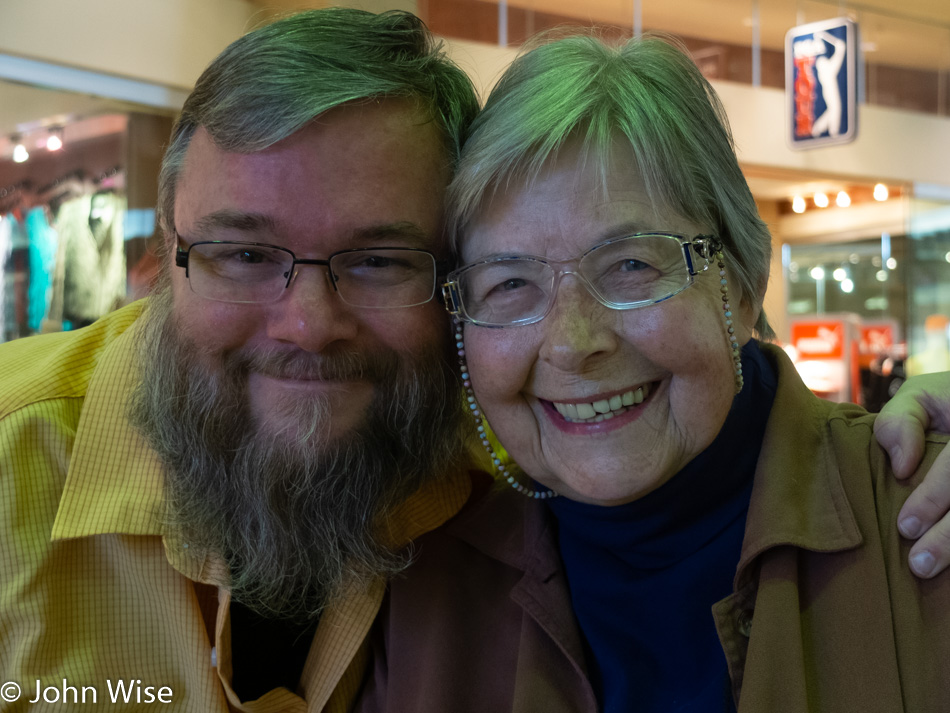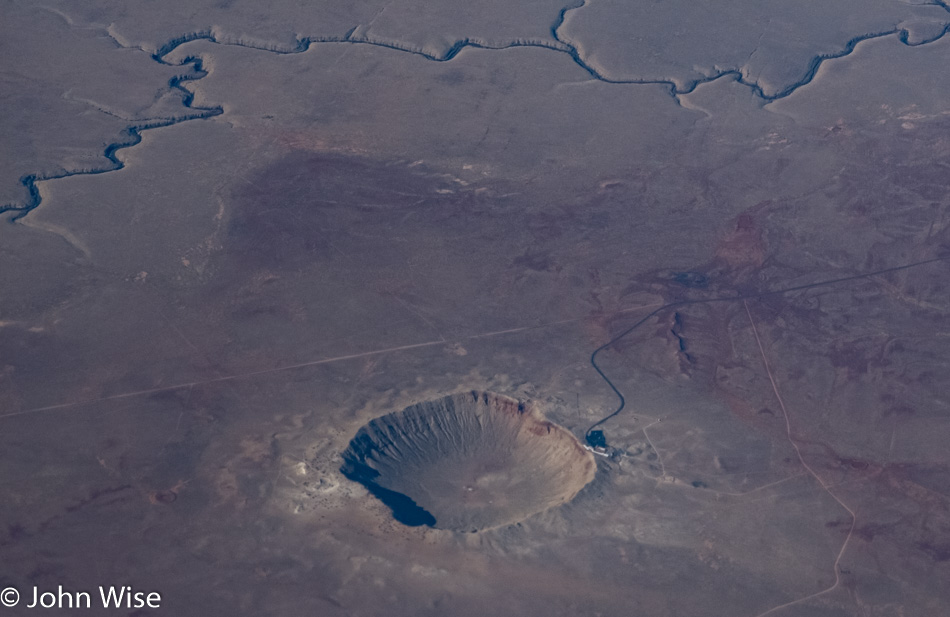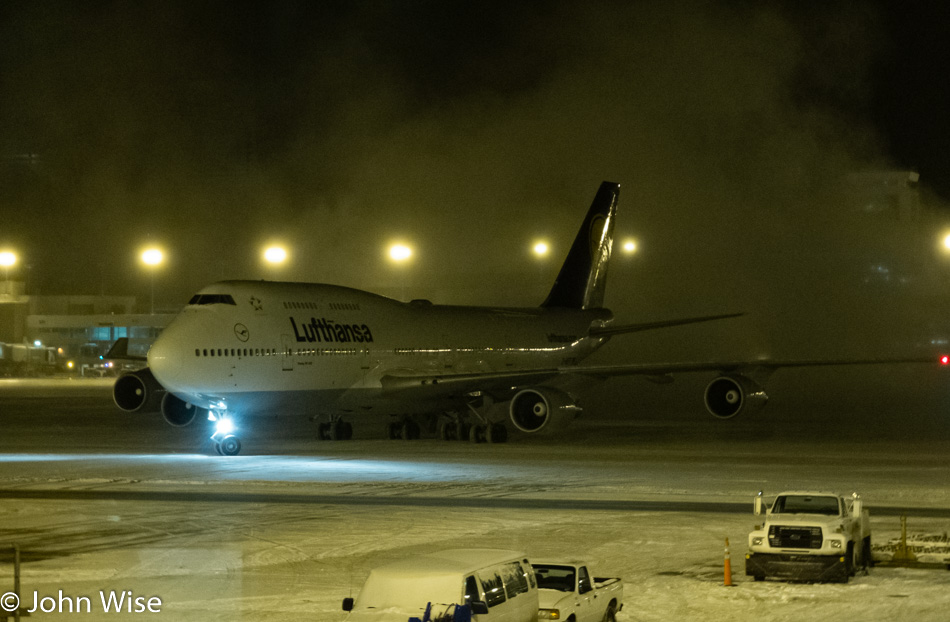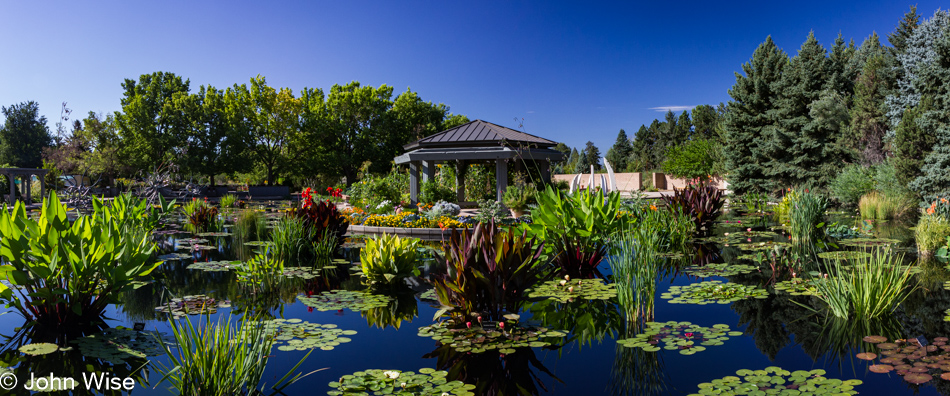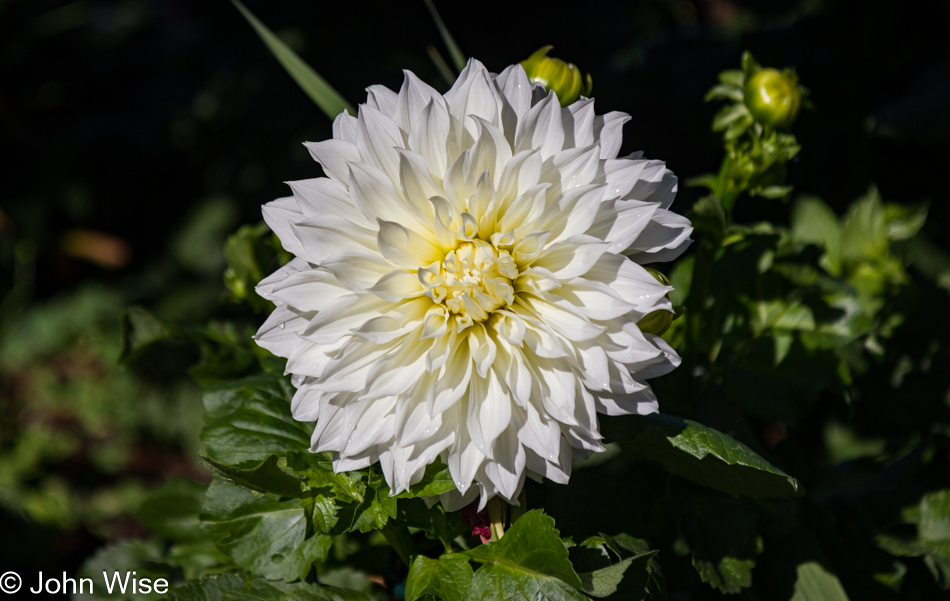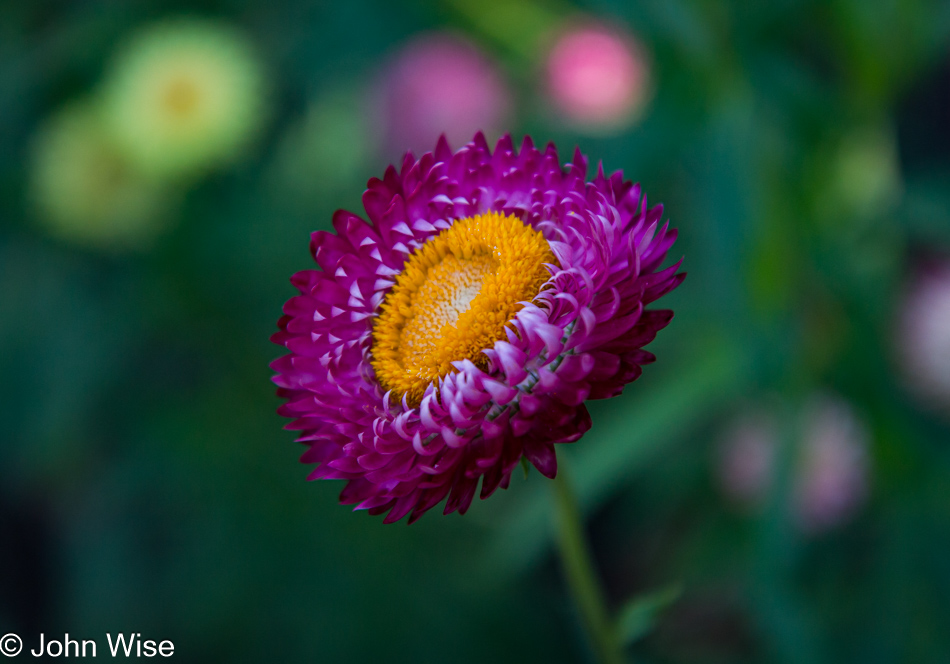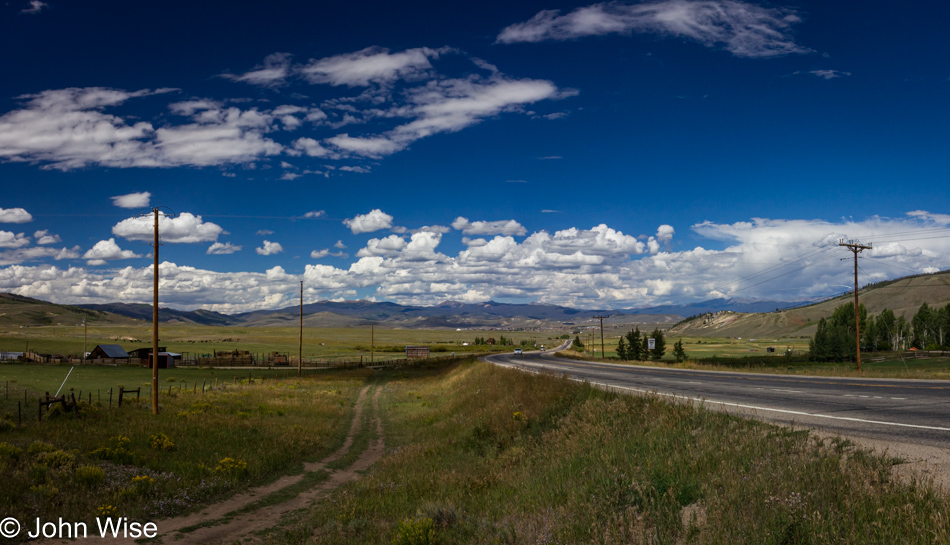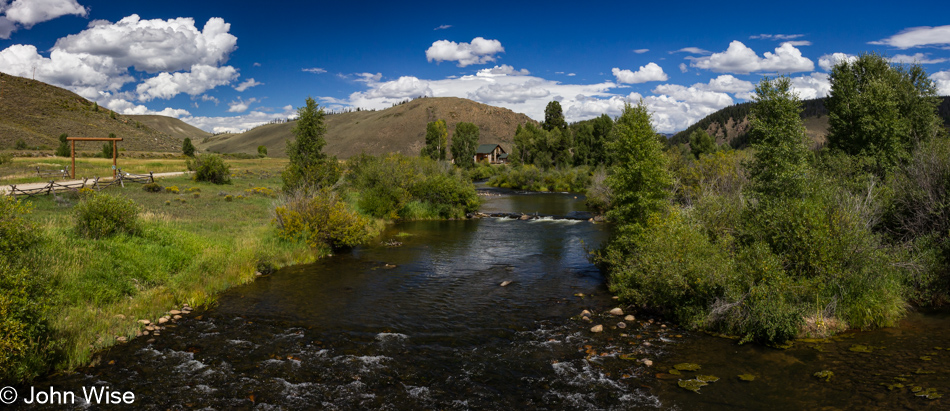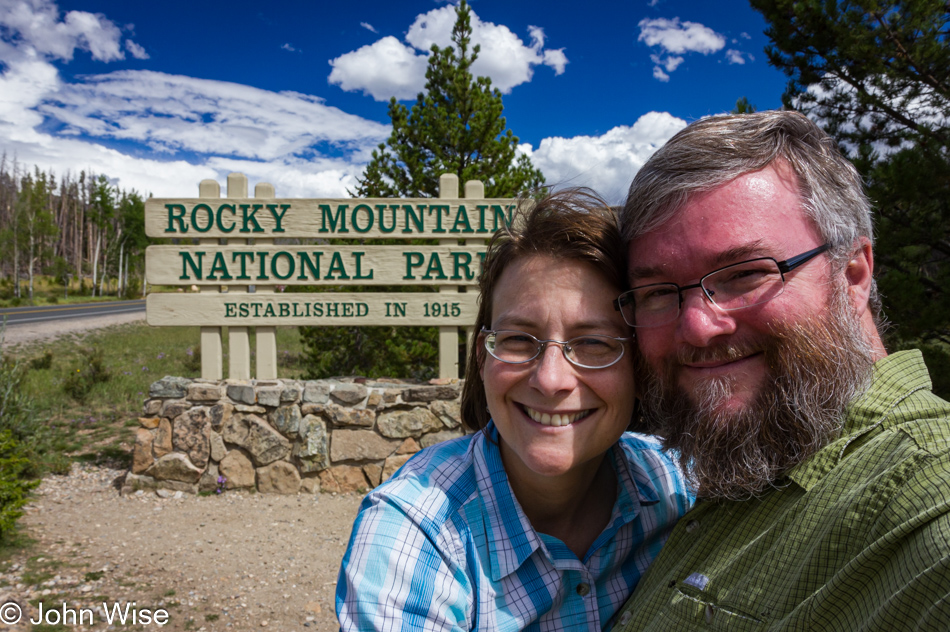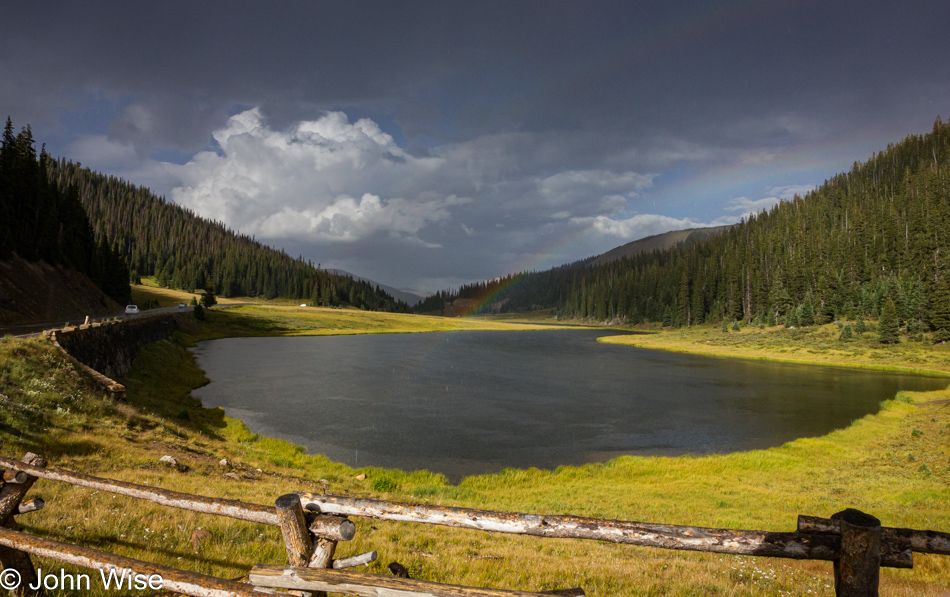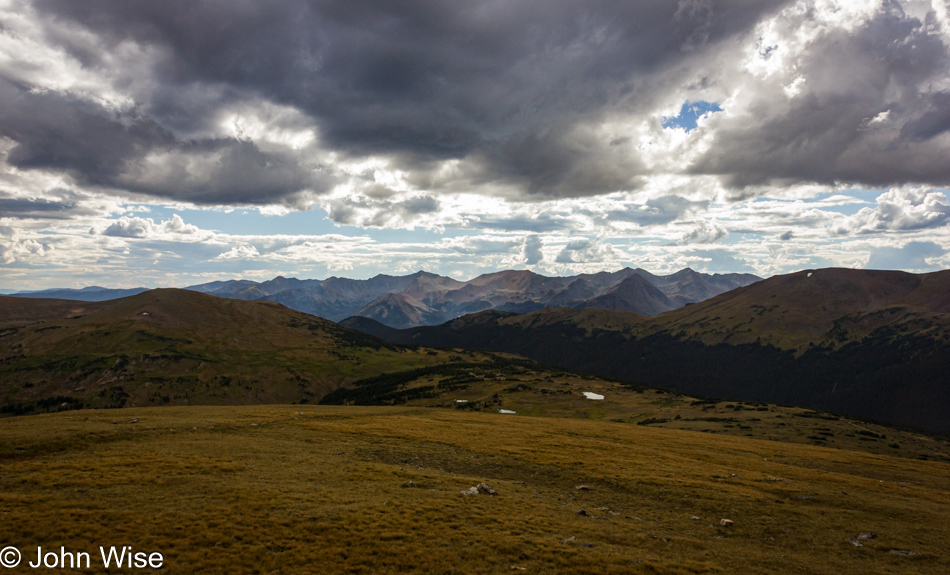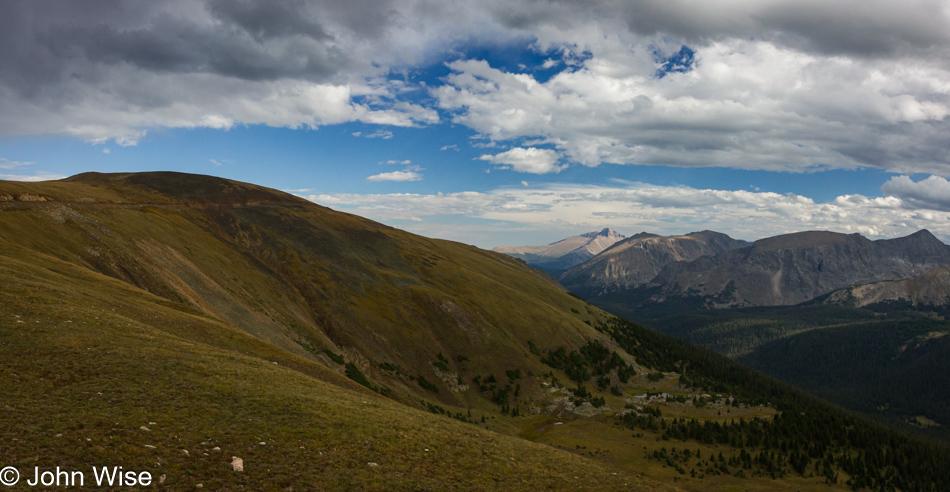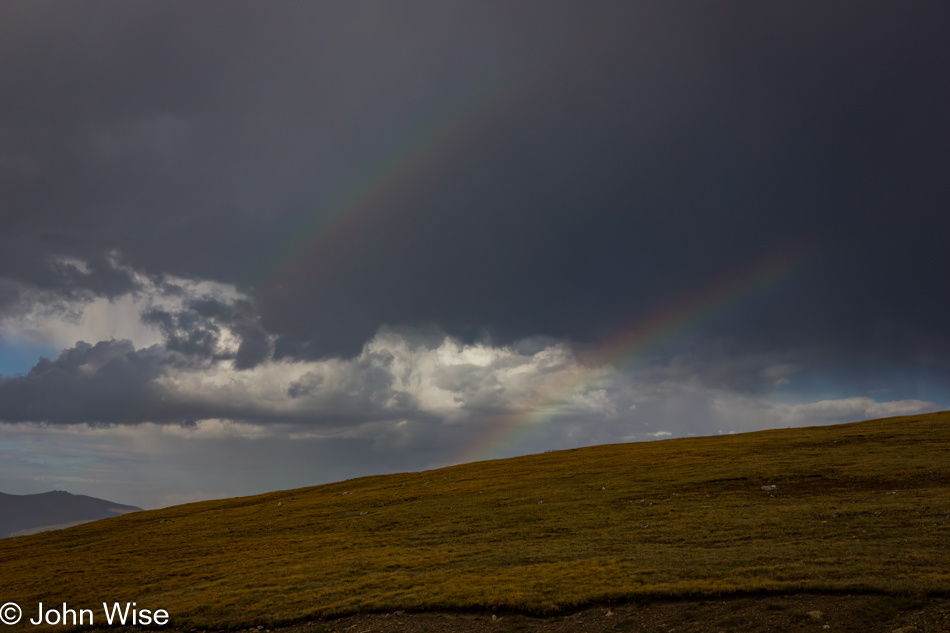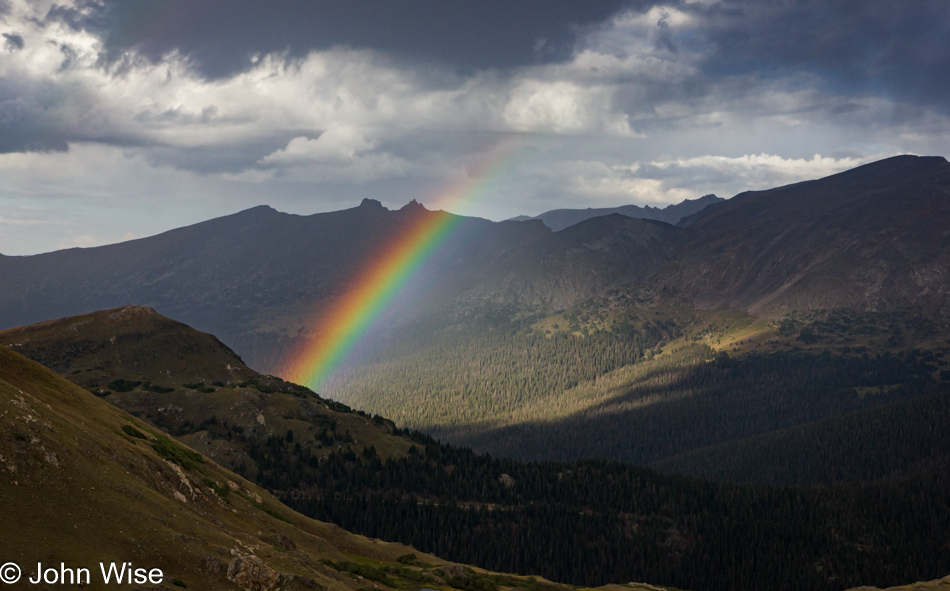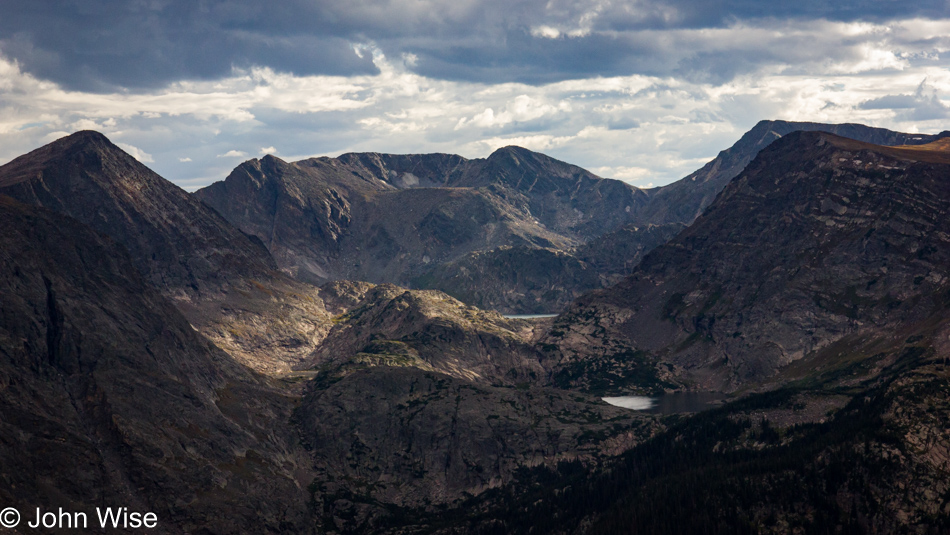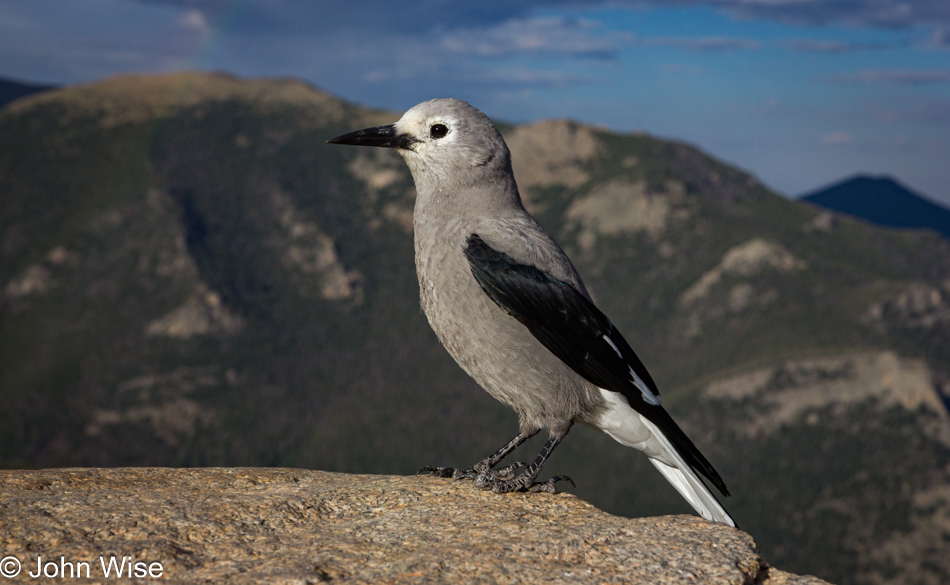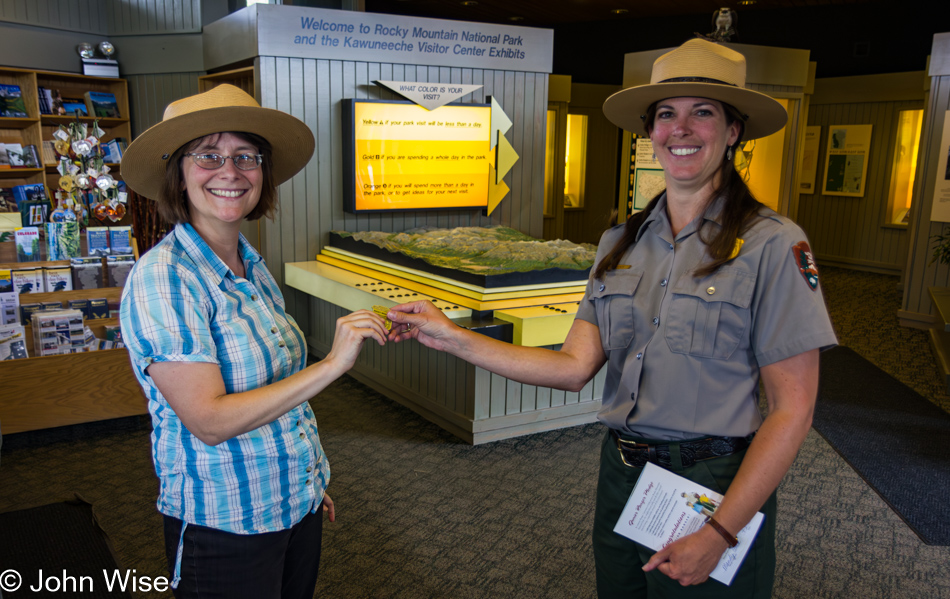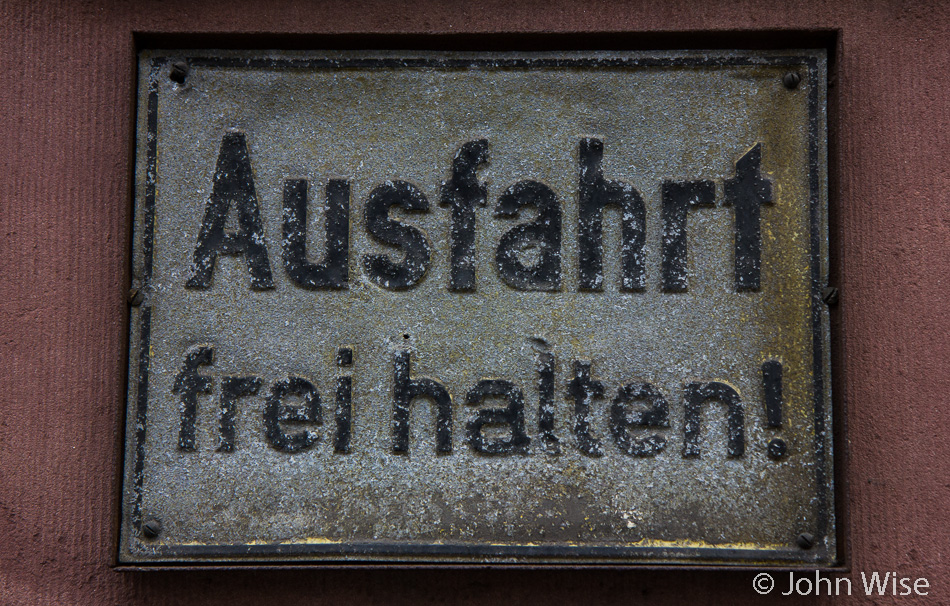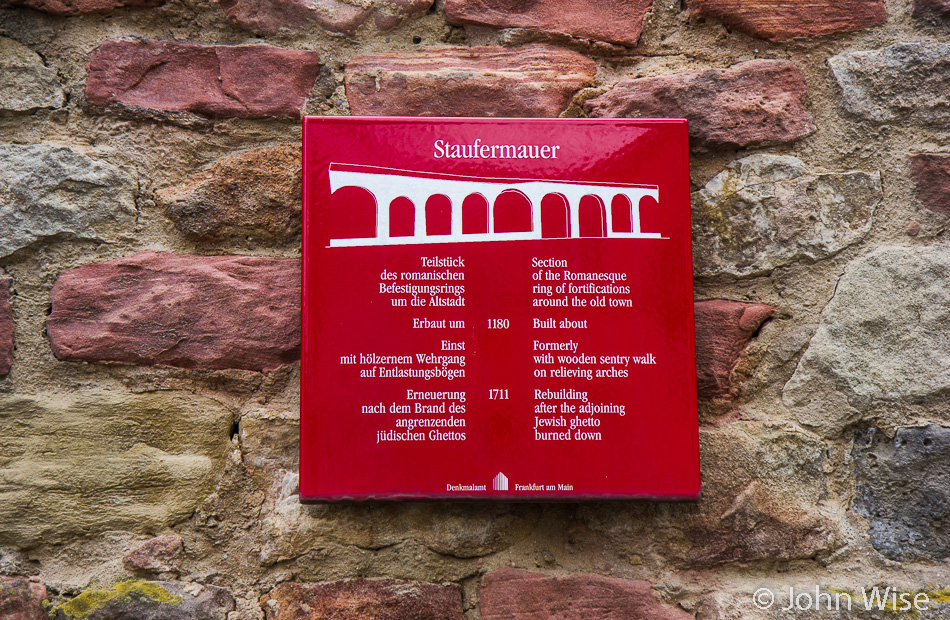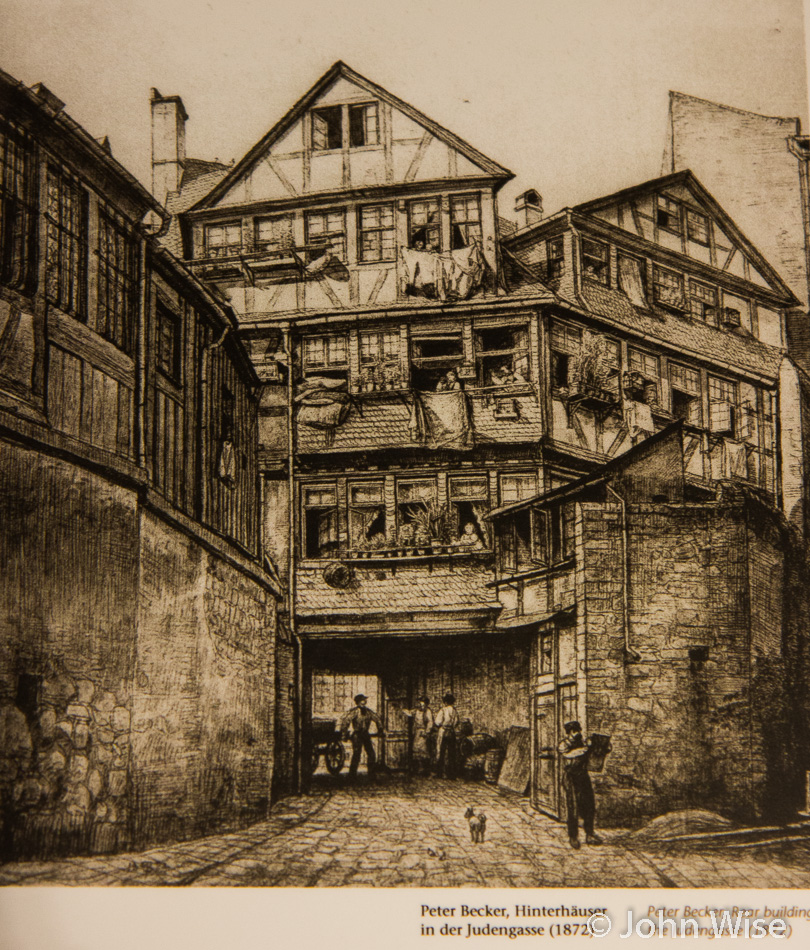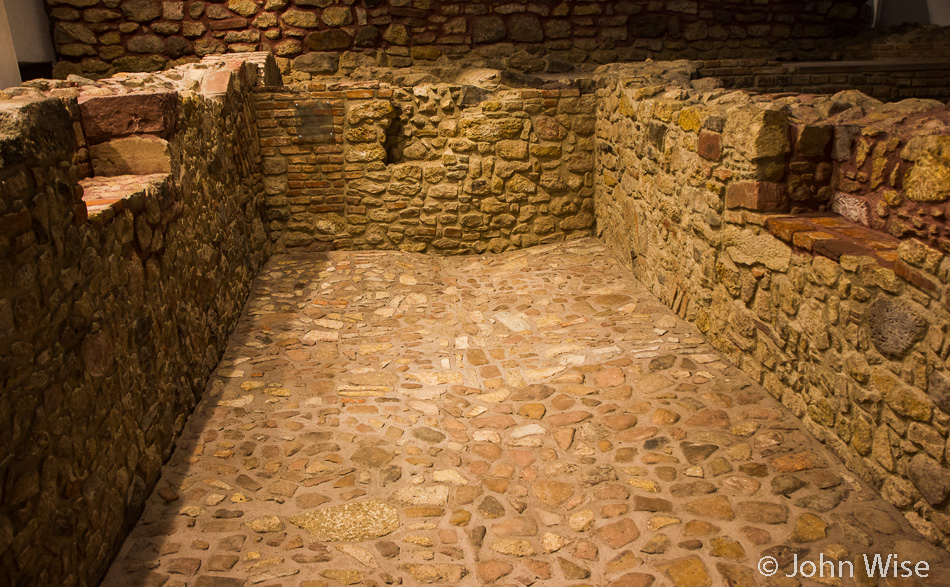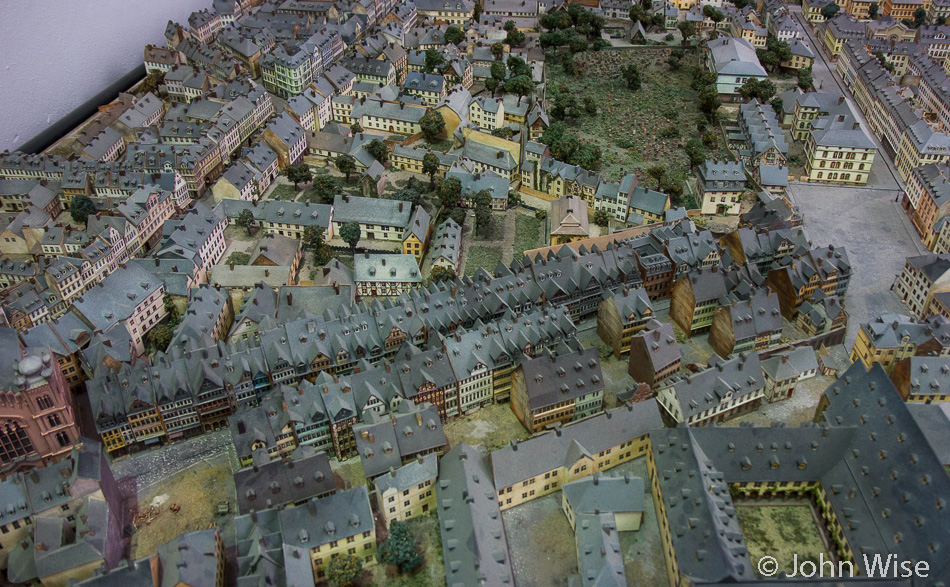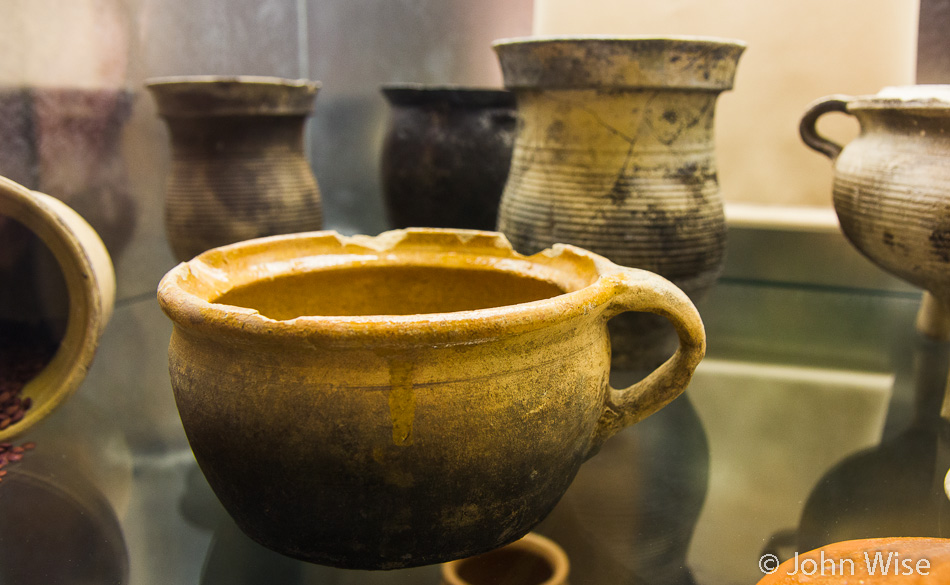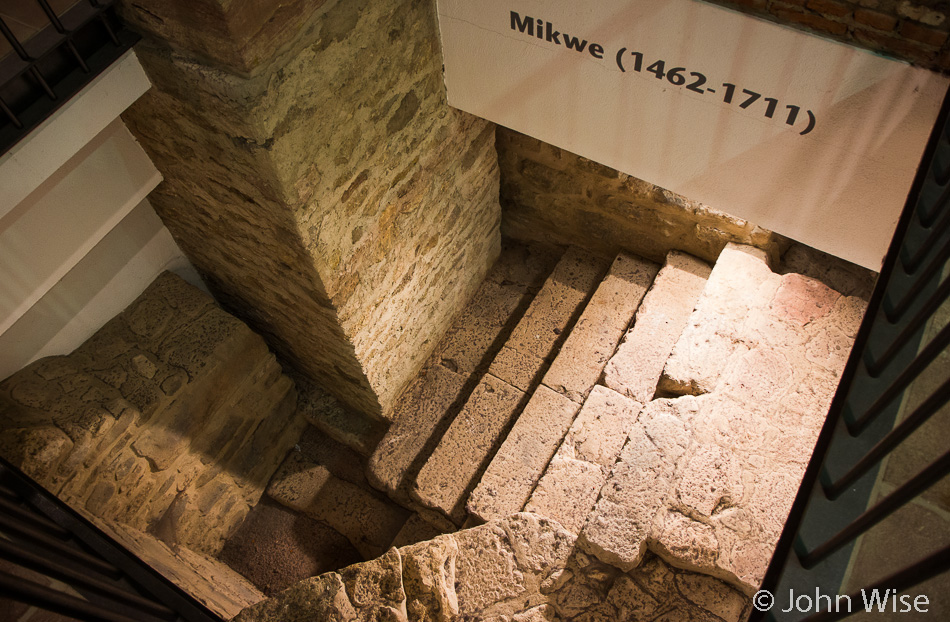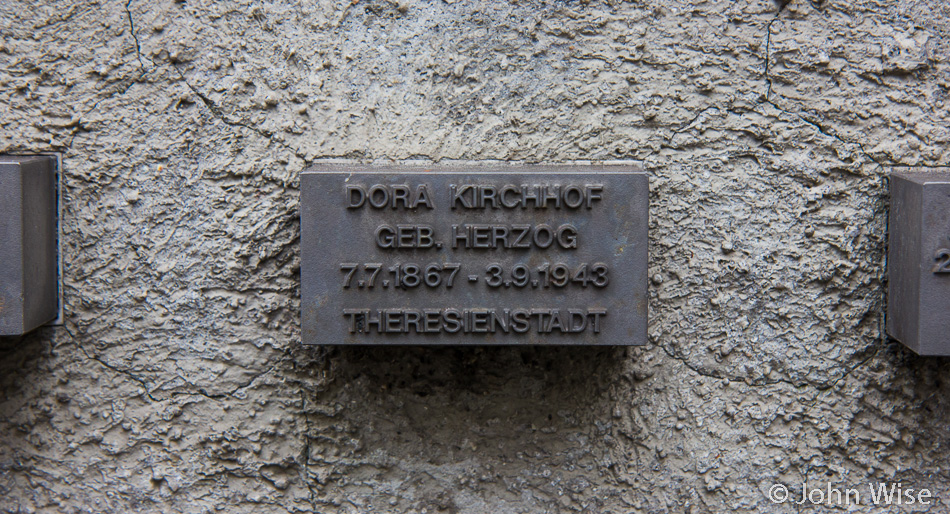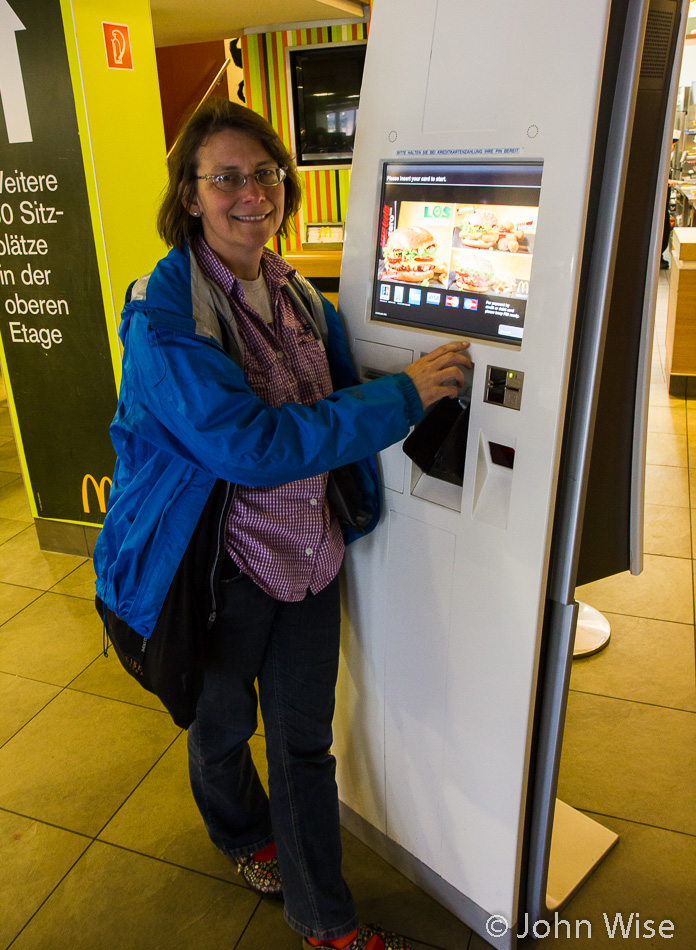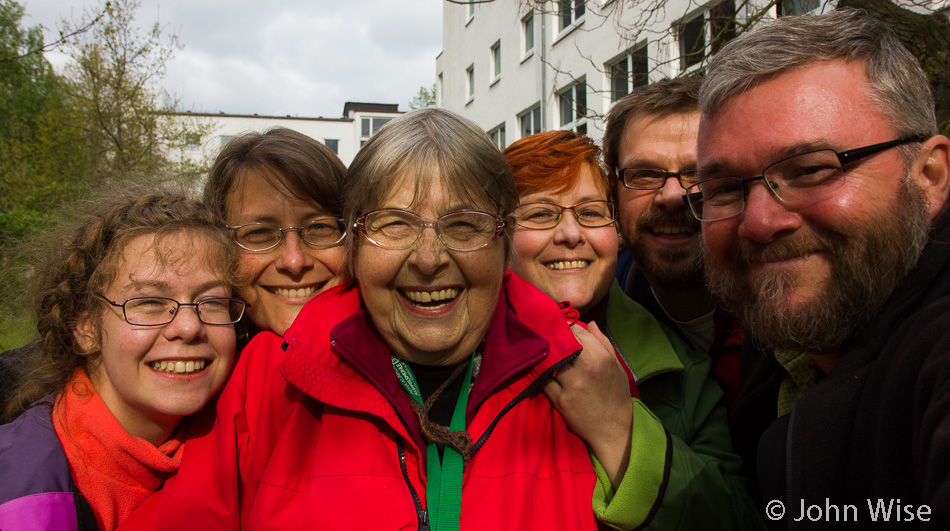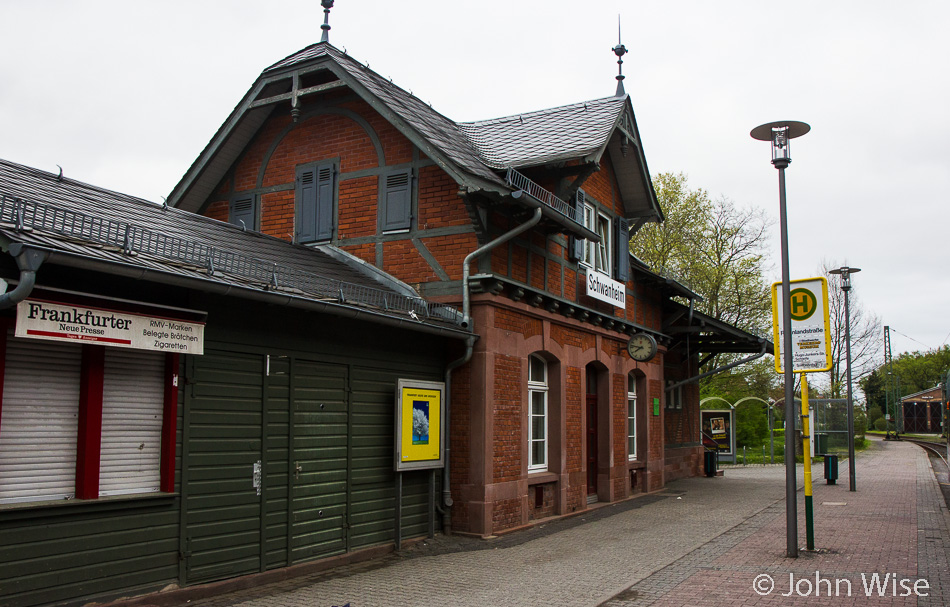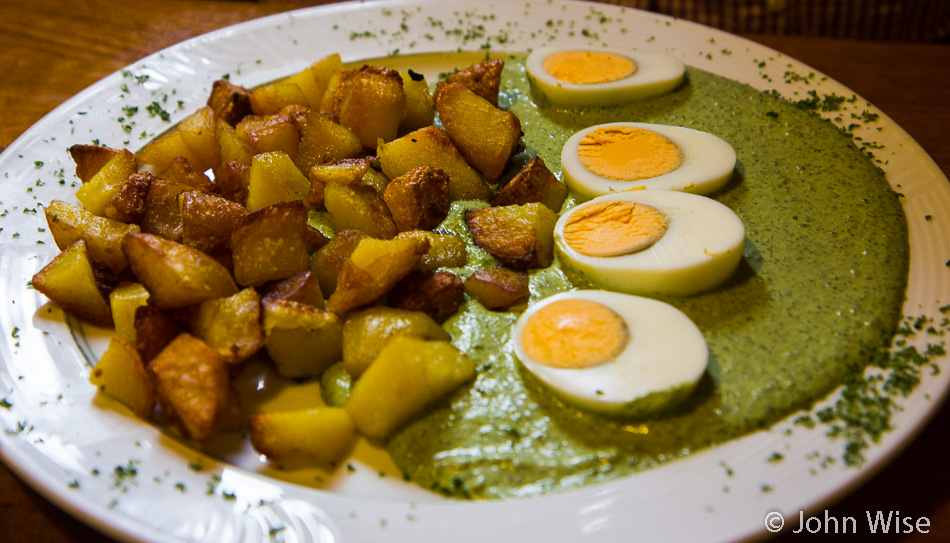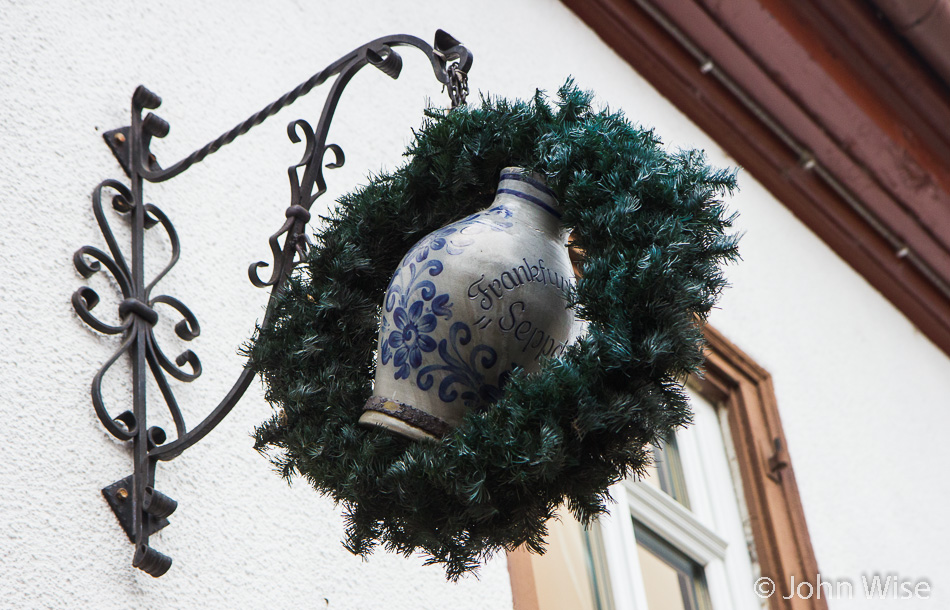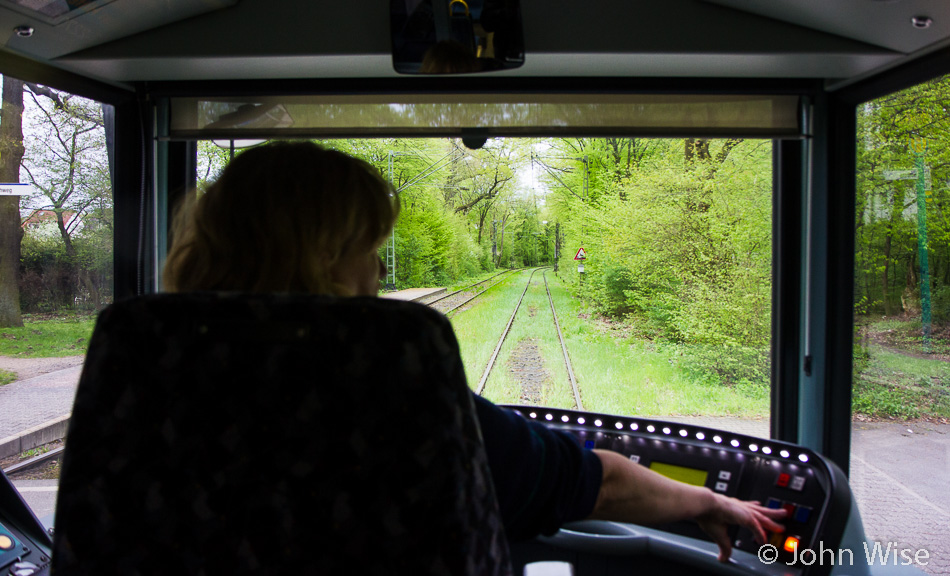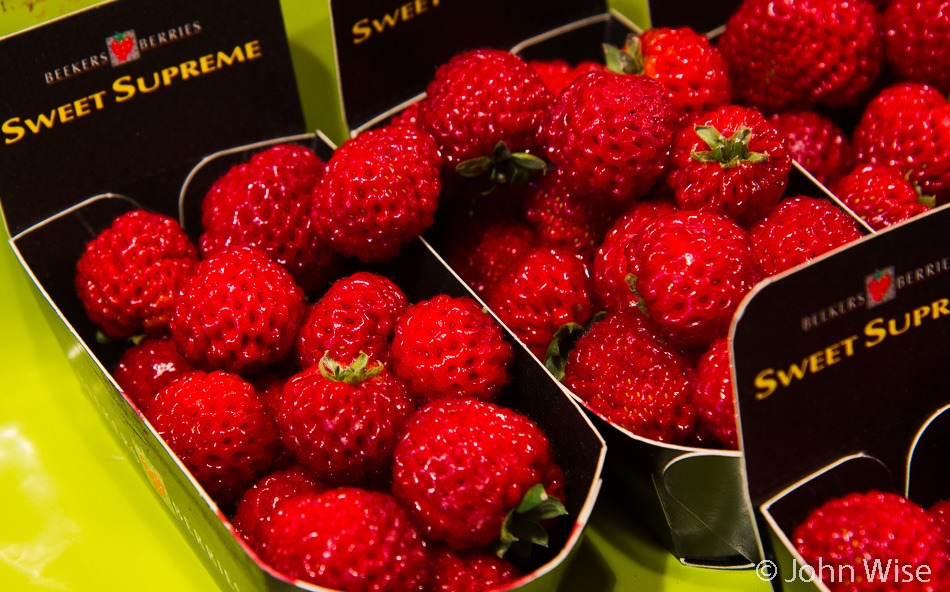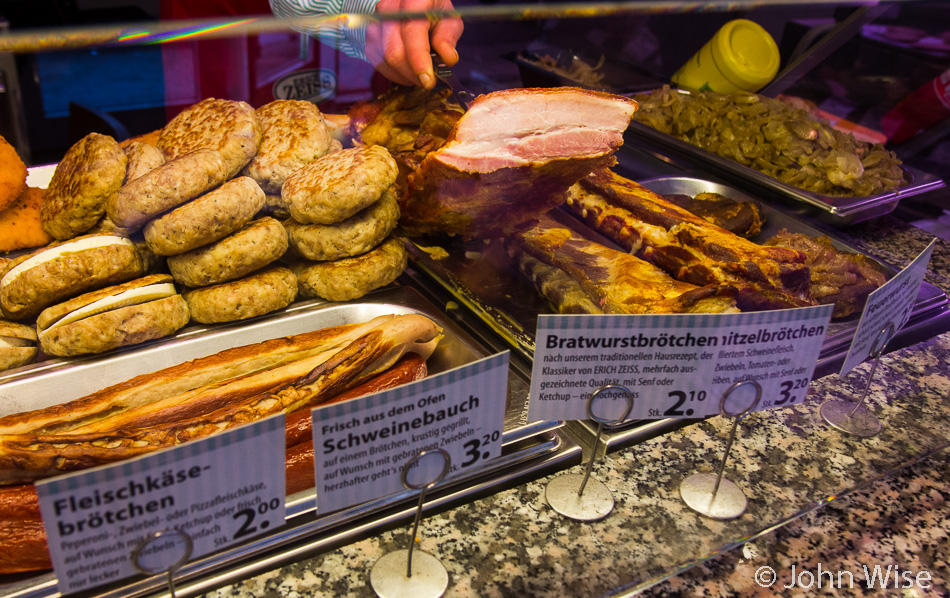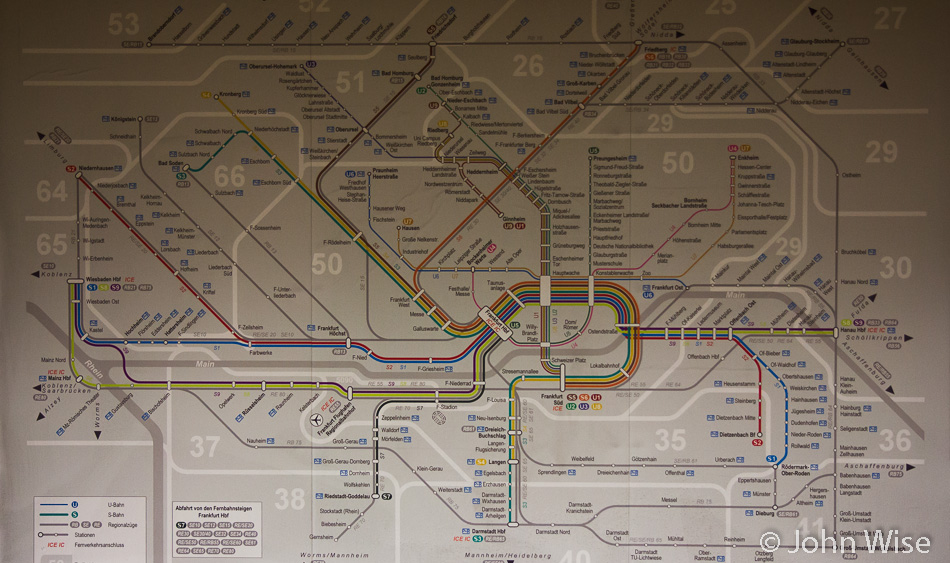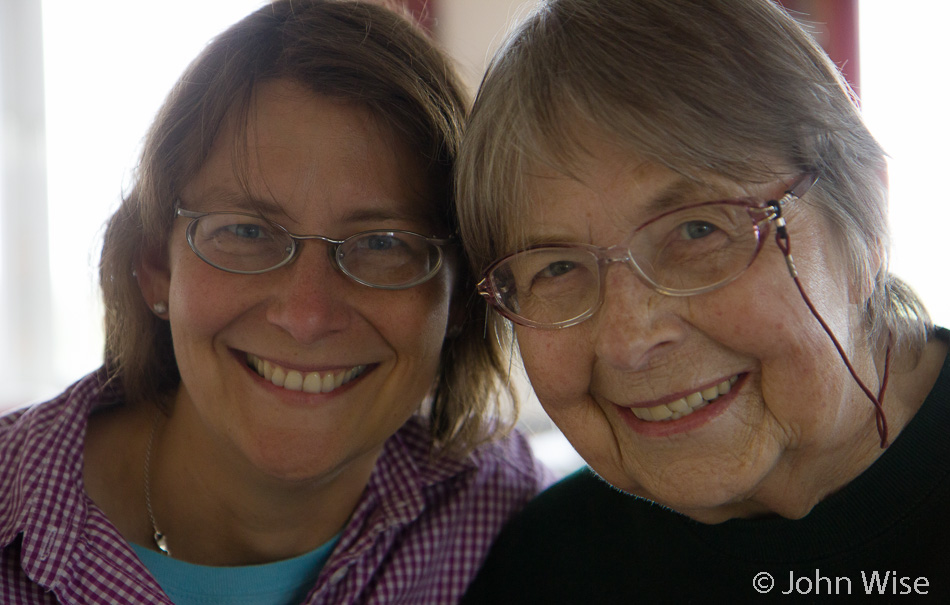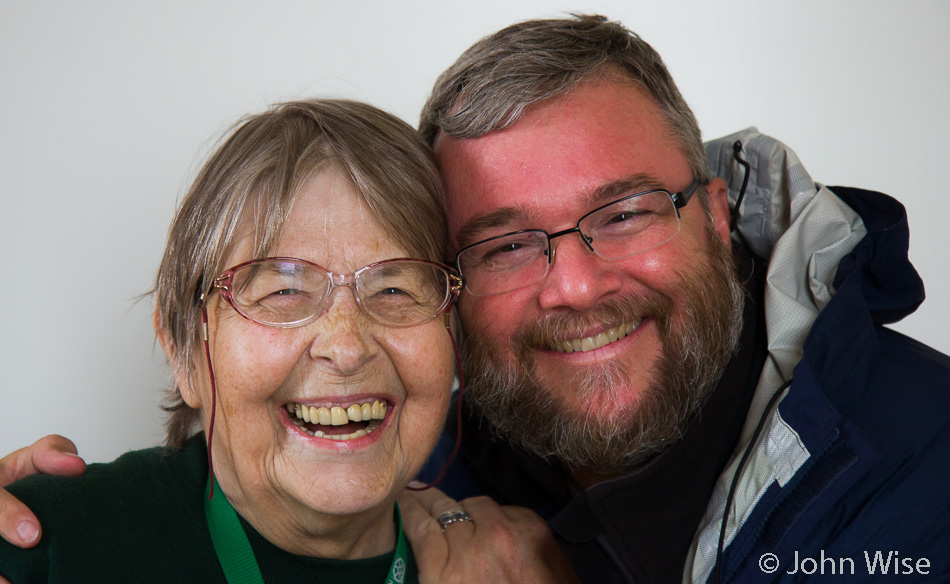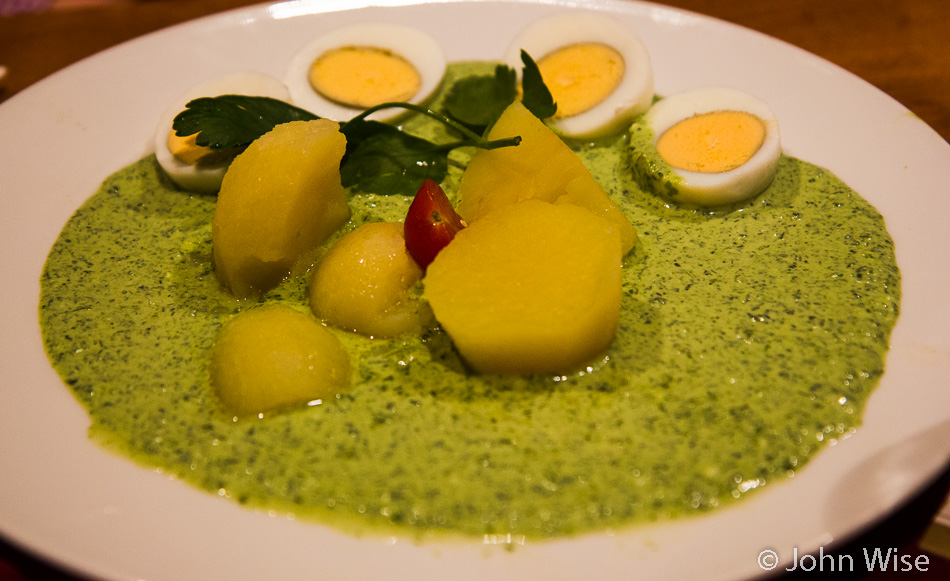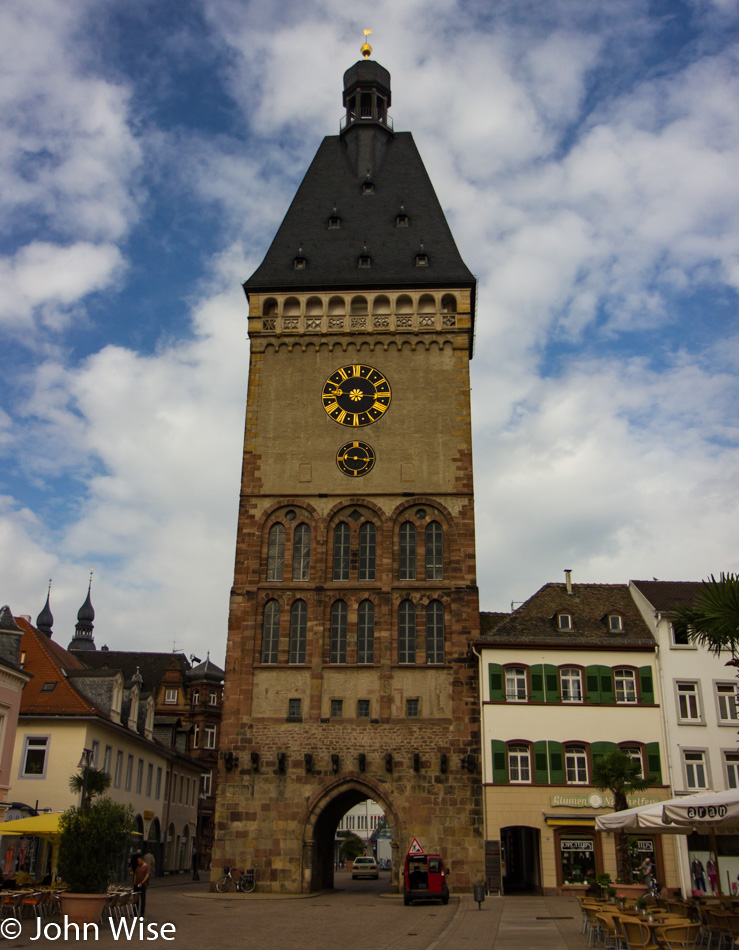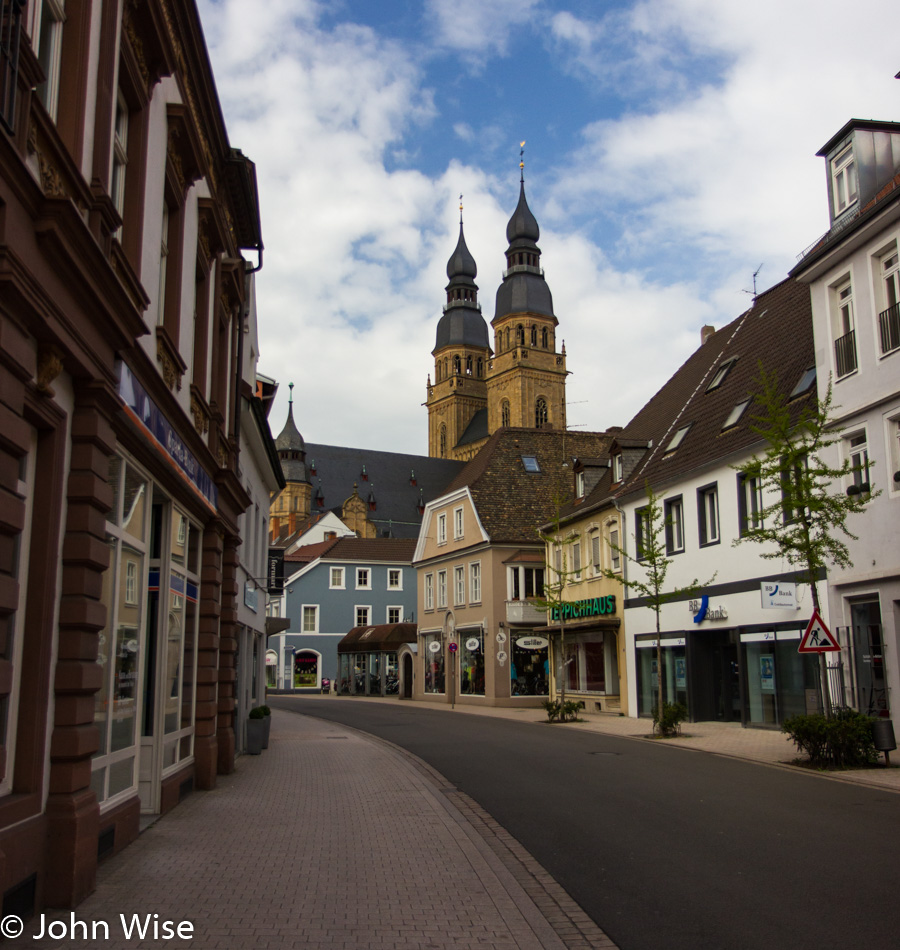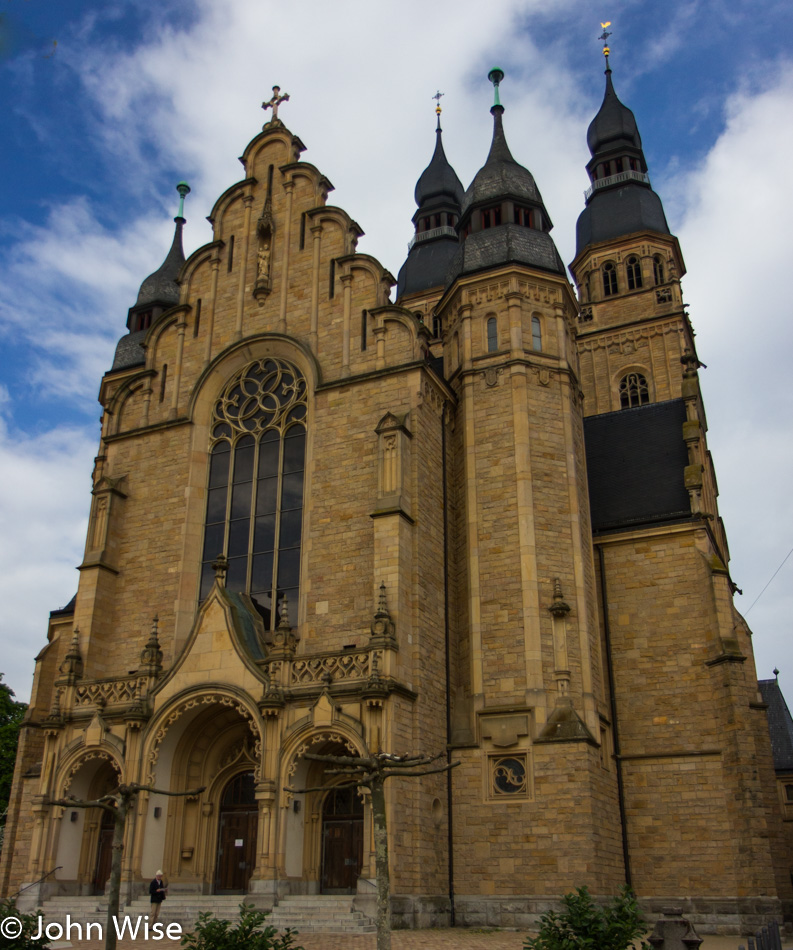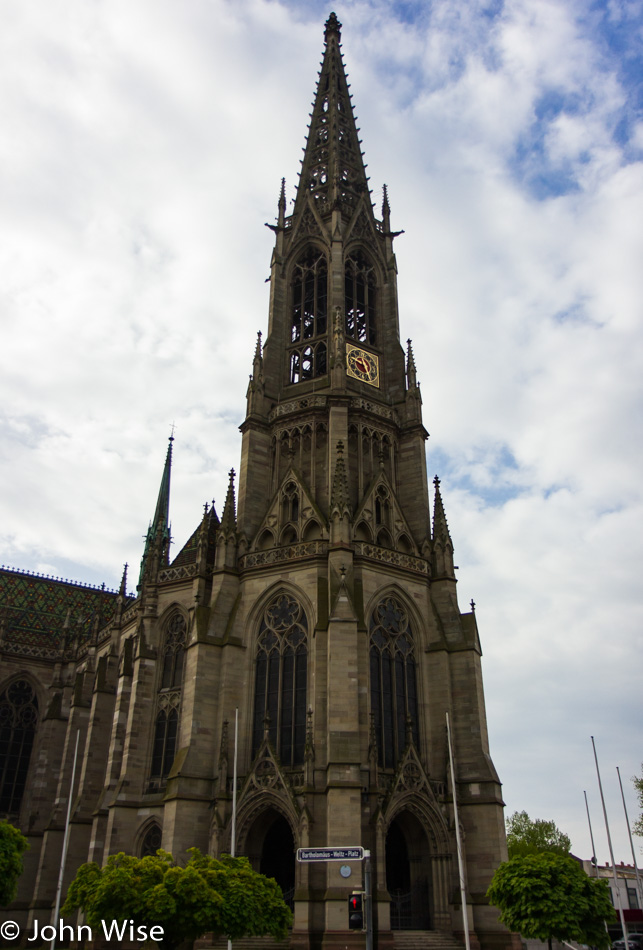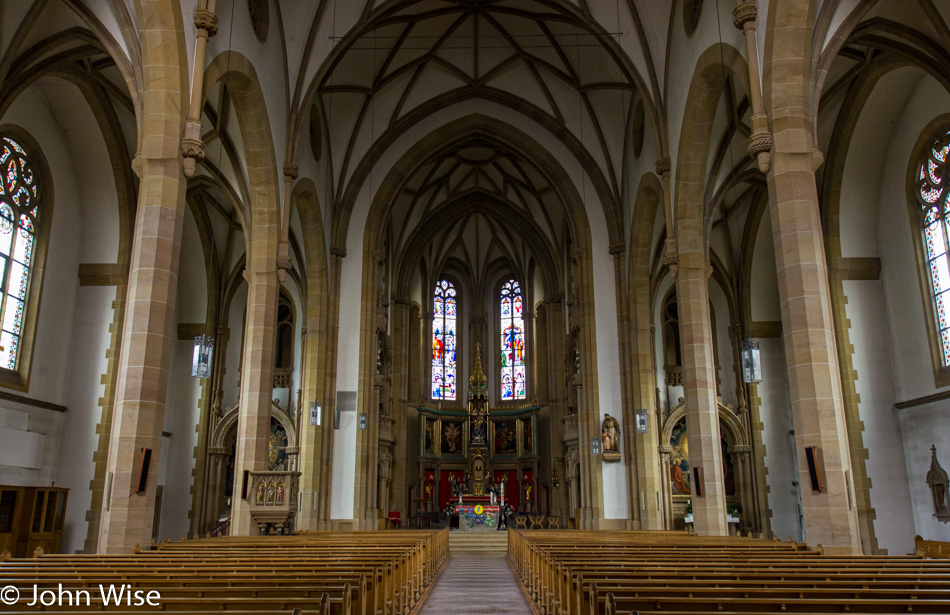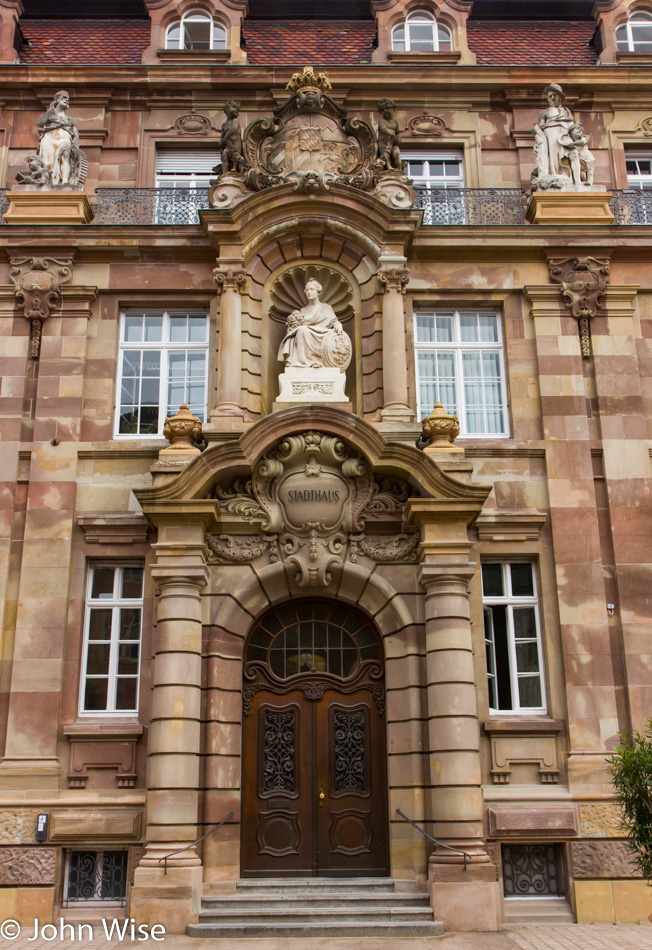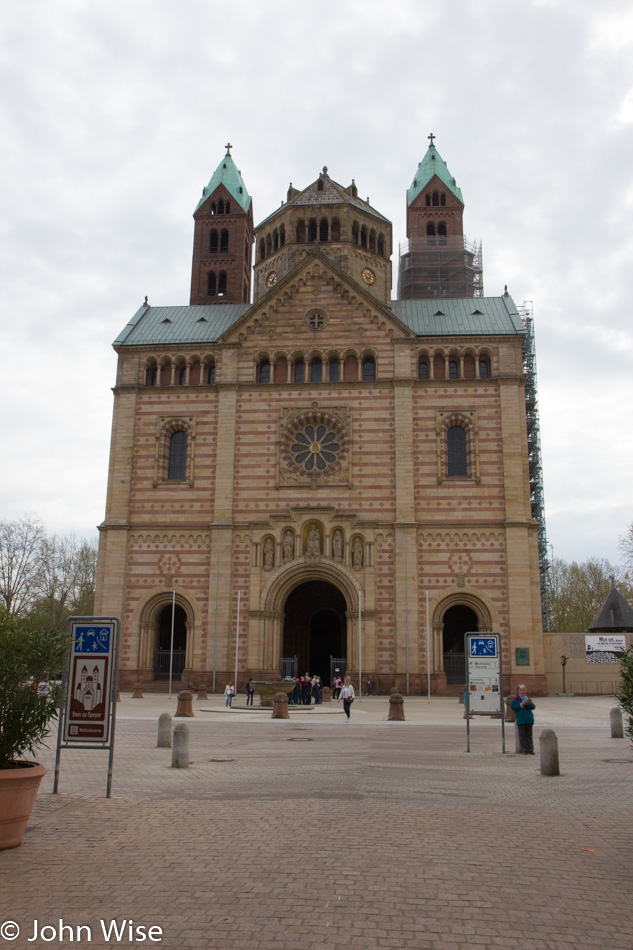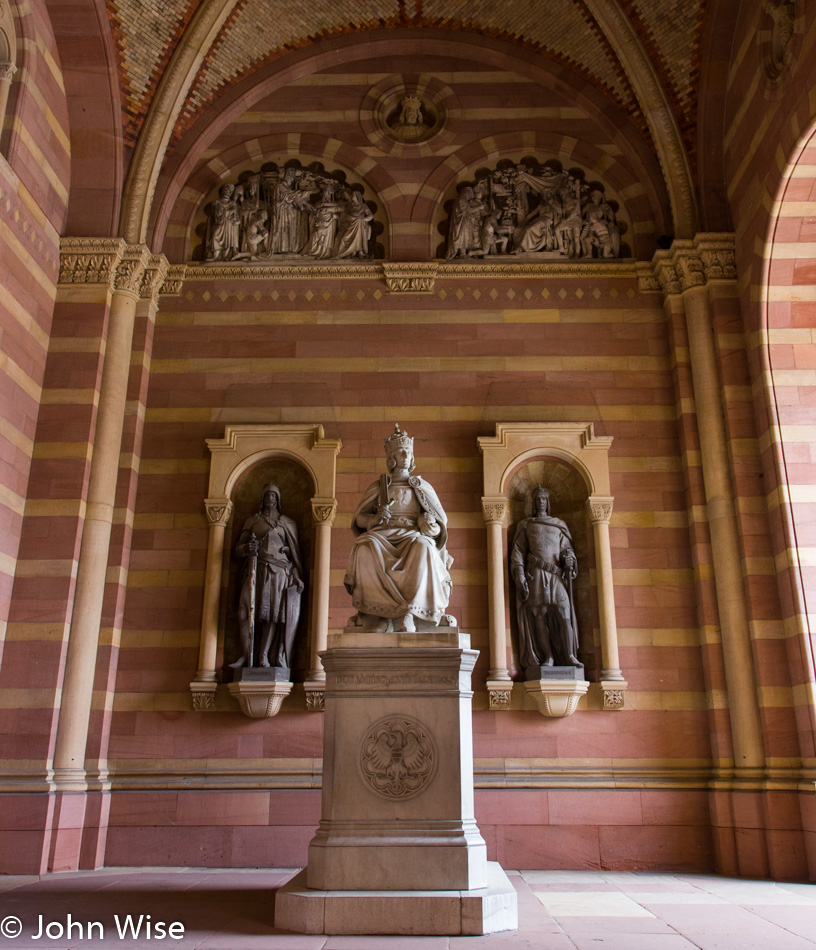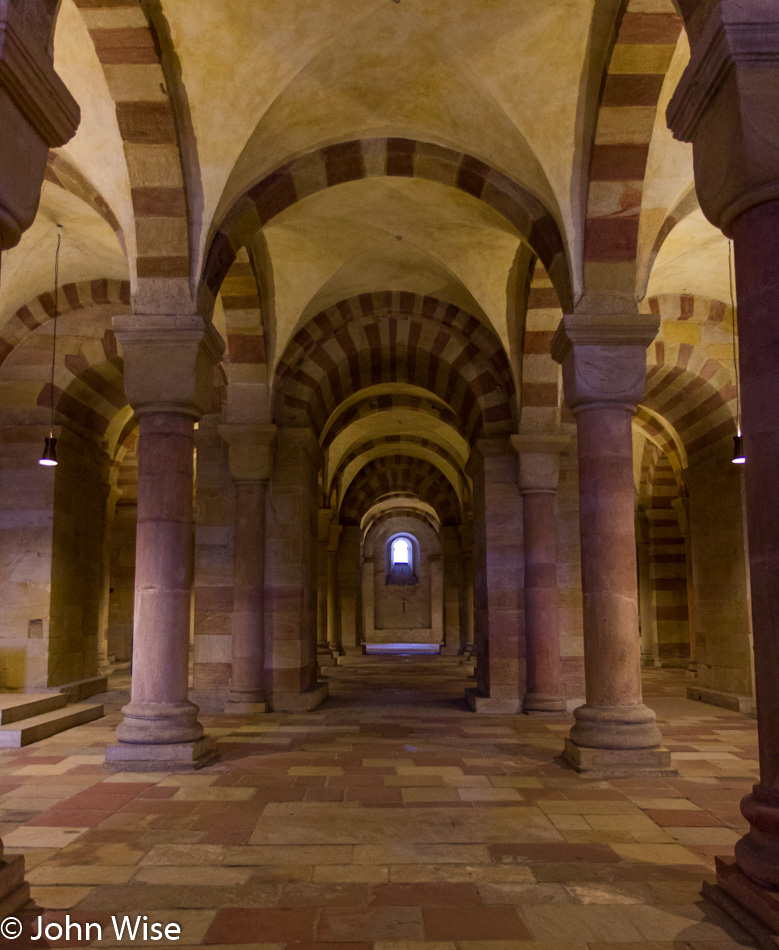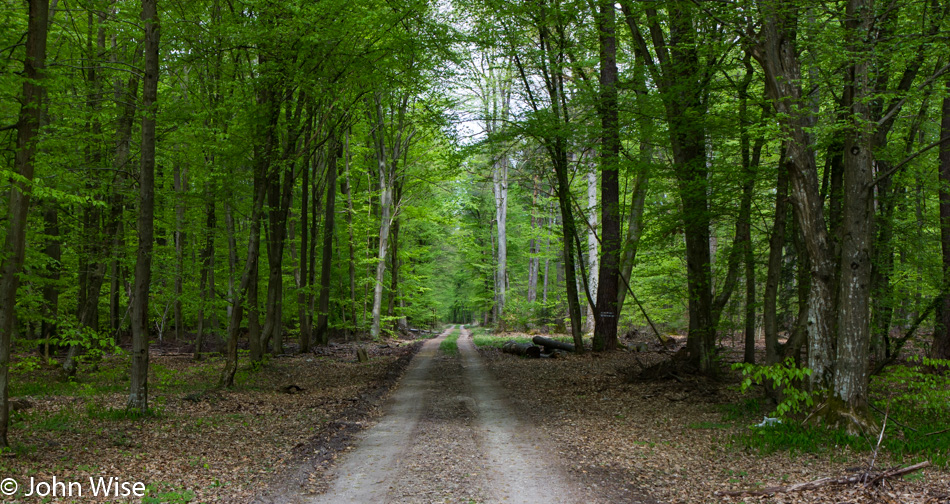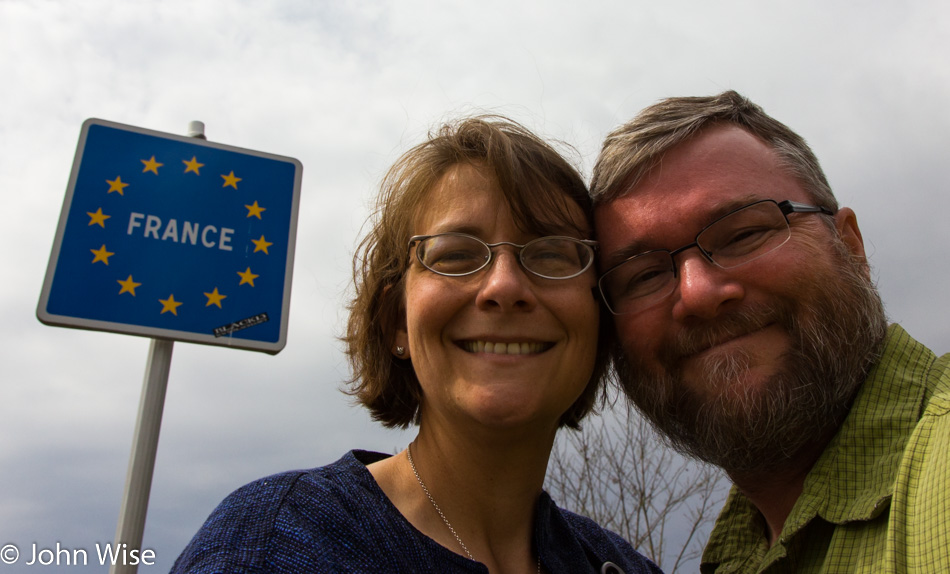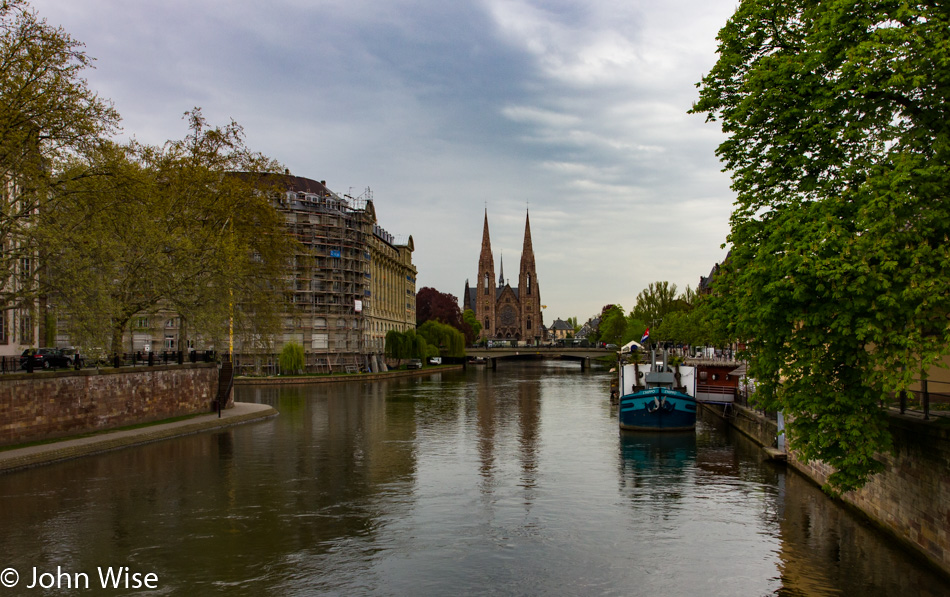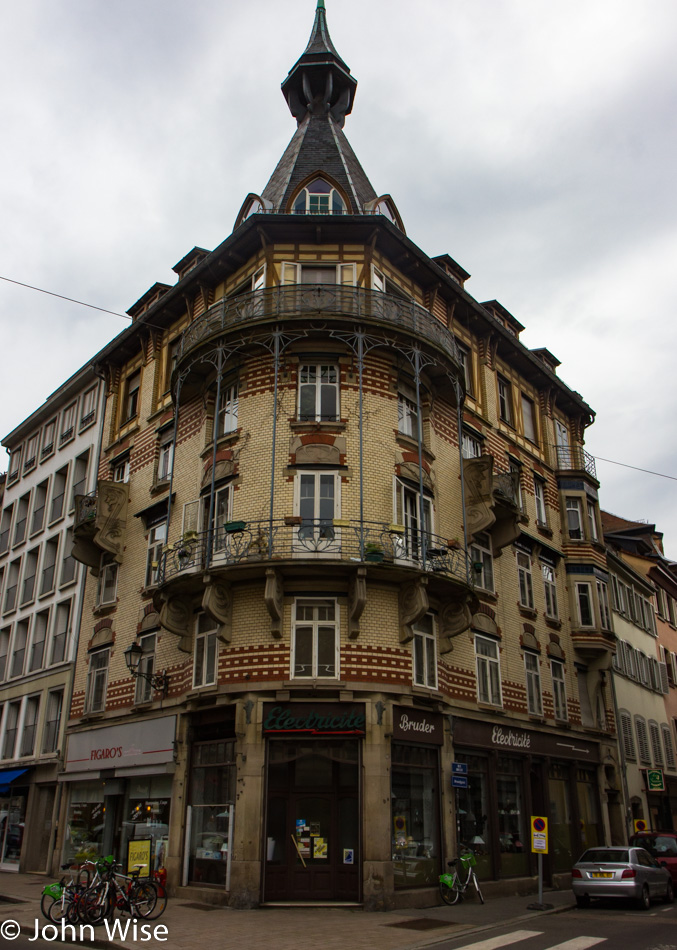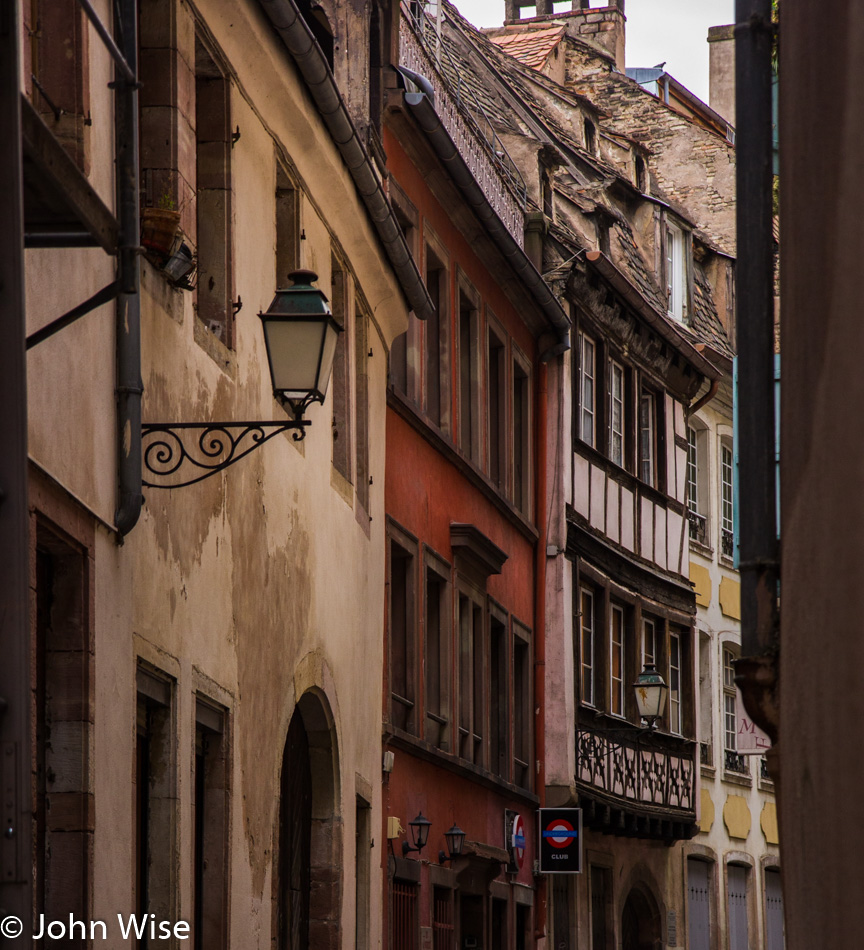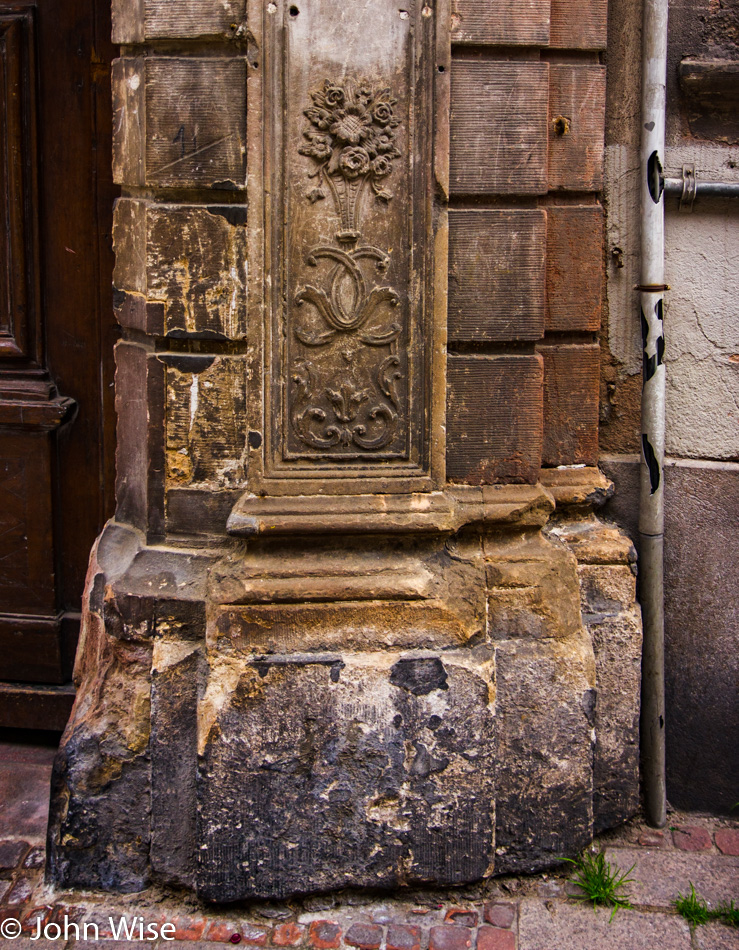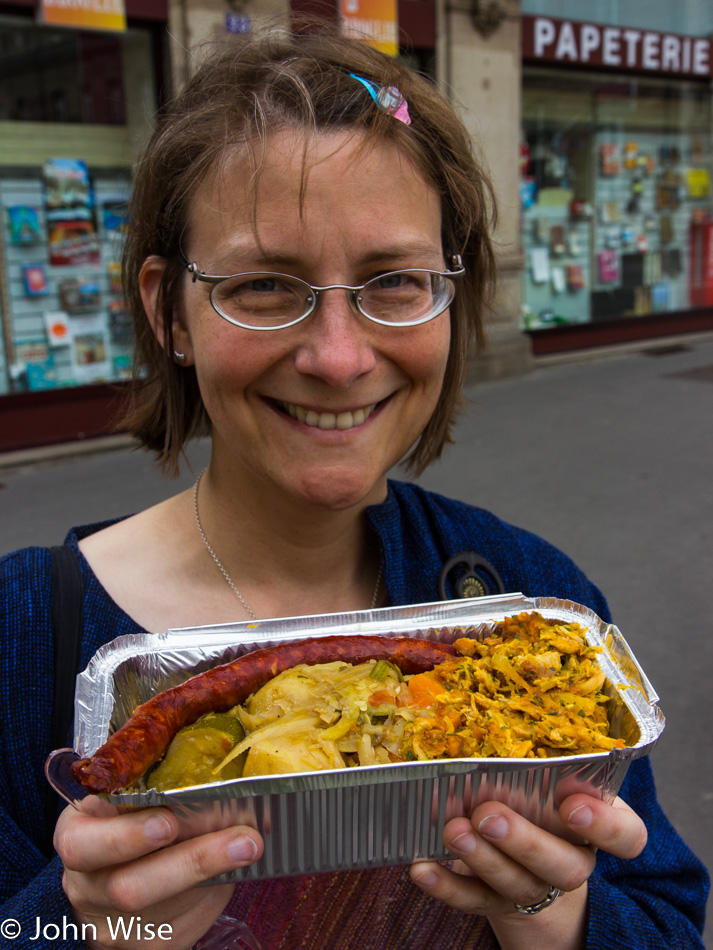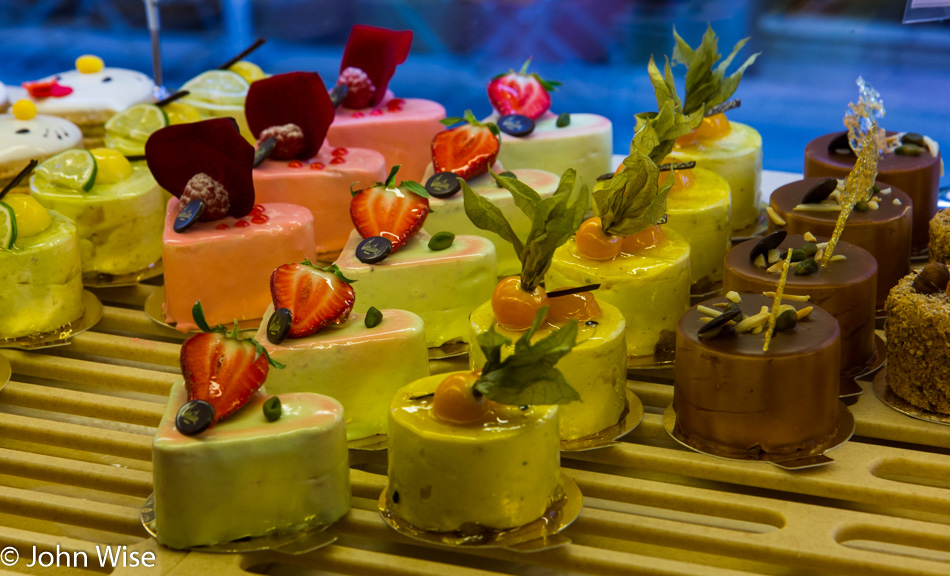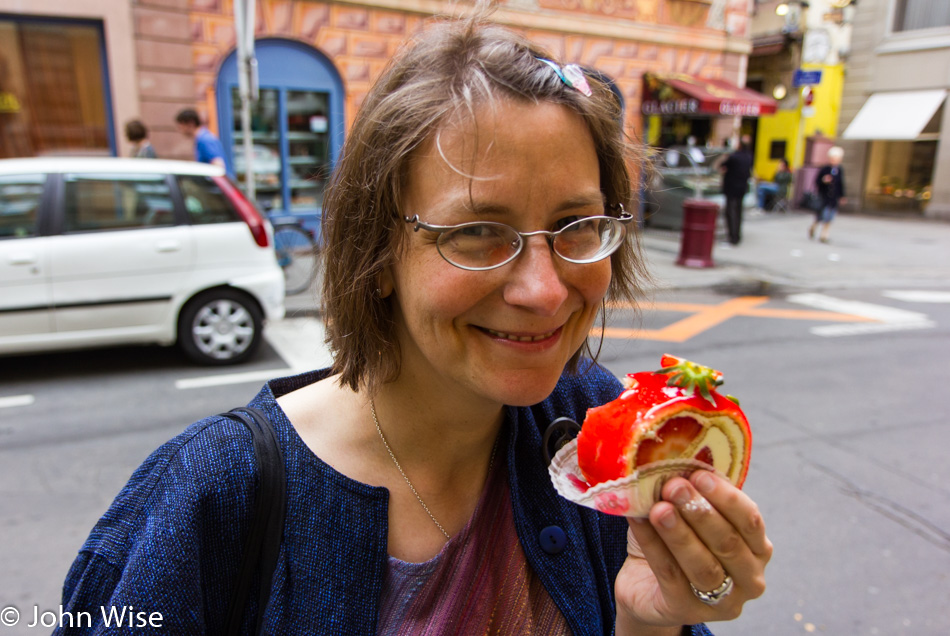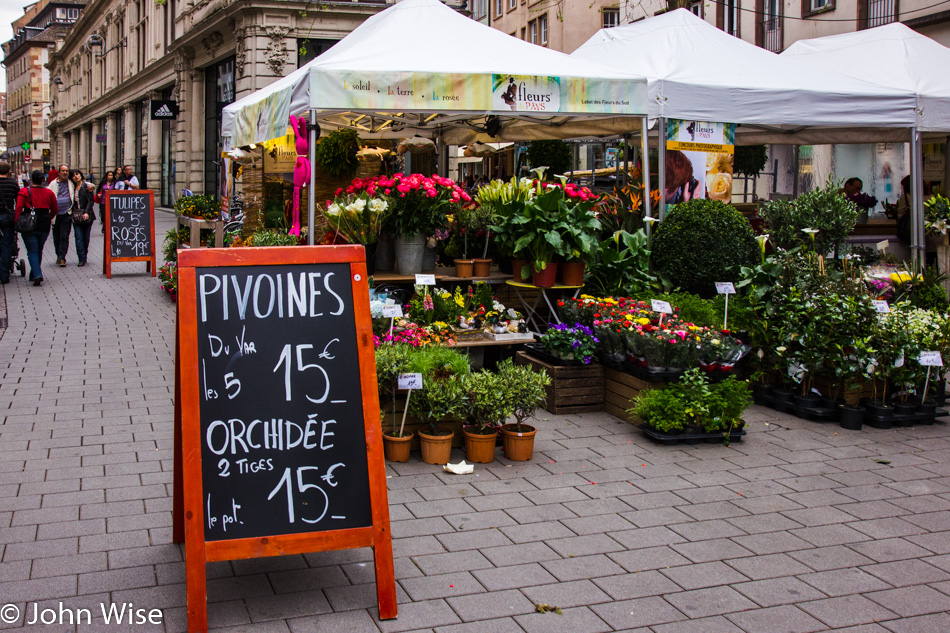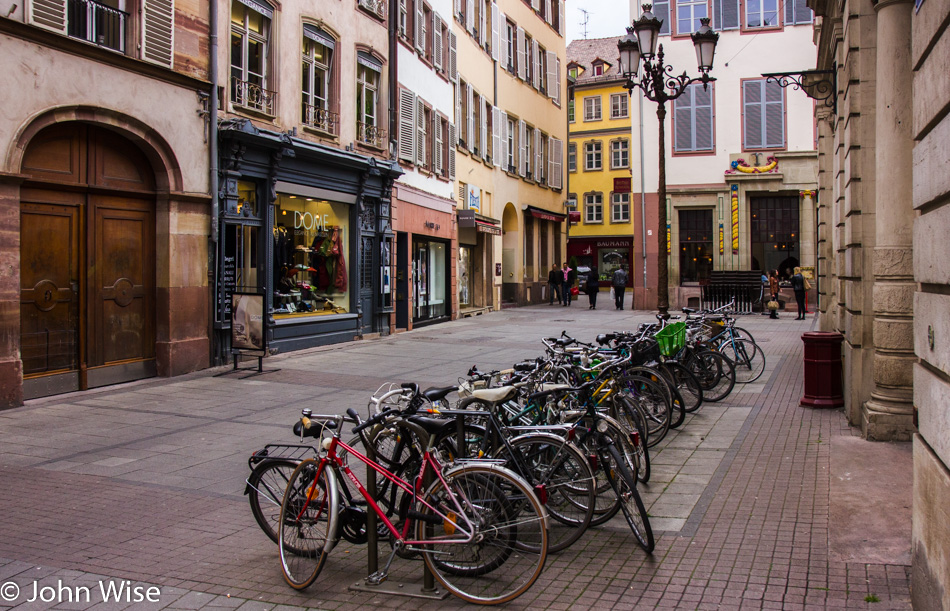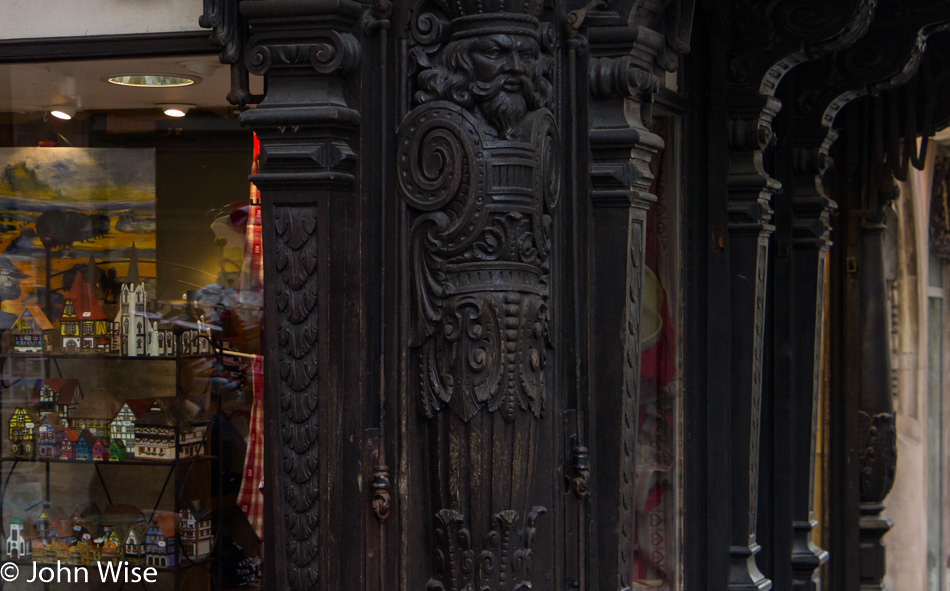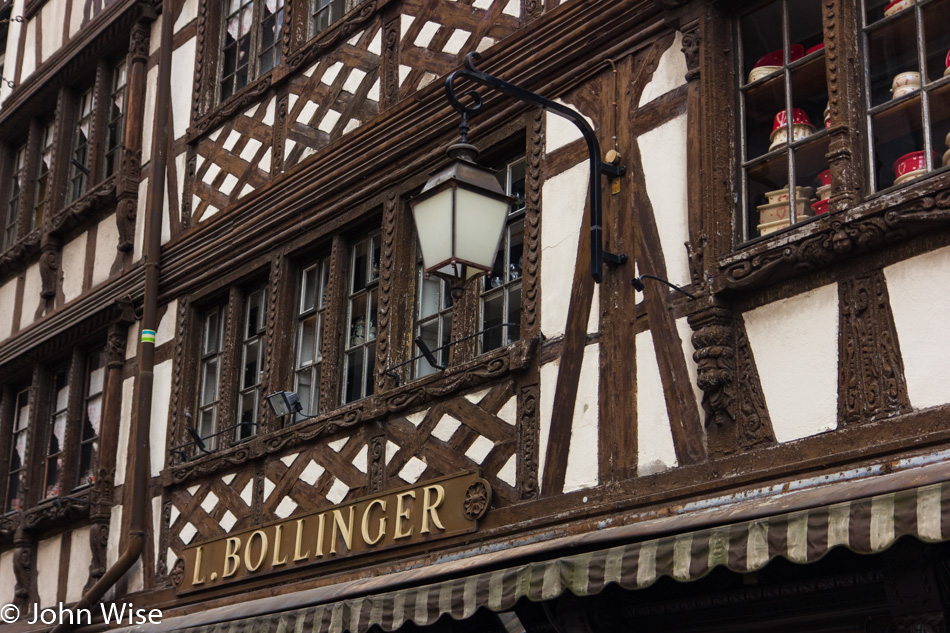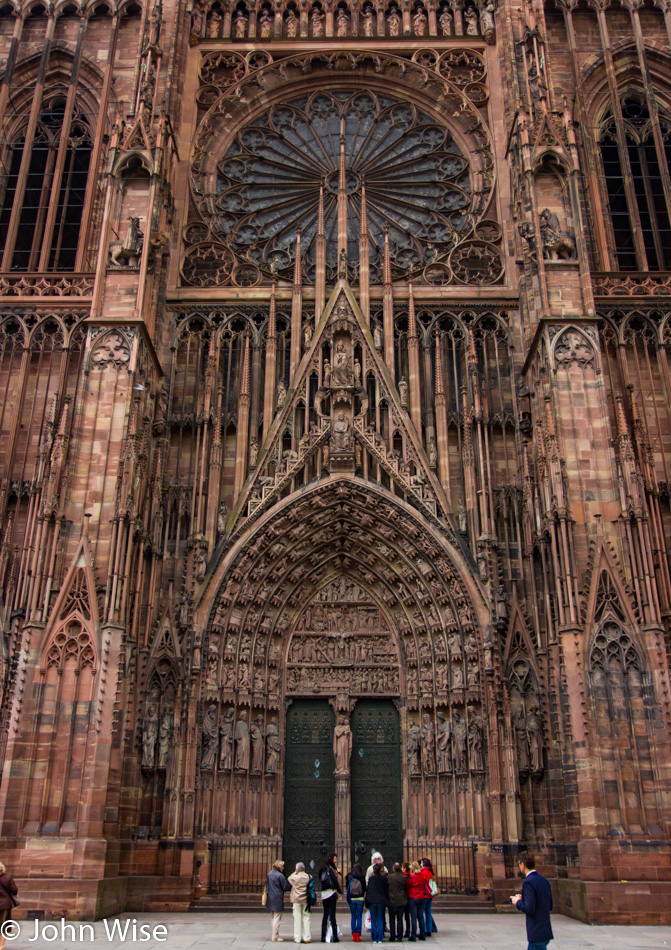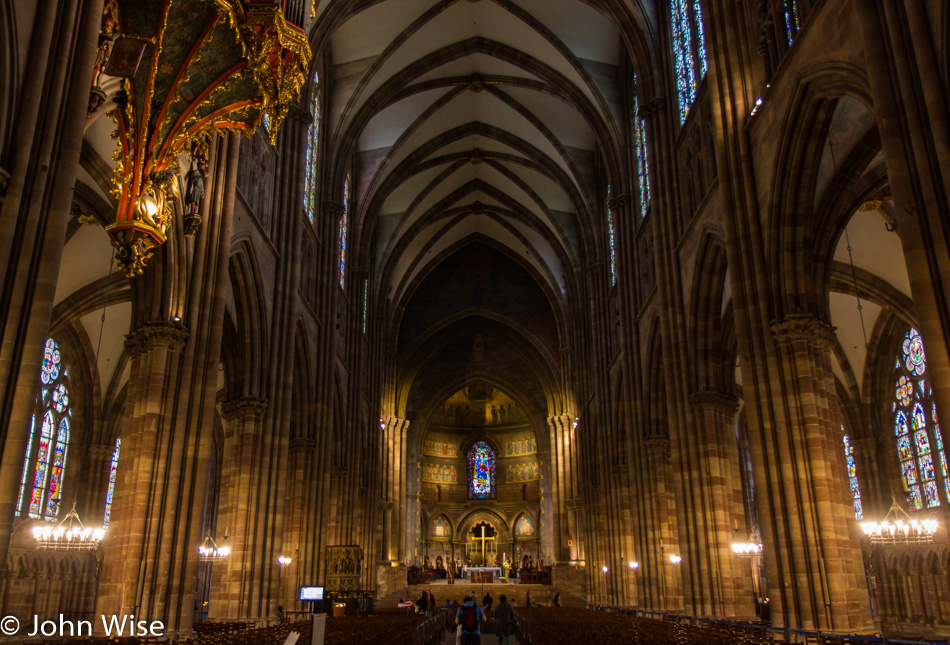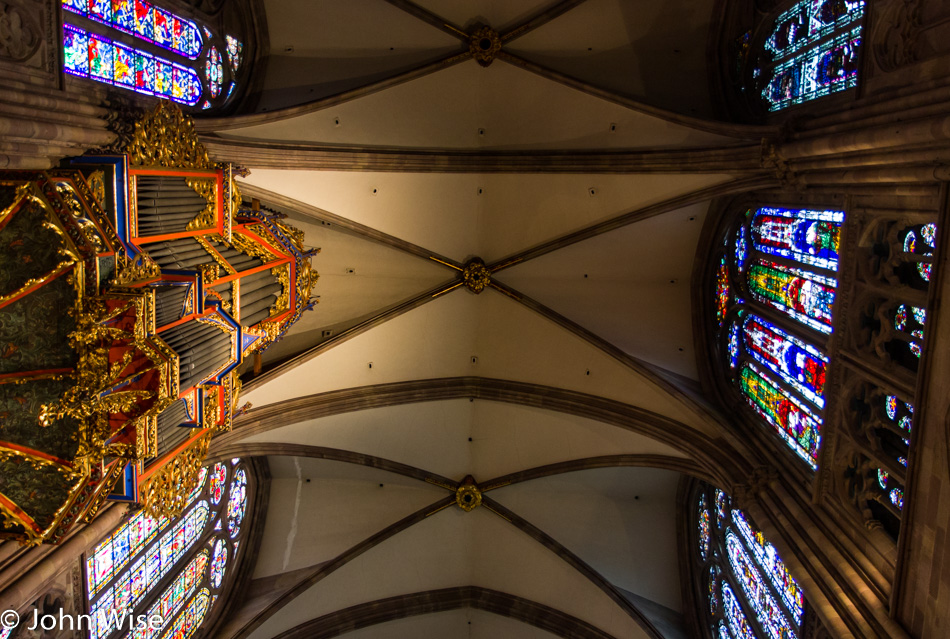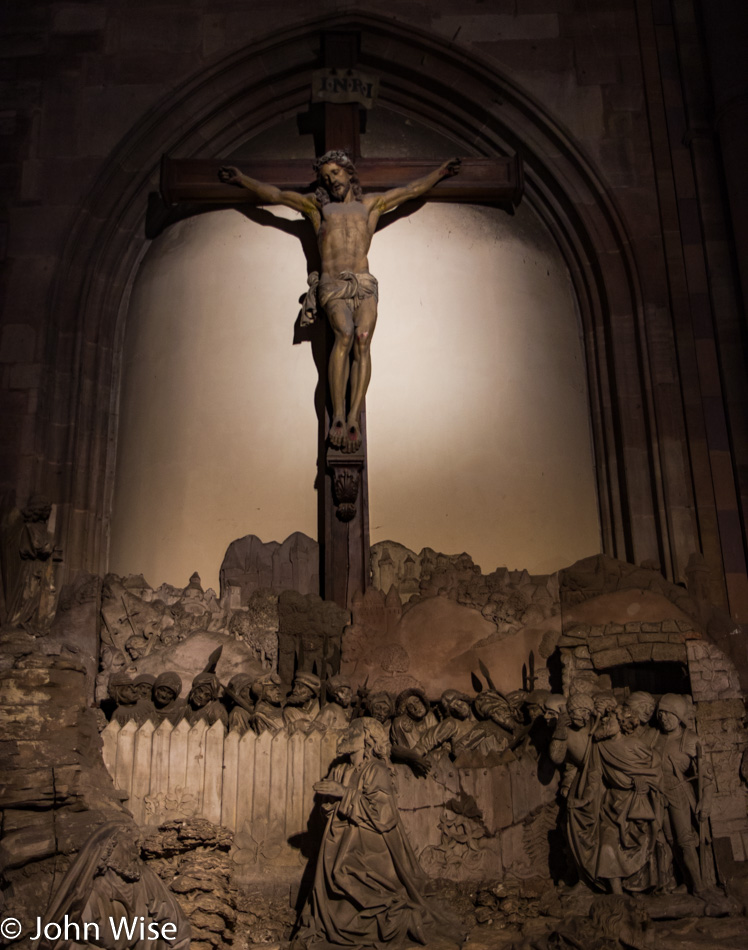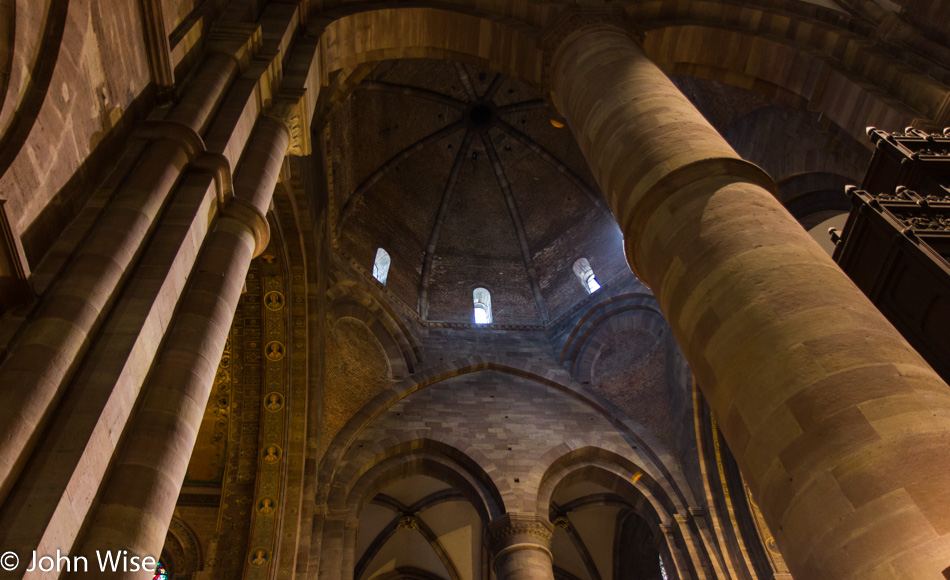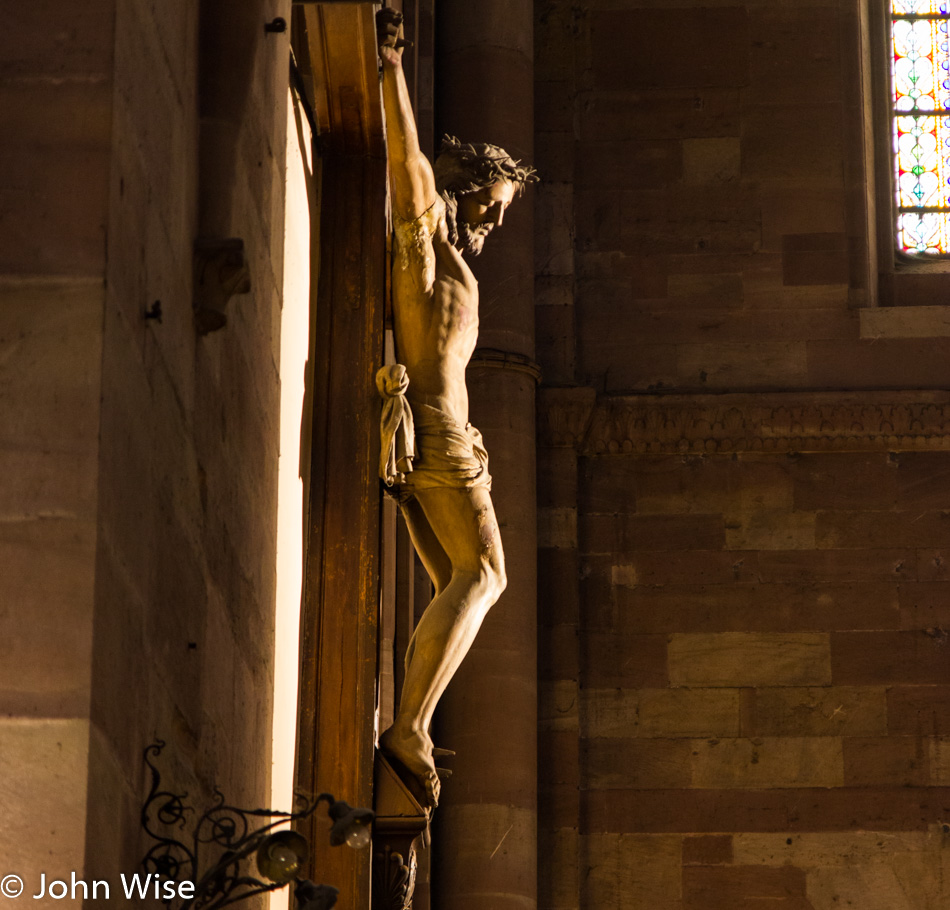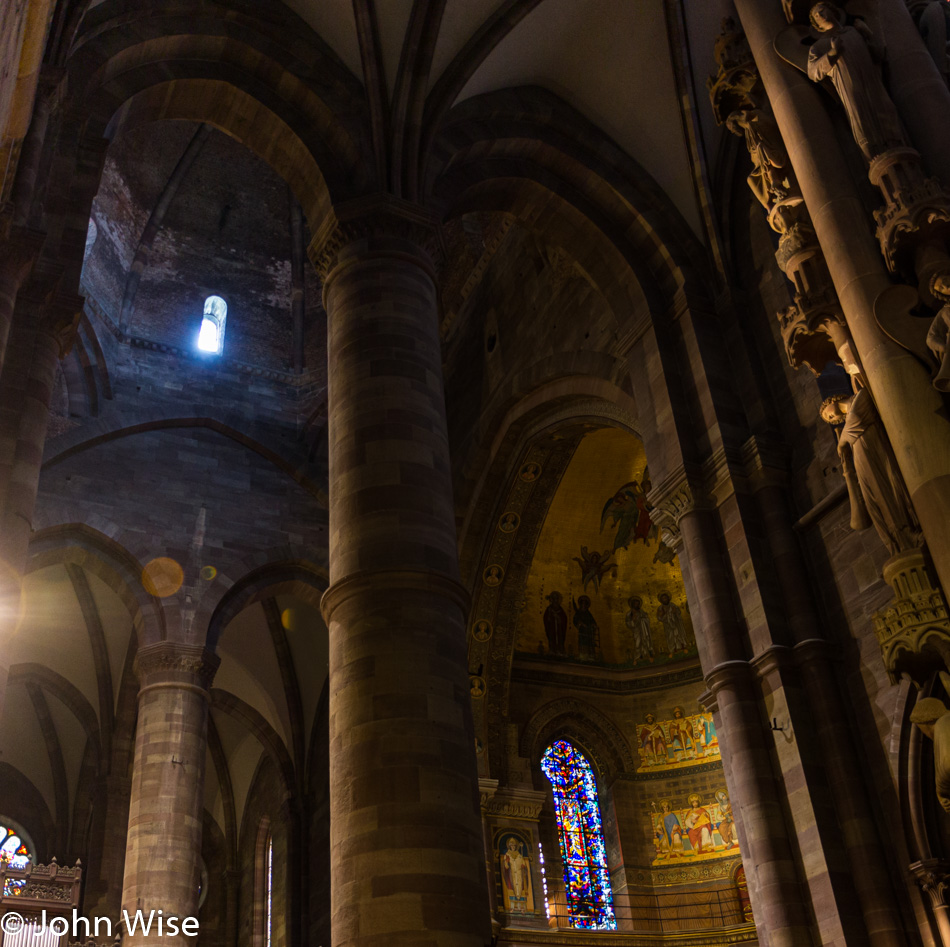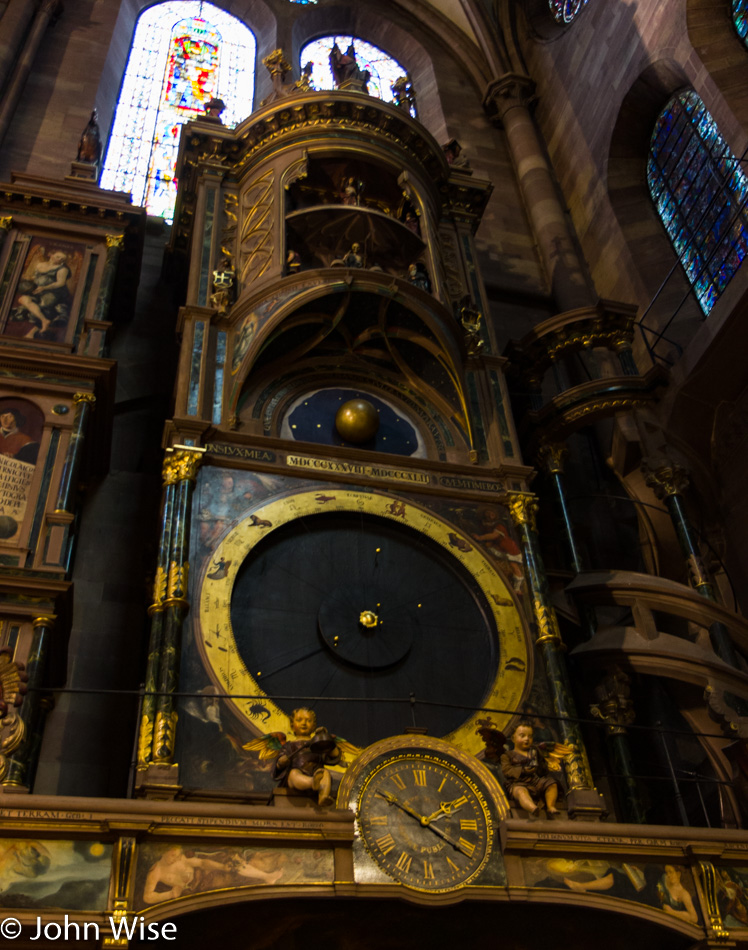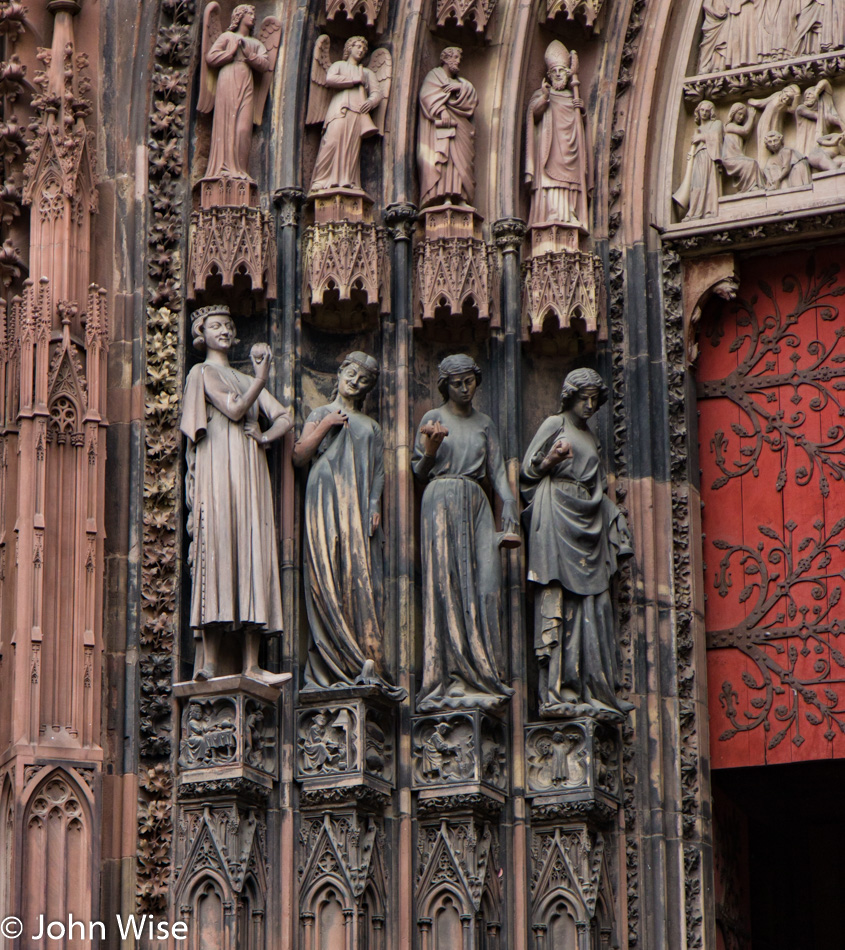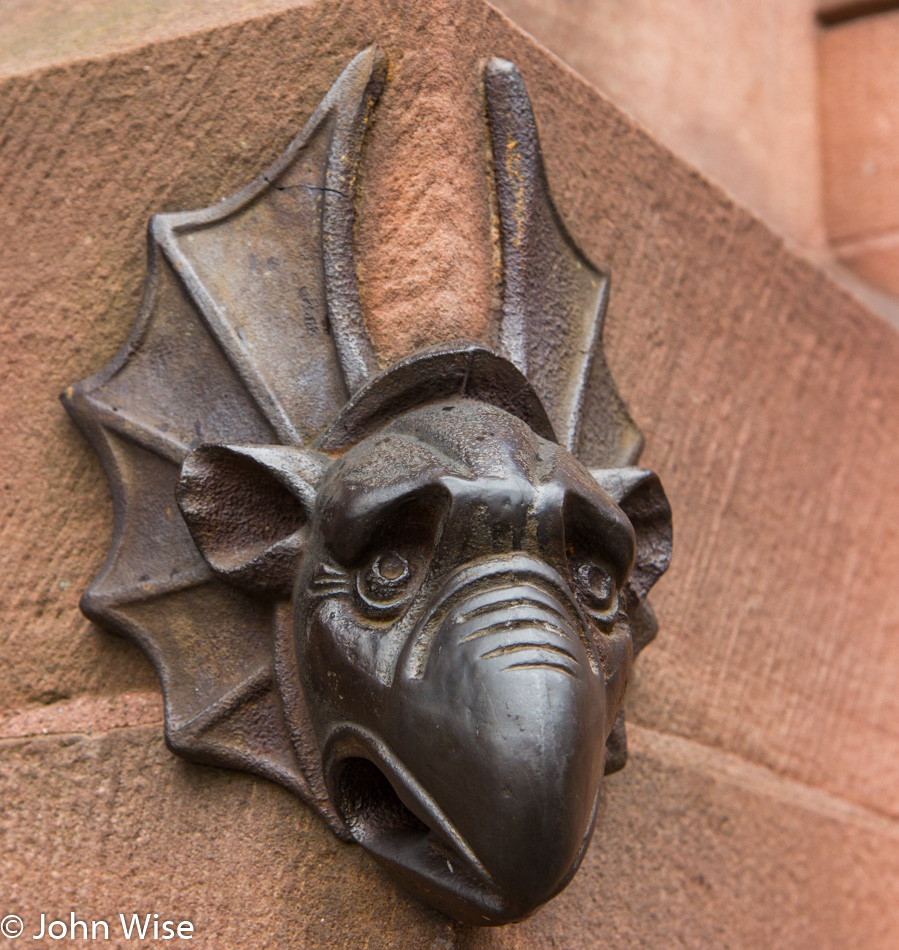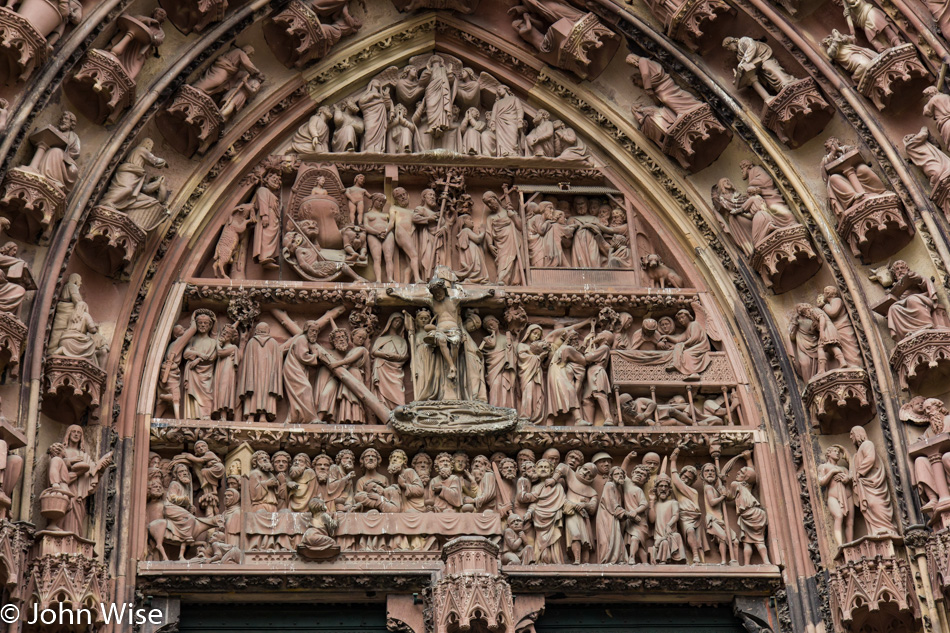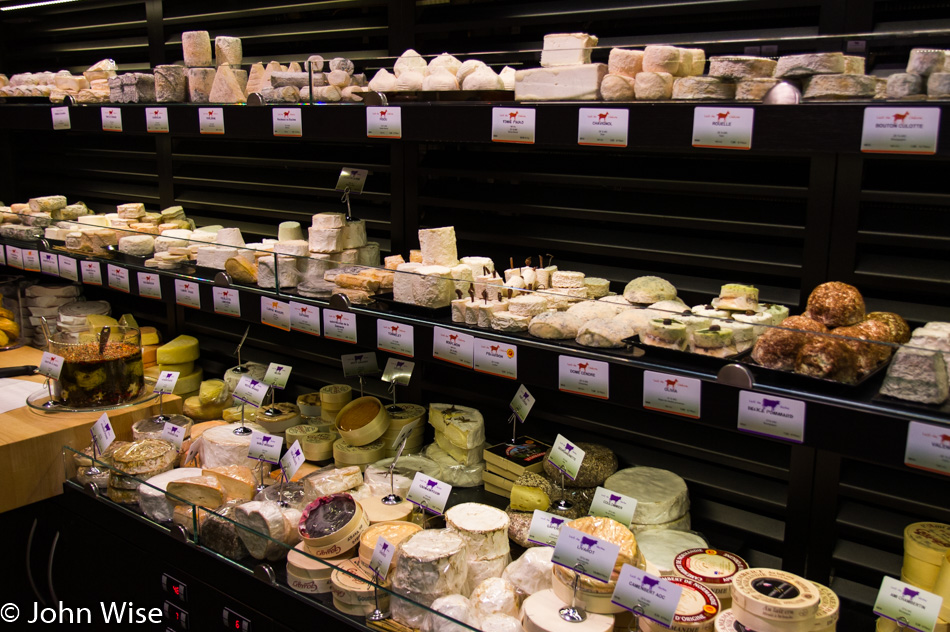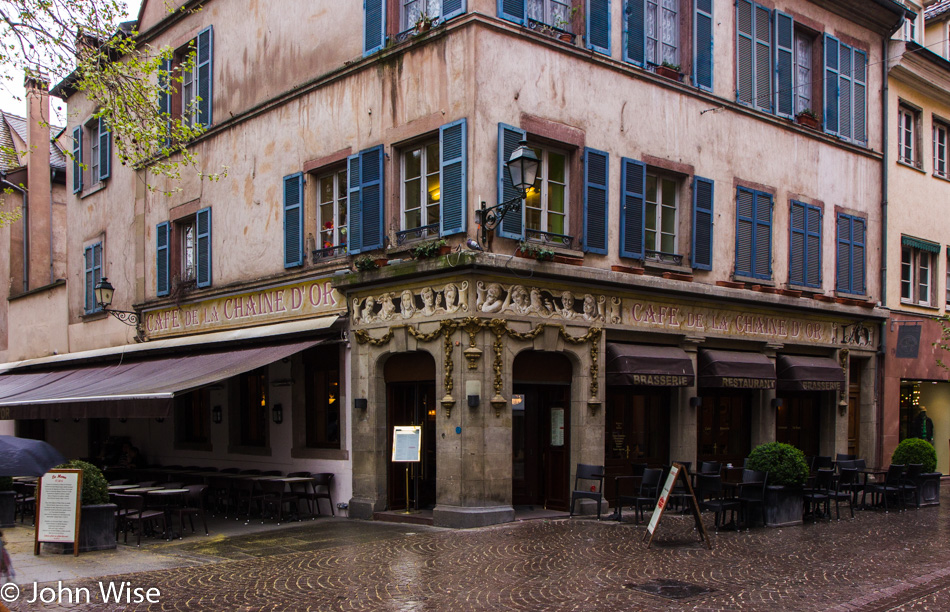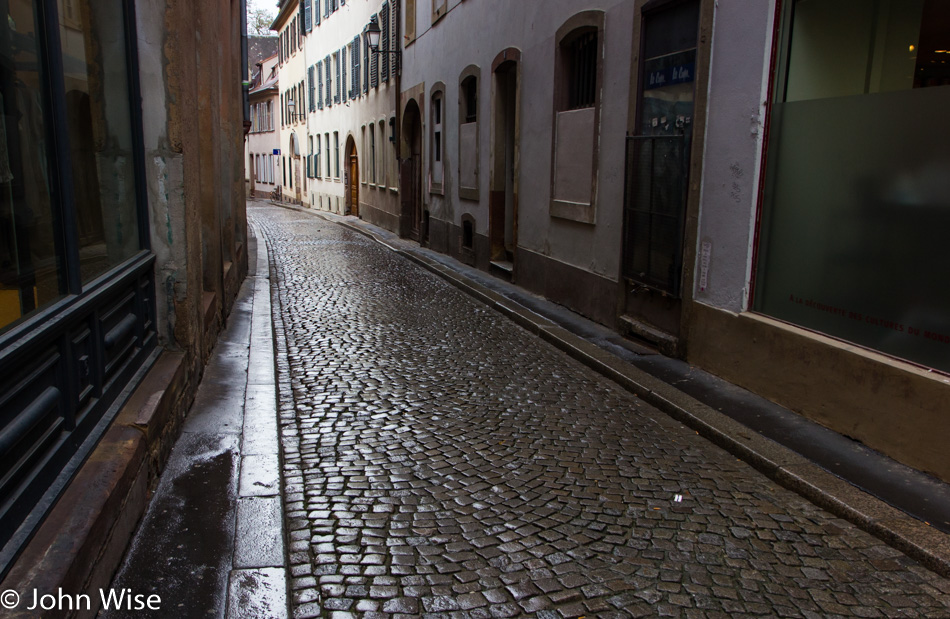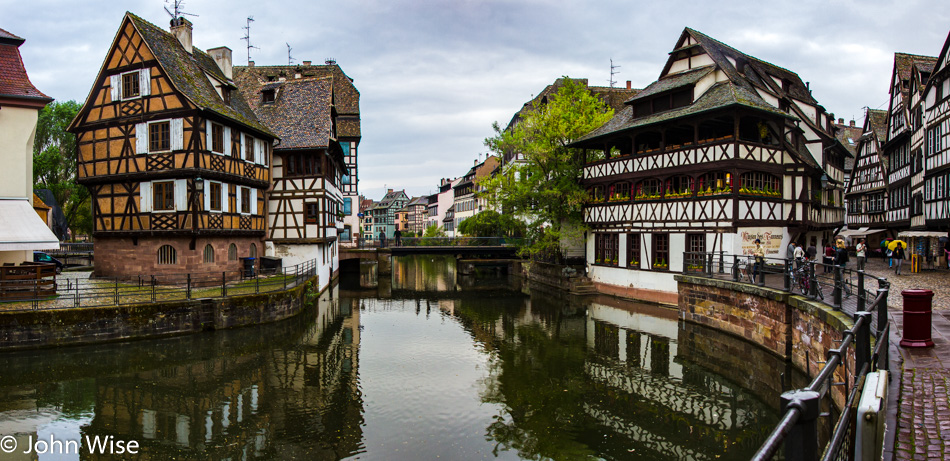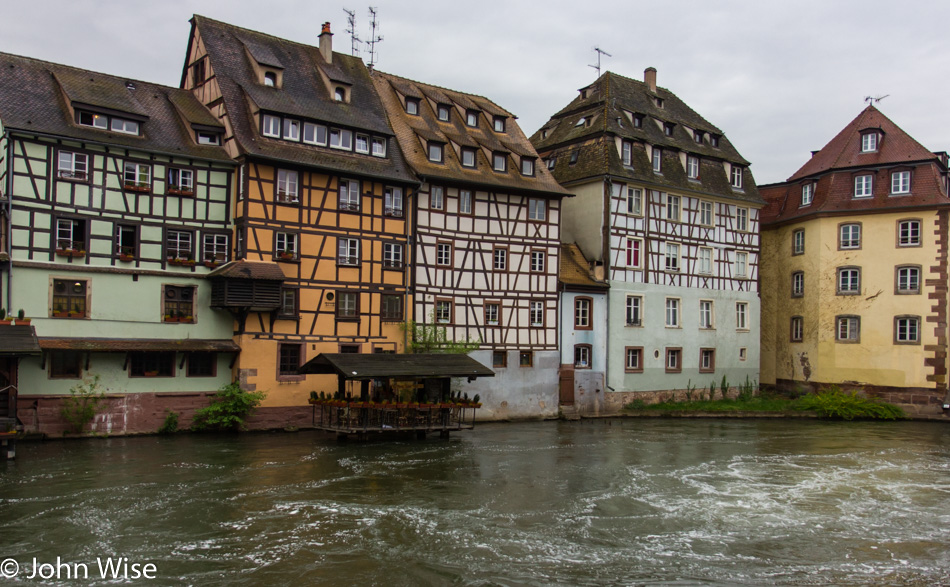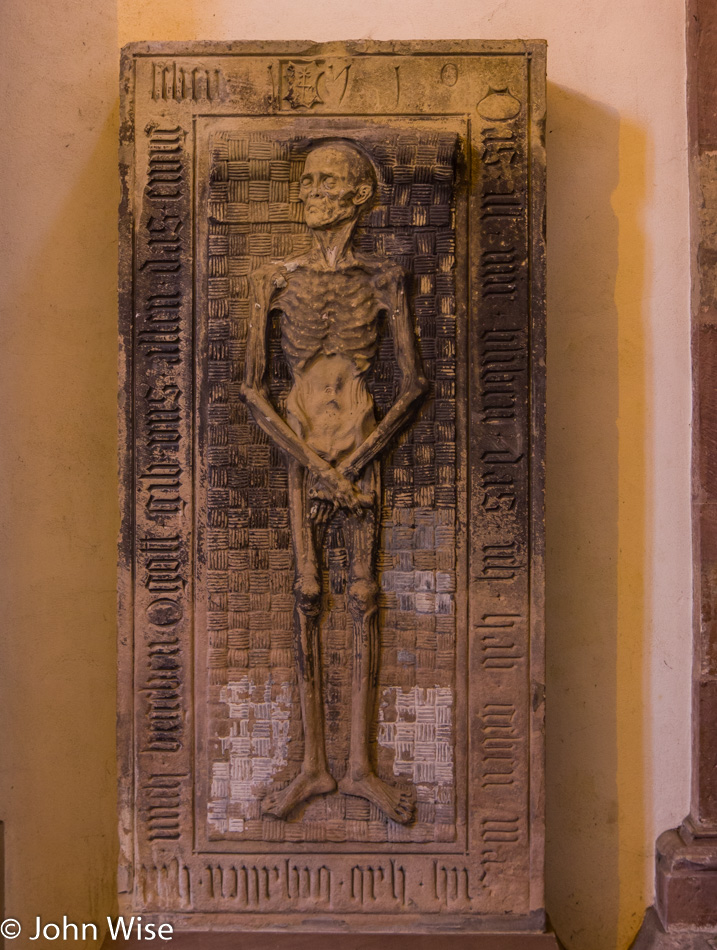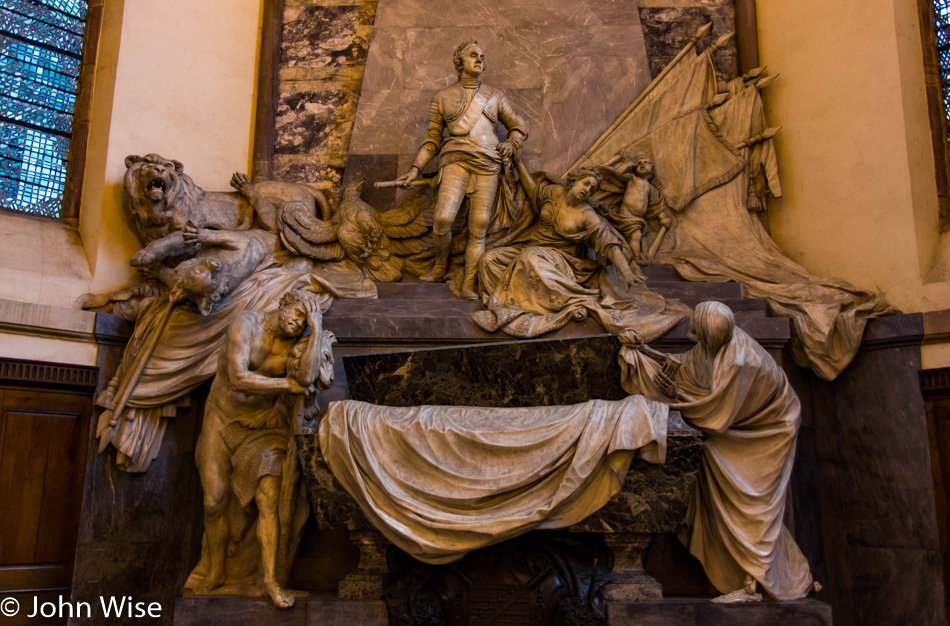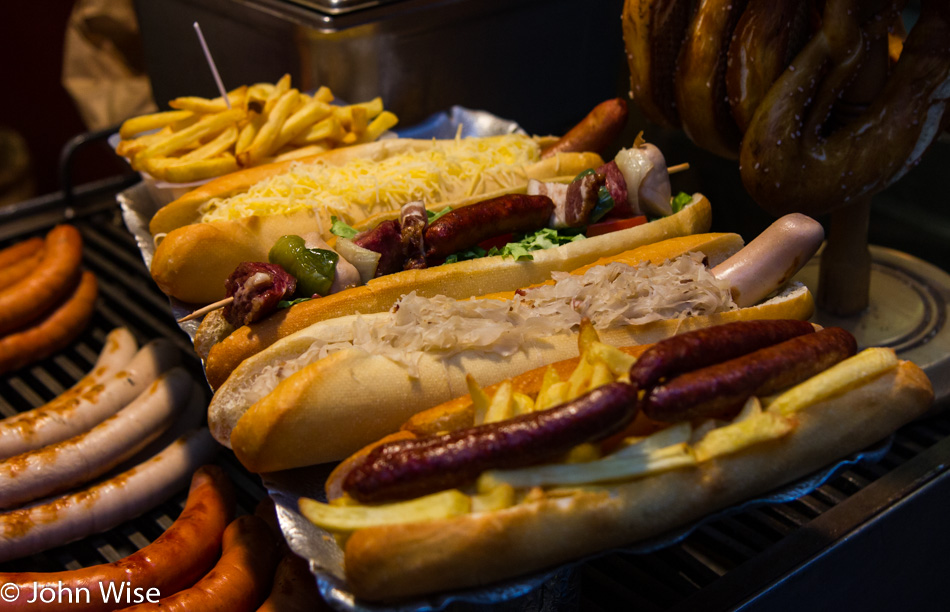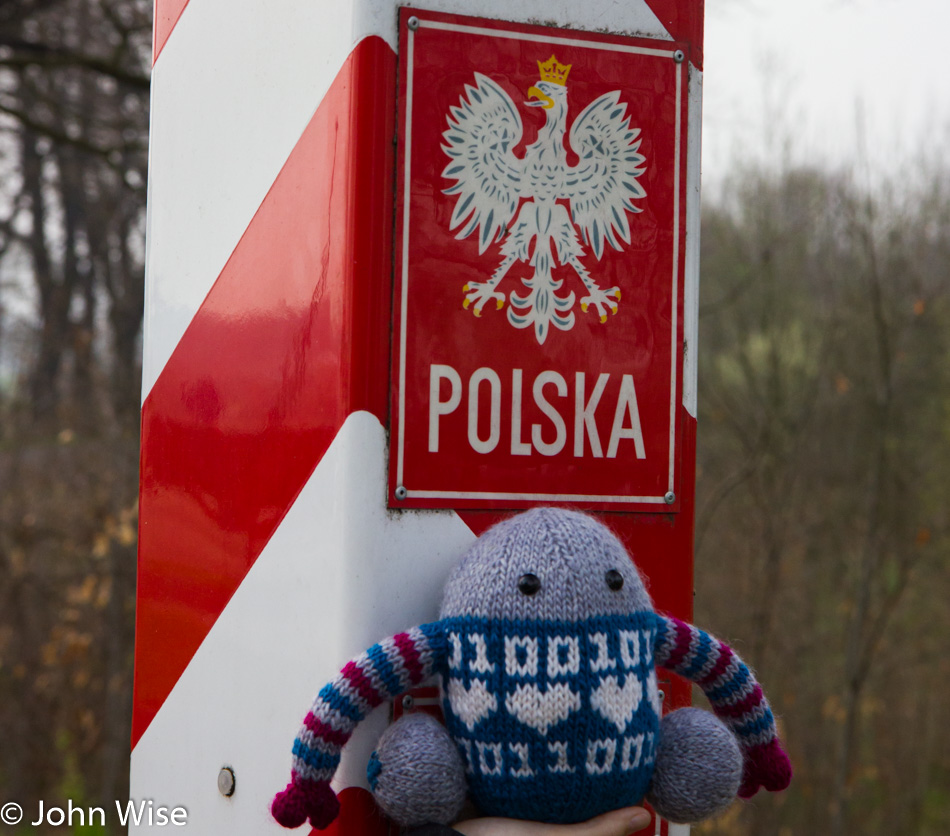
Disclaimer: This blog entry wasn’t written until seven years after the trip. It should be noted that this was a huge mistake. Sometimes after writing so much about other days, it happens that at the time directly after the trip or even during, I convince myself that the details are not that important. Years later, these details are that important, and pulling them out of foggy memories is difficult. The photos help and often leave clues, and then Caroline’s memories are usually far clearer than mine. With that said, here goes.
Wow, we have visited Poland twice on this trip, that’s winning. What is this knitted robot doing in the picture, you ask? Meet Mr. J50 Fiberbot. Caroline clandestinely made this for my 50th birthday while we were in the States and somehow managed to keep it a secret as she smuggled him into Europe without my knowledge. Looking for the right time and place to give me my birthday gift, she decided that Dreiländereck where three borders meet, those being Czechia, Poland, and Germany, would be that spot. If you wonder about the secret code knitted into his body, well, his name holds a clue that relates to my age and the first initial of my name.
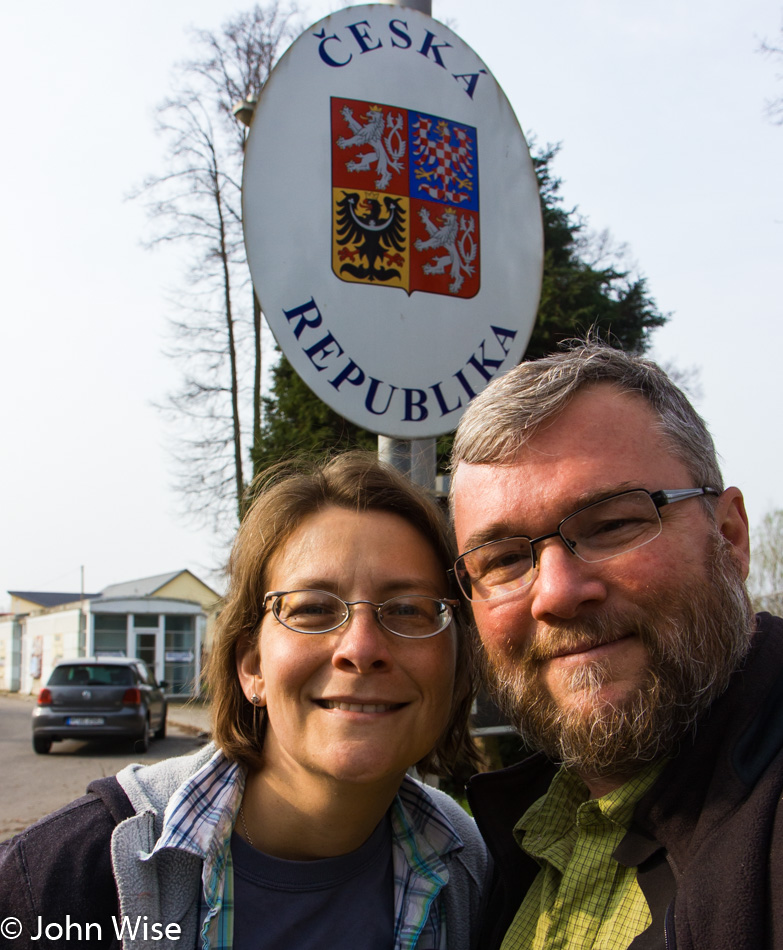
Two new countries on this trip into Europe, yay. This is our first time visiting the former Czechoslovakia, as it was known during the Cold War. We’re on our way to Prague.
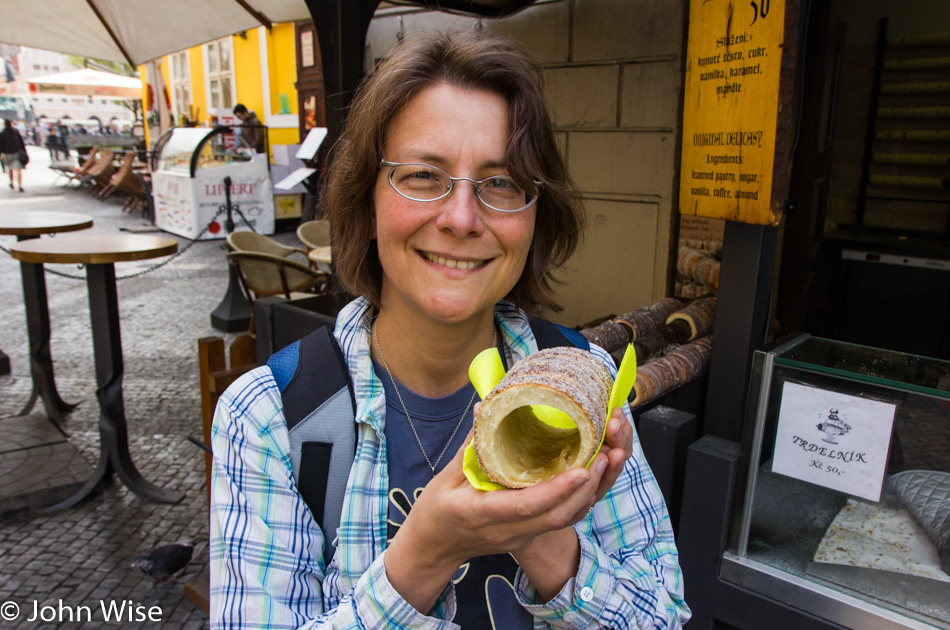
Two hours later, we’re in Prague with the car parked for the day and us out on foot. Chimney cake? Heck yeah, we’ll try that.
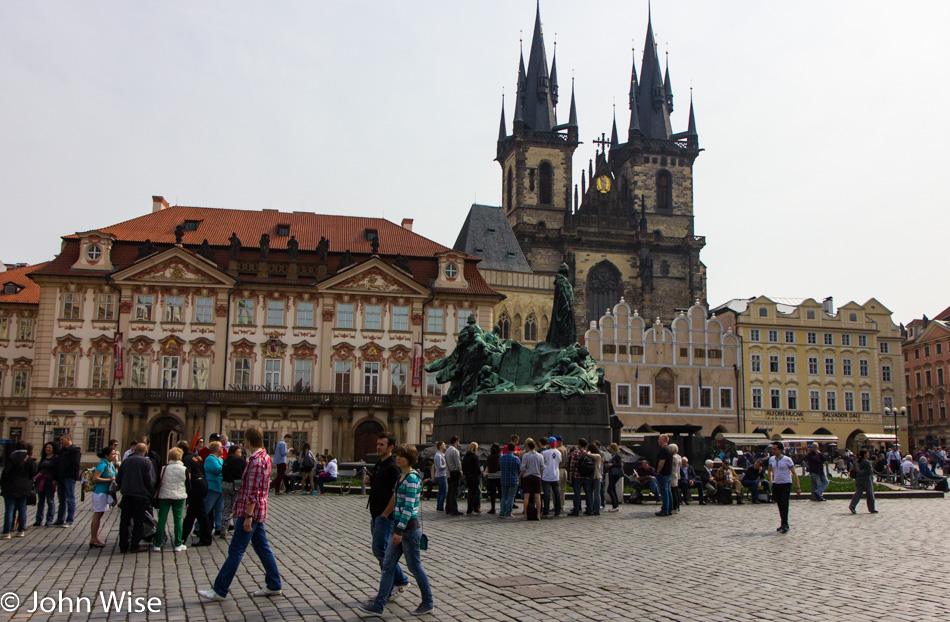
The main city square is huge, or at least looks that way, packed with so many people. Had we arrived at 6:00 in the morning, I’d bet we could have had the square to ourselves. Going from our drive across the countryside and the relatively small cities we visited yesterday after Dresden makes transitioning to the megalopolis of Prague a bit taxing. The best thing to do is head for an exit of the square and catch our breath.
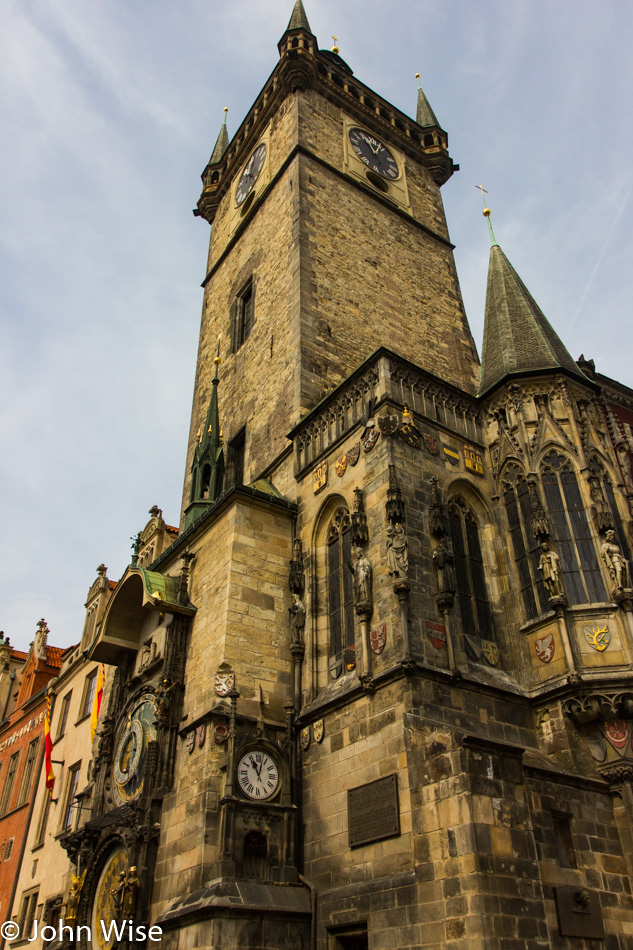
The corner we aimed for happens to be an even busier area of the square as it’s the home of the Prague Astronomical Clock. This relic, and big draw of visitors, was built back in 1410.
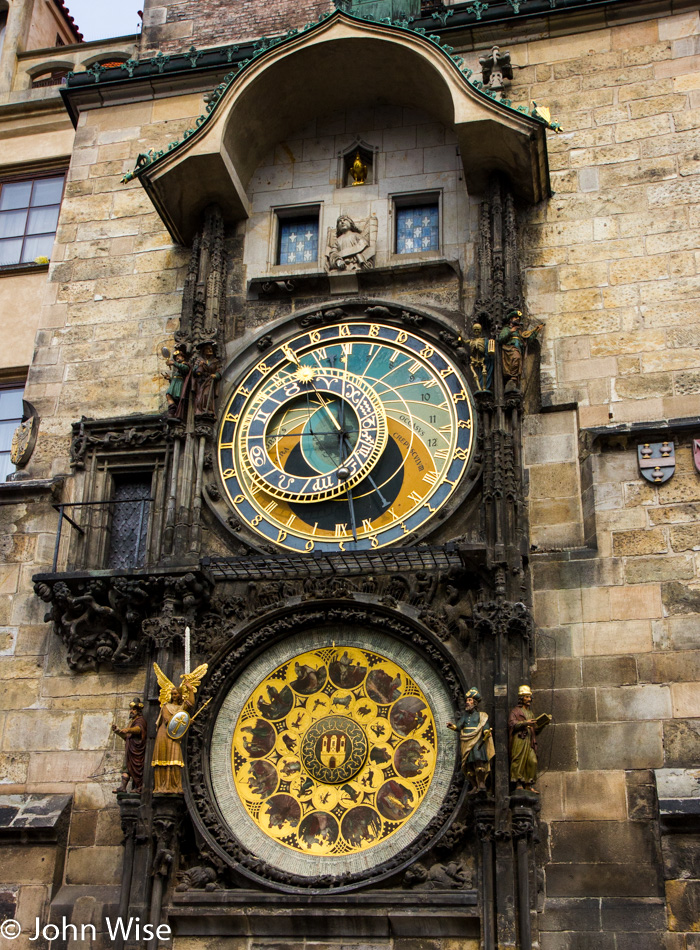
Here’s a better view of the clock, but there was no way we could wait around to see what it was going to do as it was wall-to-wall people and difficult enough just to get past them all. Maybe on a subsequent visit, we’ll see this 600-year-old gem do its work
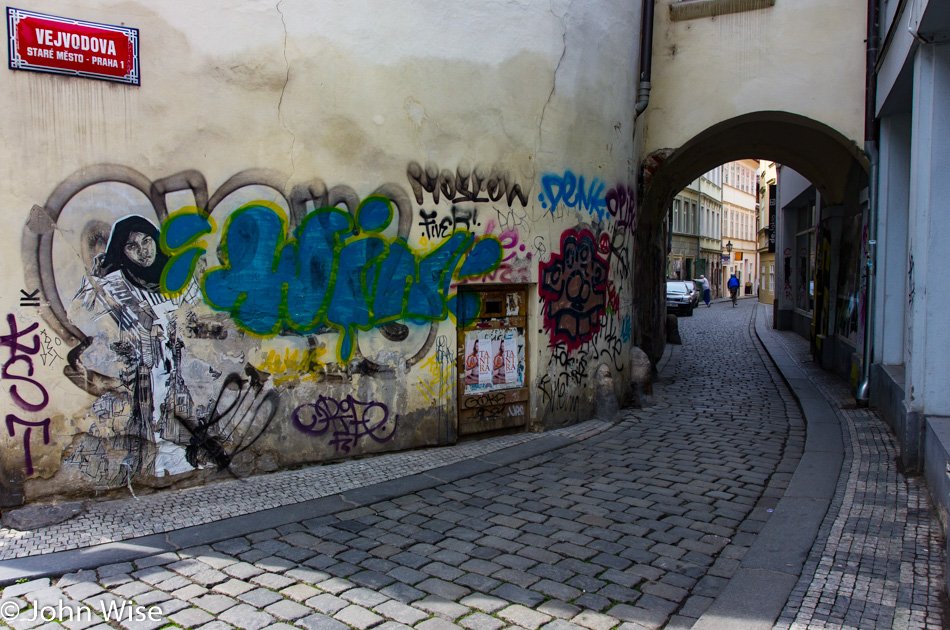
This is more my speed of how to visit a city. I grew up in L.A., and before I could drive, I’d take the bus downtown and out to Hollywood, but I’d do that when my parents and everyone else were working so I could wander when things weren’t too crowded.
Later, when I was living in Europe, I’d go to Paris, Amsterdam, Brussels, and Munich outside of the tourist season. I’d arrive early before things opened while the bakers were still tending their ovens. I’ve always had a need to see places as they might have looked before the age of tourism. The ugliness from those of us who clutter around iconic landmarks and make visiting impossible for locals except on rainy days in the winter is an abomination, albeit an important financial one that I understand, but for my selfish needs, I want to see the quiet city.
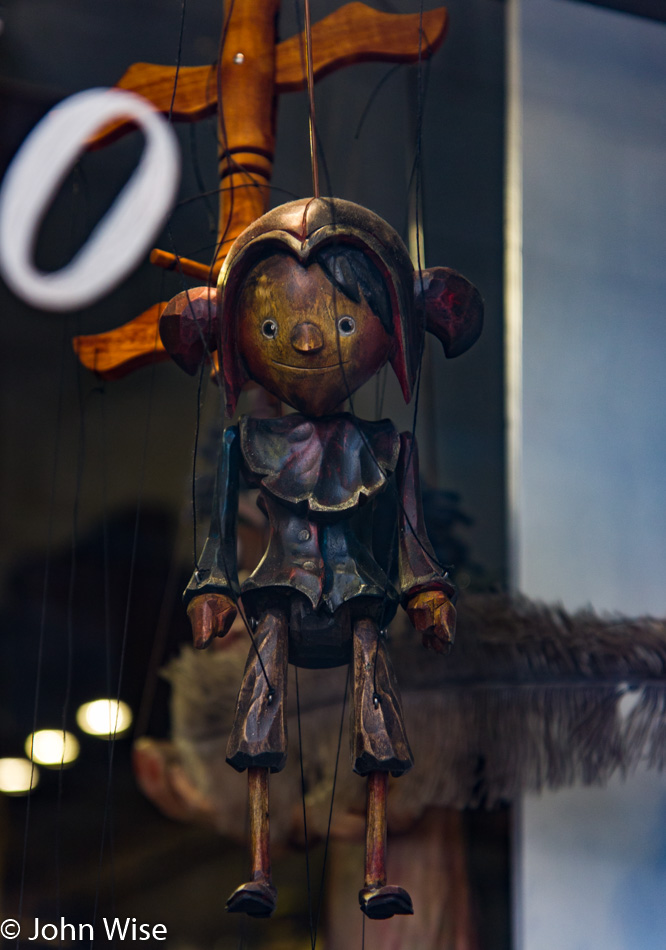
On busy streets and crowded gatherings, people miss the little things.
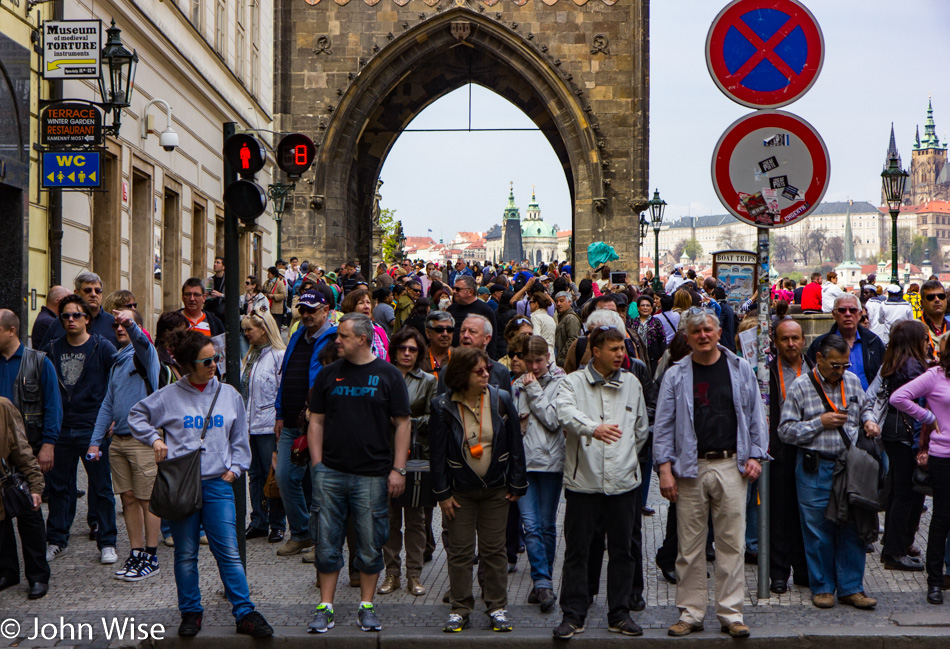
At some point, we have to rejoin the stream.
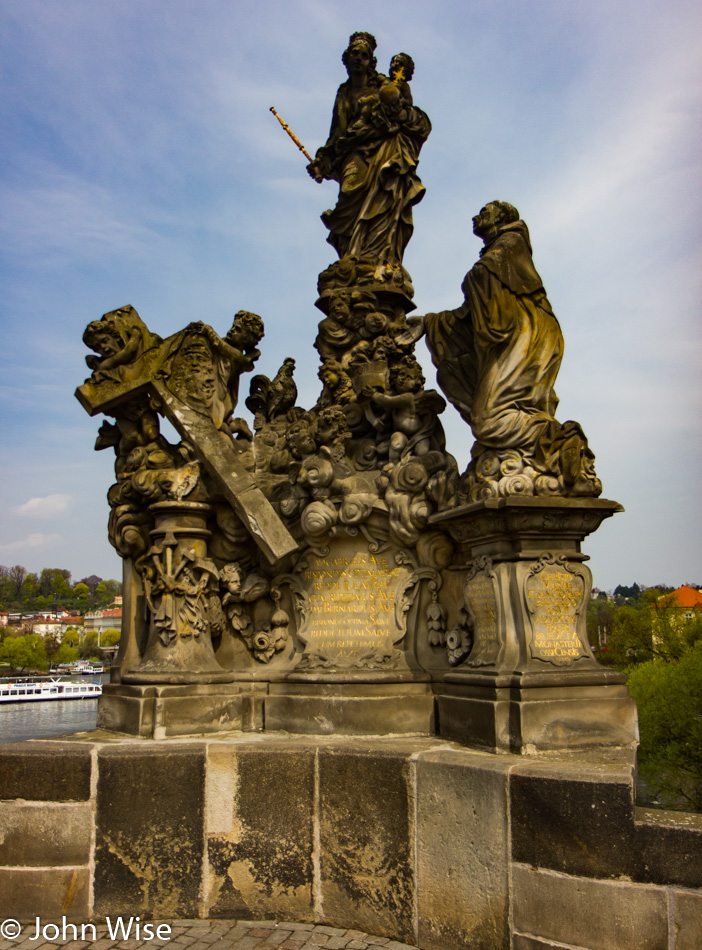
Then, one of the tricks of my version of storytelling is that I try to make it appear that we are alone in our universe. In so many ways, we are alone as nobody else can be in our heads as we move through the environment, and if I’m patient, I find that others will notice I’m trying to capture a particular photo and will give me a second to snap it.
We are on the Charles Bridge that crosses the Vltava River. Built starting at 5:31 a.m. on 9 July 1357, we are now looking at a replica statue of what was once standing here as the originals have been moved to a museum to stop further environmental harm and vandalism.
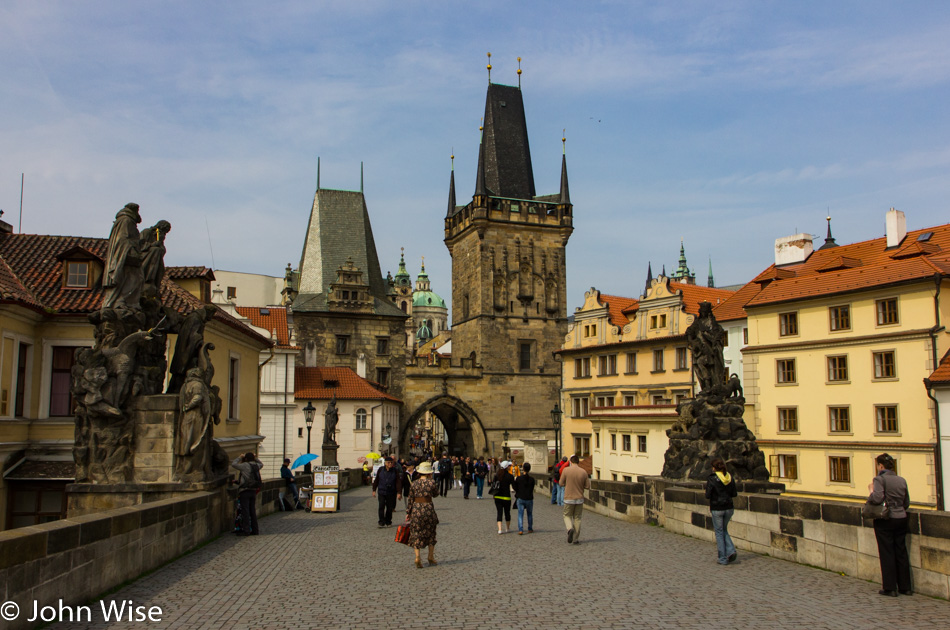
Next, I simply pay attention to the pulse and flow of people, and sometimes I can time when the next wave of people who passed through an intersection is still behind me or out front, and again, if I’m patient, I might capture a moment where things appear normal. The truth is that Prague is a madhouse of crowds.
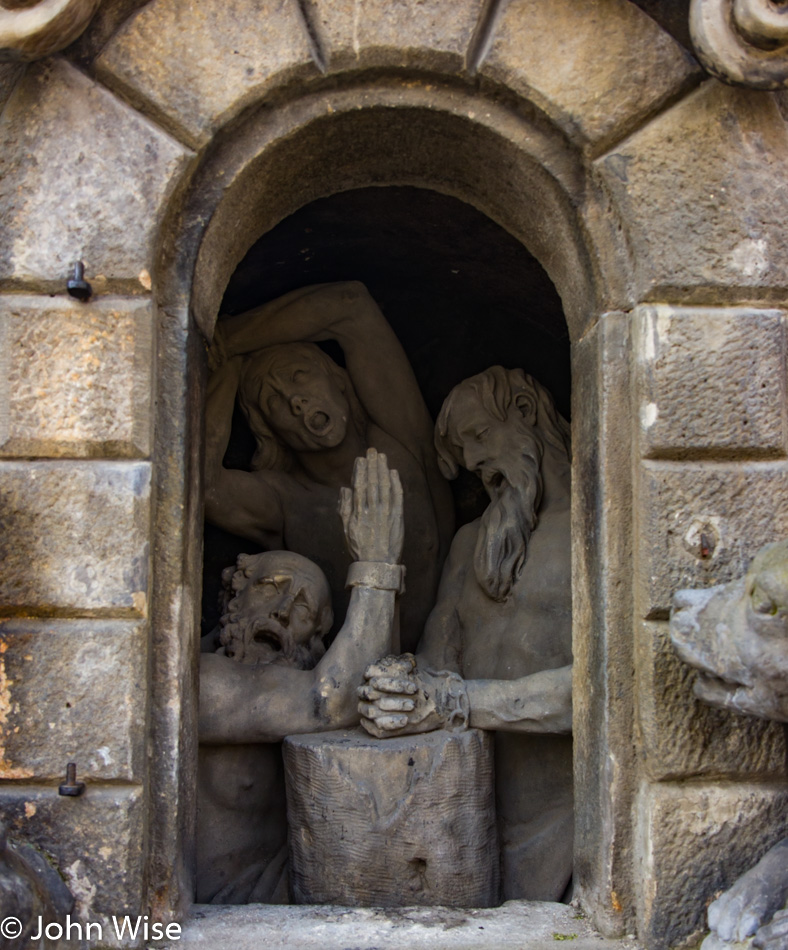
But why then visit big cities if it’s obvious that I don’t enjoy large crowds? History is usually the answer and the witnessing of culture as it’s happening plays a large role too. Prague, for me, holds special appeal due to its relationship to Kafka and ideas of Bohemia, and it is where a famous defenestration took place back in 1618, catapulting Europe into the 30 Years War.
Go back two days in my blog to our visit to Eisenach and the Wartburg; it was Martin Luther’s translation of the bible and the region’s move to Protestantism that triggered these fateful events. The Habsburgs were the end of the line of leadership in the Holy Roman Empire, and although it was Germany and Otto The Great that got things started back in the year 962, it was a deeply Catholic endeavor. Protestantism was a threat to the Empire and to Habsburg’s rule, it was felt. The King of Bohemia was giving his subjects in Prague more rights as Protestants, which angered the Habsburgs, who saw the king as dangerous. Their delegation to Prague was tossed out of the windows of Prague Castle in the “Third Defenestration of Prague,” which kicked off this war I keep referring to.
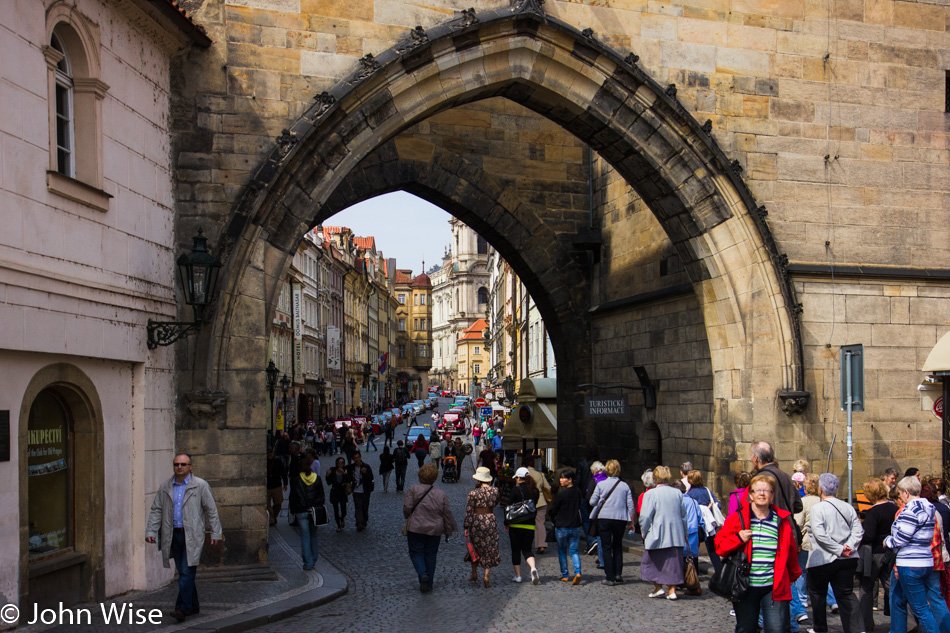
What we are seeing in Europe from 1521 through the middle of the 17th century is the fight for religious freedom in so many ways. In 1534, as King Henry VIII broke out of Catholic rule under Rome and established the Church of England, it was still an authoritarian branch of religion that some in the population resented. For us Americans, history gets messy at this time, but it’s actually all quite clear.
In 1607, the first Colonists arrived on the shores of North America; 13 years later, in 1620, the Pilgrims landed. These Pilgrims were Puritans based on Protestant doctrine. They wanted a pure, non-corrupt form of religion that adhered strictly to the bible; they were fundamentalists. It would be another 156 years before Thomas Jefferson wrote the Declaration of Independence, and while Jefferson was Christian, he was not an Orthodox Christian. Today in America, we are a confused people who believe our country is a bastion of Christianity when the founding fathers wanted to ensure that no one would rule with an imposed religion.
The point here is that Europe was exploring the boundaries of how religion and public life intersected and that it wasn’t a purely American thing from people exploring freedom and liberty. Even the Habsburgs, by the time of Maria Theresa in the mid-18th century, were seeing the need for change, but it was difficult to divorce entrenched traditions from the speed of change that was upon humanity. Then, by the beginning of World War I, with the assassination of Franz Ferdinand, the Habsburgs, and Catholicism as a body of rule would finally come to an end. Enlightenment, industrialization, and communication were changing our world.
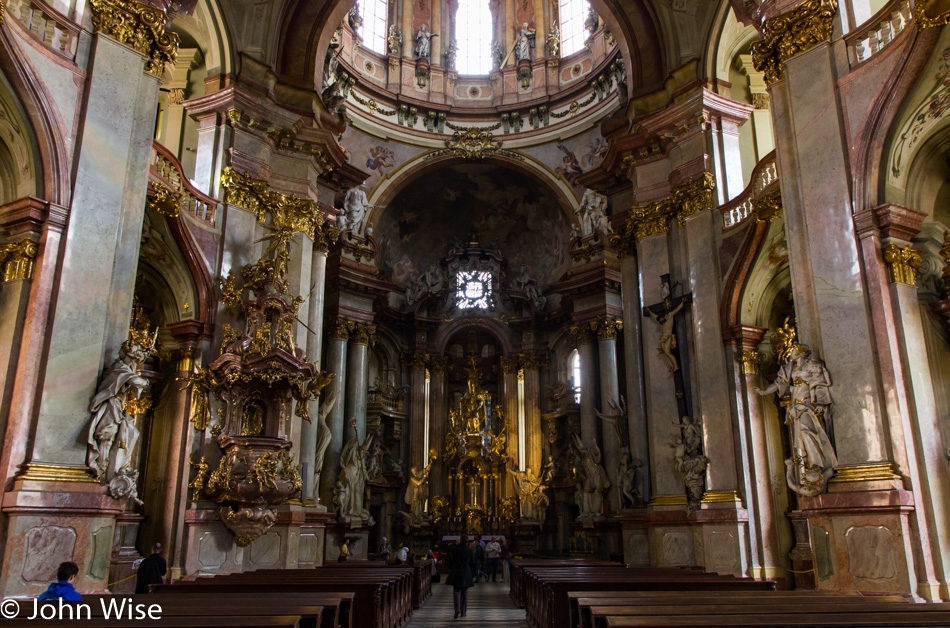
Religion, though, has kept its toeholds in the organization of culture, keeping its stream well crowded with the devout enjoying the community of God. For me, these churches hold the same fascination as the Christians visiting a pyramid; they are not there to worship the King of the Gods known as Ra. They go to the pyramids for an anthropological look at history, to see how others before them related to their world. That’s what churches are to me. This is the Church of Saint Nicholas, yeah, him again.
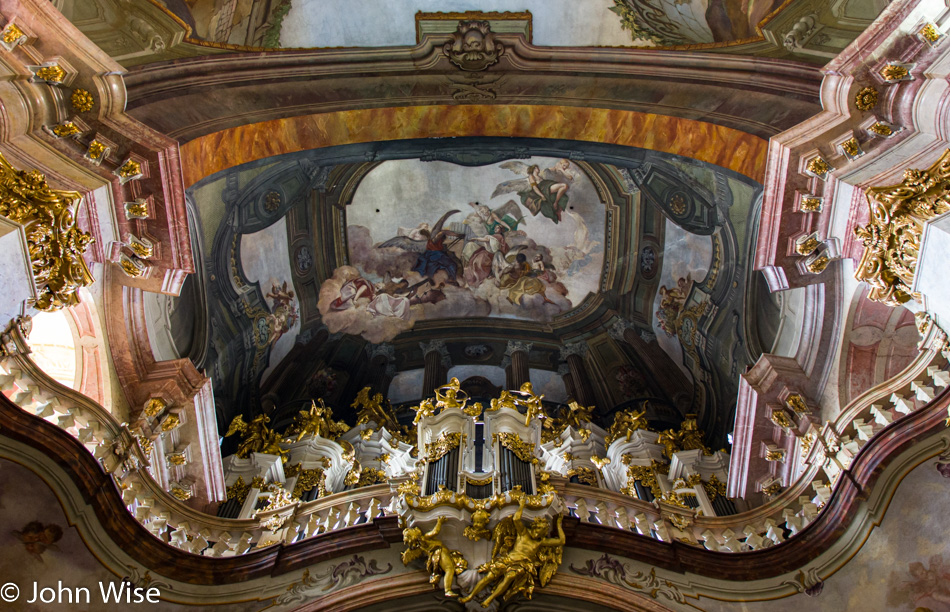
Lucky for me, people are still practicing their belief in Christianity as it pays the bills to keep these temples to God from crumbling. Or maybe that equation is broken and crumbling as it cost us 100 Koruna to enter but $4 isn’t much to part with to see such a spectacular place.
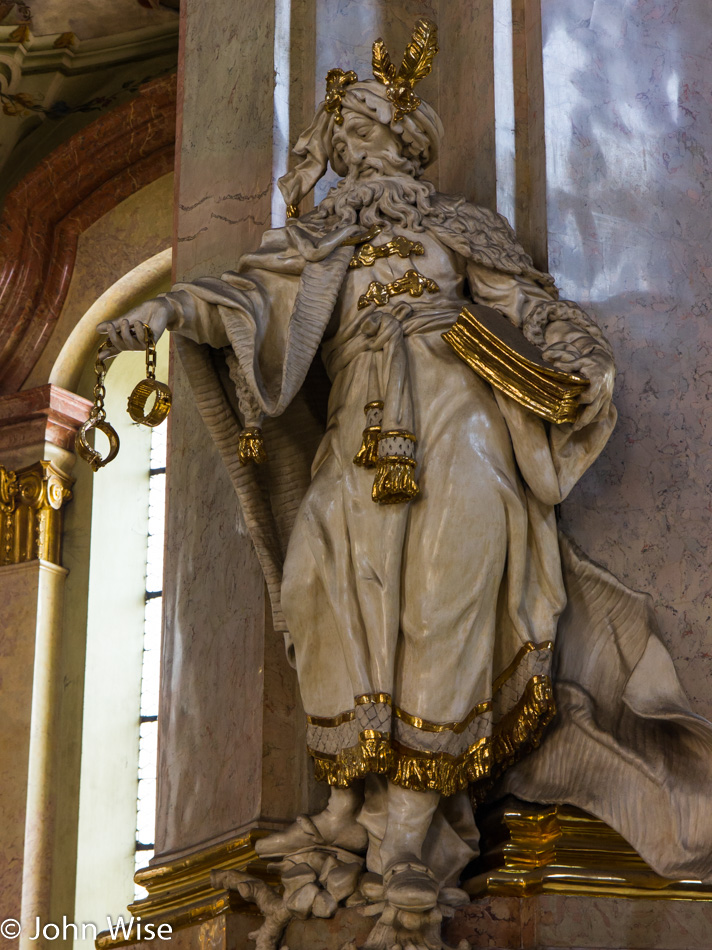
For all the treasure bestowed upon churches and the clergy by the laity, one might think God would be impressed by the grandeur we honor him with. Instead, he rules on high, possibly laughing at how these structures, meant to show our faith, are really nothing more than the coolest offices ever to those who work the altar and allow the hoi polloi to grovel at the feet of power and count their blessings that they are not cuffed and beholden to the devil. Power is an amorphous thing that changes hands all the time, not by dictums from God but from the egos of men.
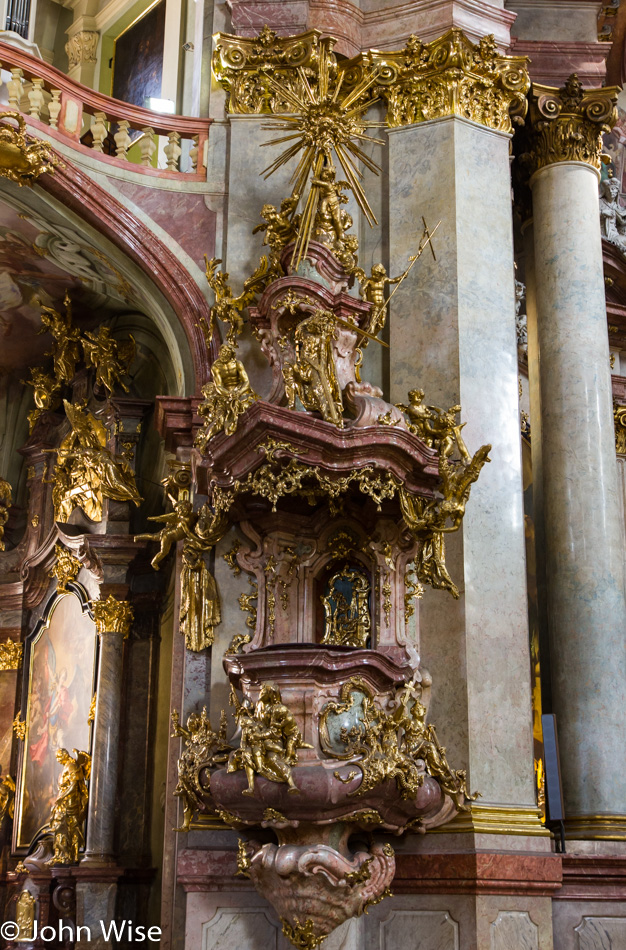
When the average person ekes out a meager living, how could they not be in awe and bow before the power of the God these treasures are said to represent? While religious authorities were building these Baroque, Gothic, and Romantic structures, how could anyone comprehend the amount of gold on display? Was it pure gold or gold leaf? Who could know as it represented a reality incomprehensible to the person standing in awe and fear that God had the power to love or damn their soul? With God speaking through the priest, bishop, cardinal, or other figureheads of whichever branch we were being subservient to, we would have to be careful not to earn the wrath of anyone who could exercise the power of dominion upon our meekness.
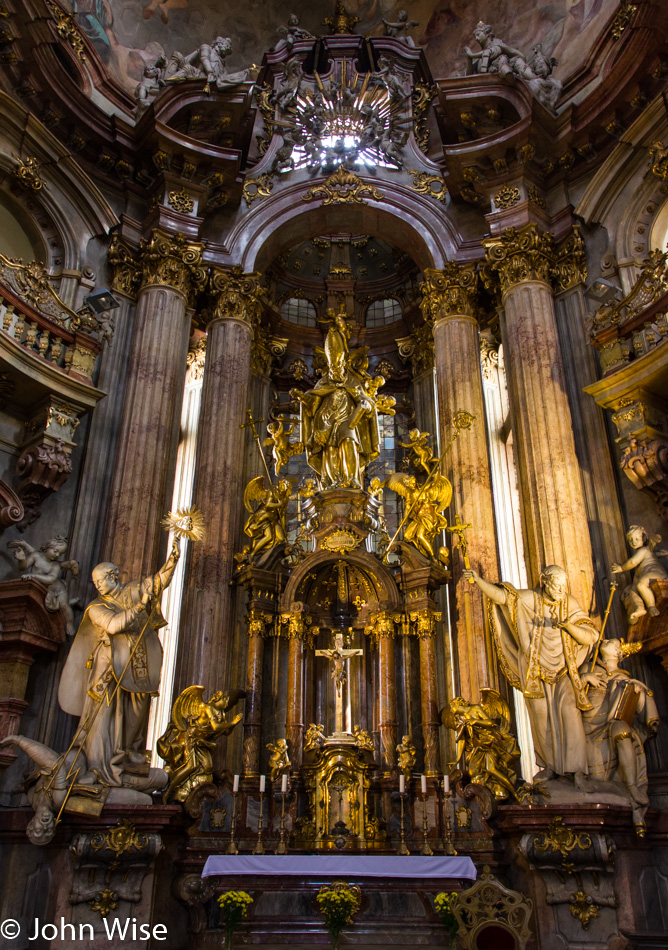
These are the visions only known to the holiest who have been entrusted to allow you the fleeting glimpses into the Kingdom of Heaven. An altar is a powerful place featuring men of consummate knowledge of all things spiritual; who else would be entrusted to stand before the flock of God under this cascade of gold and treasure and inform the wicked on the virtues of saving one’s soul? And so we used the primitive minds of an uneducated population to imprison themselves in subservience to the state and clergy, as these are the powers that hold control of your body and soul. Sure, we are sheep and yes, man killed God but the outcome was that it allowed the powerful to thrust their own egos into the lofty heavens above making themselves and their wealth the gods of the people of Earth.
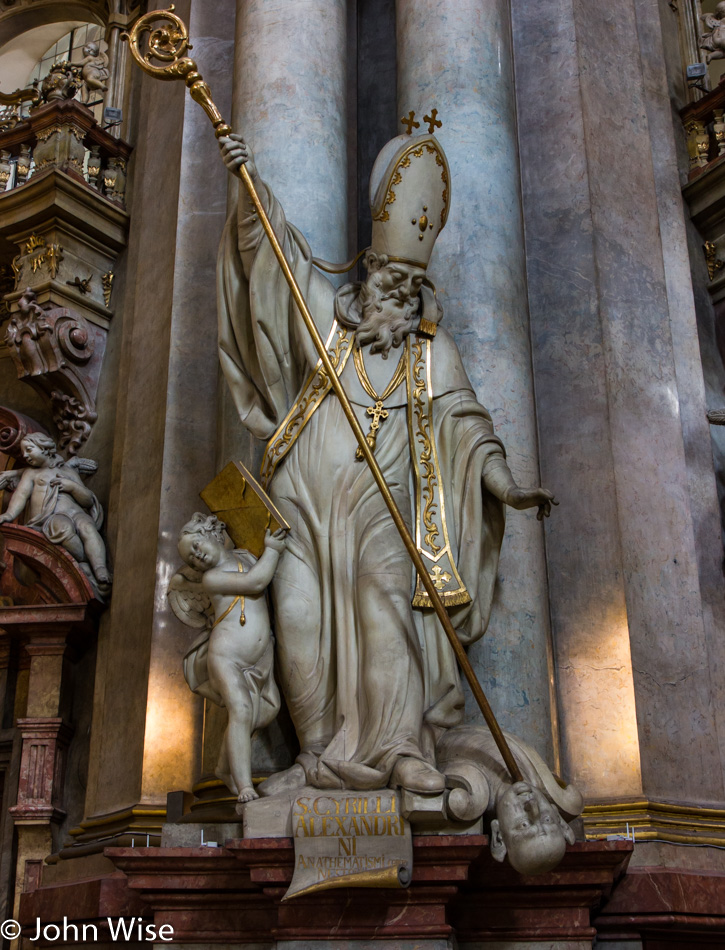
This theater of the benevolent Bishop trusted by angelic babies, offering his blessing to the demon about to encounter its fate, extolls the wisdom of ages that there are those who have gained the trust of those above who do the work of Kings and Gods. We should be so happy to be the infant dancing at his feet. And the play goes on.
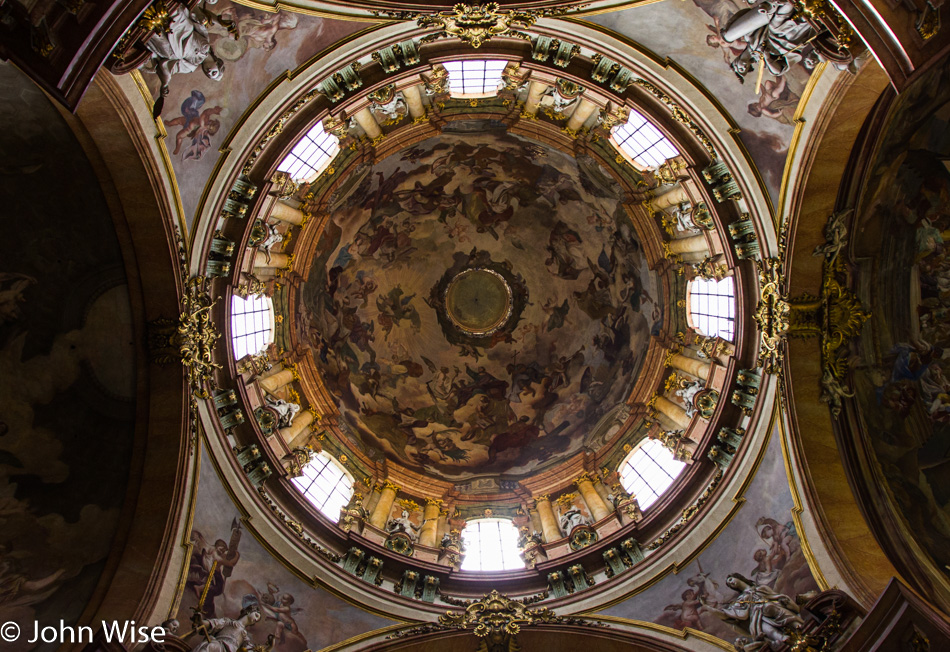
So look above you into your own mind and into your own soul. Those other people who are the controllers and holders of power were taught that very lesson. They understand that the meek are afraid of their own shadow and won’t act in their own best interest unless they can appear powerful to those of lesser means in their immediate vicinity. We must recognize that it is within each and every one of us to find ourselves in charge of our own destiny, but that will always require the investment in skills that exceed those we had yesterday.
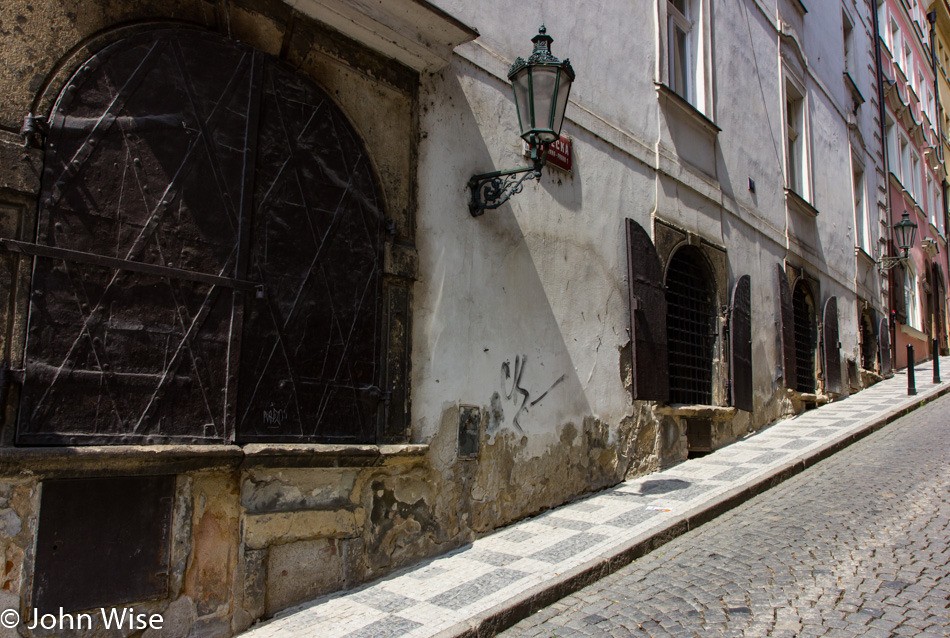
Sure, I could wax on and on about architecture, food, and beer, but that’s not why we are here. I can hear some guffawing right now about the food, considering how there always seems to be a mention of it, but this is a key element of the culture in my book. The architecture is already essentially covered, as I typically include enough photos for someone to glean an idea of what things look like. I suppose one of my main goals is to try and inspire others to go into destinations with more intention to understand how a place integrates with our world and our past than to land somewhere with nothing more than a need to grab selfies and bragging rights that they’ve been there, done that.
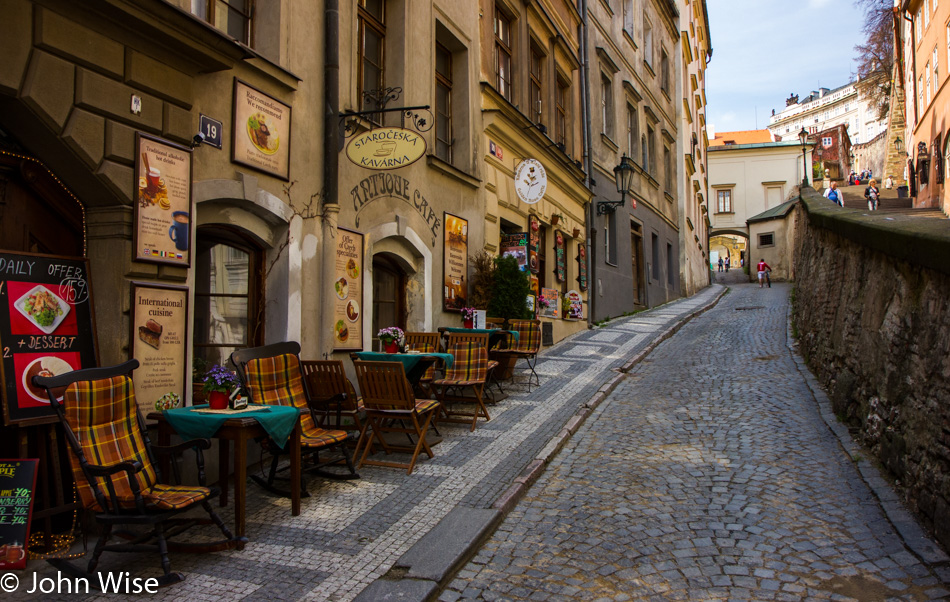
There’s a funicular that heads to the top of Petřín Hill, where we’ll visit Prague Castle to see for ourselves the window of defenestration. Maybe you can already guess that there were too many people in the queue to take the easy way up the hill, plus there’s always a lot more to see by hoofing it on foot.
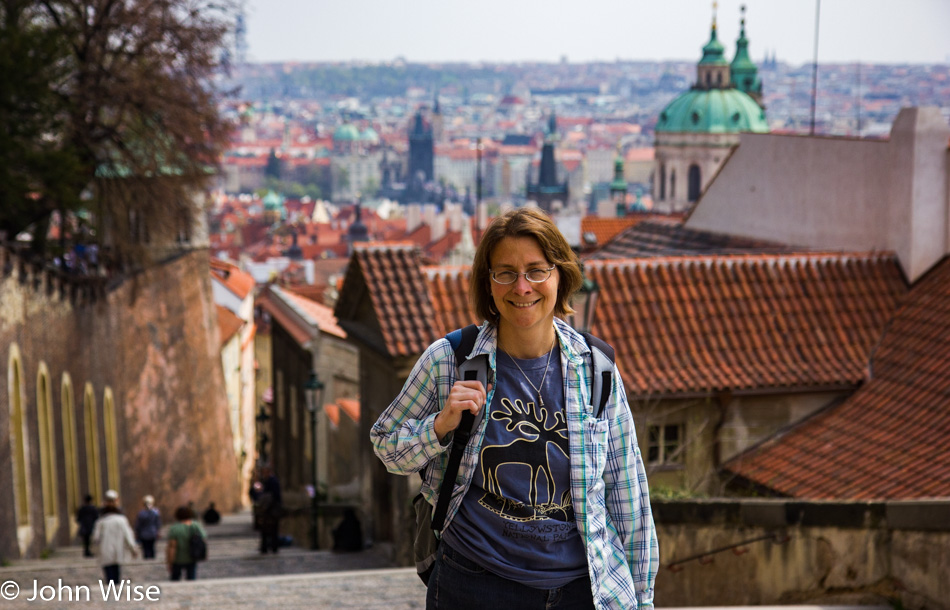
Seriously, it didn’t look that high from the bridge.
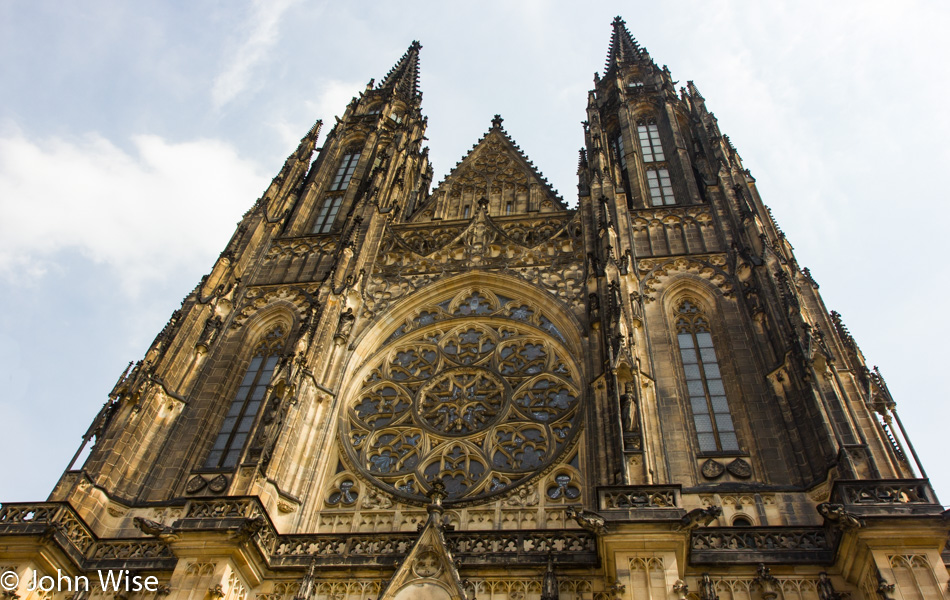
We took one glance at the lines to enter the castle and knew we’d have to come back another day. St. Vitus Cathedral, though, could be visited after passing through the main entrance area of Prague Castle.
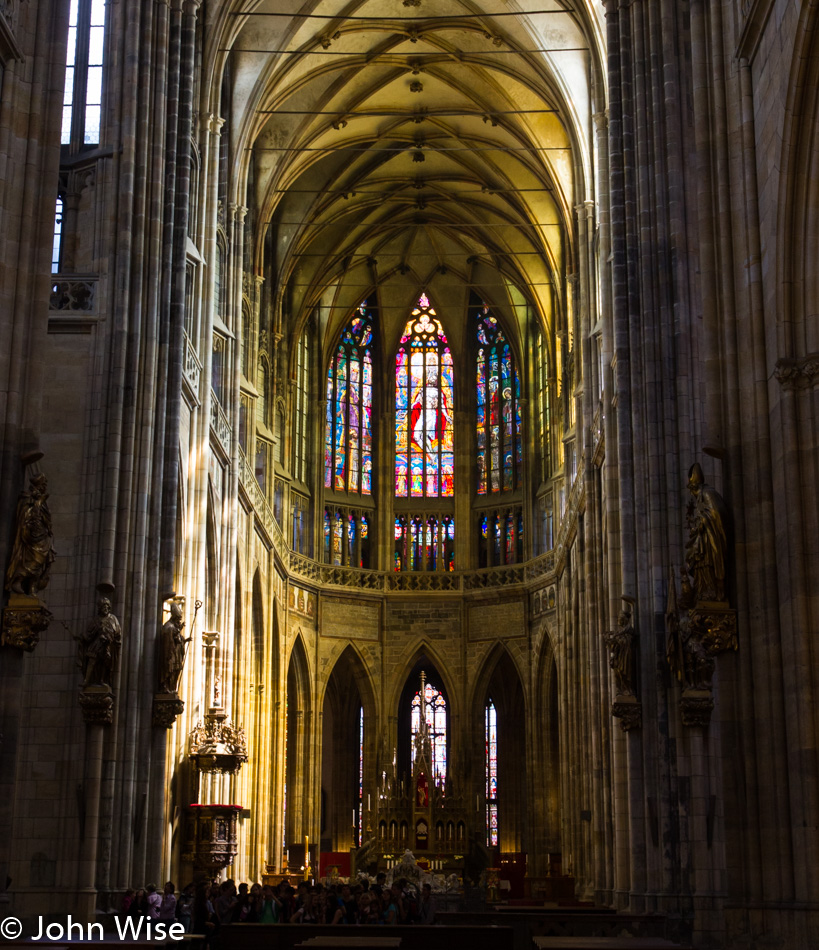
Begun in 1344 it would be another 600 years before the largest cathedral in the Czech Republic would be finished. Not until 1929 was St. Vitus considered complete.
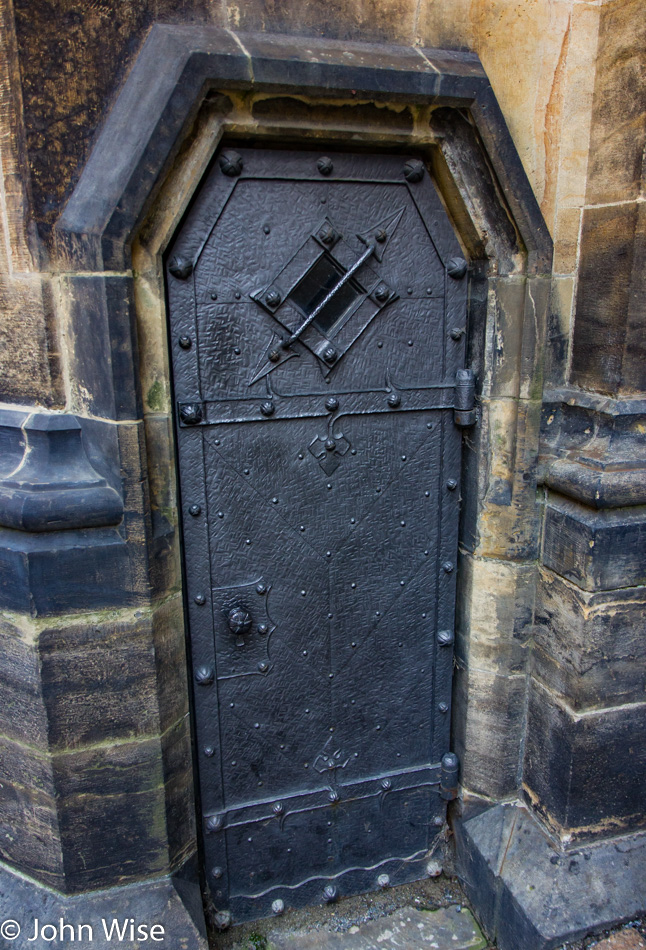
I don’t know what we were thinking when we thought we could drop in and out of Prague and that half a day in the city would be adequate. In part, I don’t believe we understood that this was the 13th largest city in Europe and that there’s so much to see. It was obvious that we were, in effect, wasting our time as we’d never experienced a fraction of Prague, so we de-escalated our pace and set our sights on meandering back to the car to get back over to Germany before it was very late.
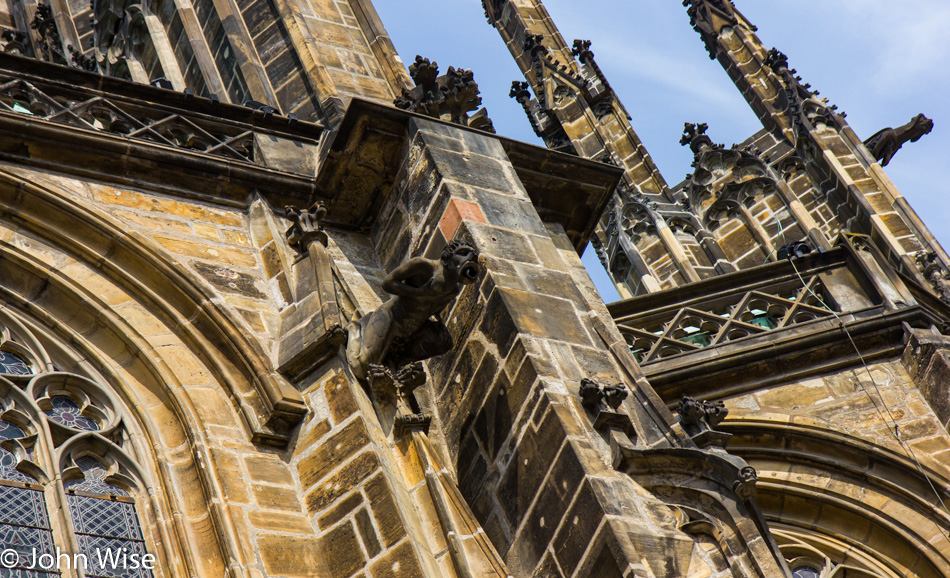
The Gothic Cathedral of St. Vitus is just as interesting to us as the baroque Church of St. Nicholas that we visited earlier, and no, I won’t use this as a transition to writing about the facade of religion. However, I should be careful about what I convey when I use the word facade. What I meant is, in some way, paraphrasing what Nietzsche said with the famous quote, “God is dead,” it is not that I see no need for a belief system relying on deities; it’s just the ugly corruption of so many people entrenched with organized religion whose livelihoods depend on subservience, fear, and outright ignorance. If God is alive in your heart, express that joy by doing what is right for your family, community, state, country, and Earth, but building monuments and affording people lavish lifestyles who claim to interpret God on your behalf is bullshit.
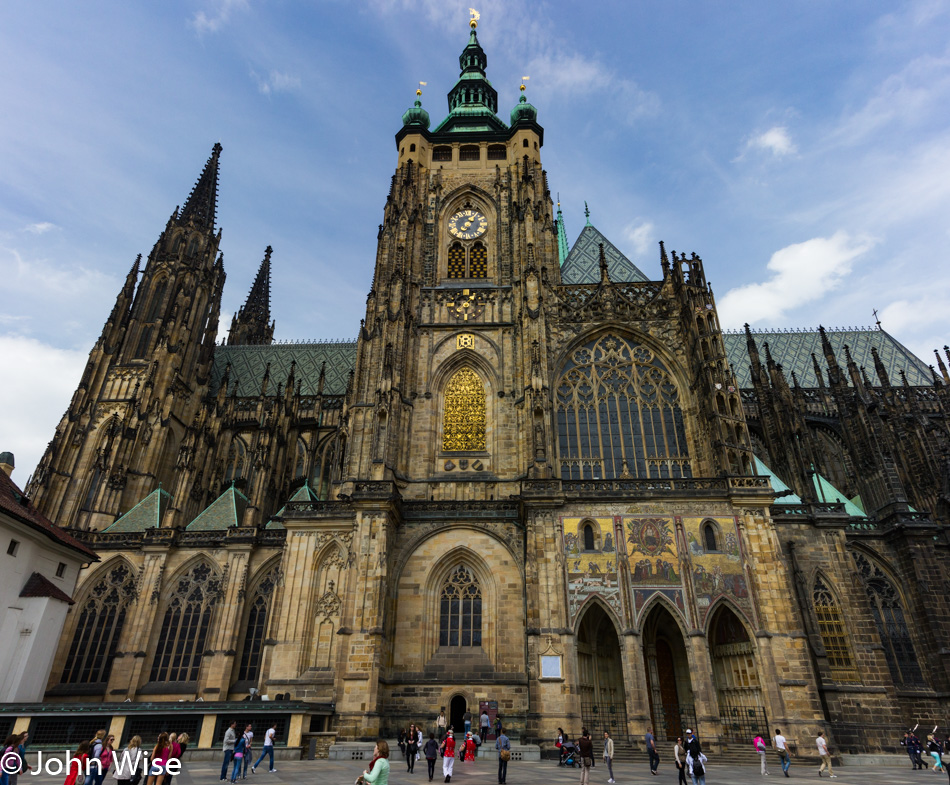
What a fine and beautiful cathedral sitting on a hill surrounded by a castle going on 700 years old. Wish I could say that of myself 650 years into the future.
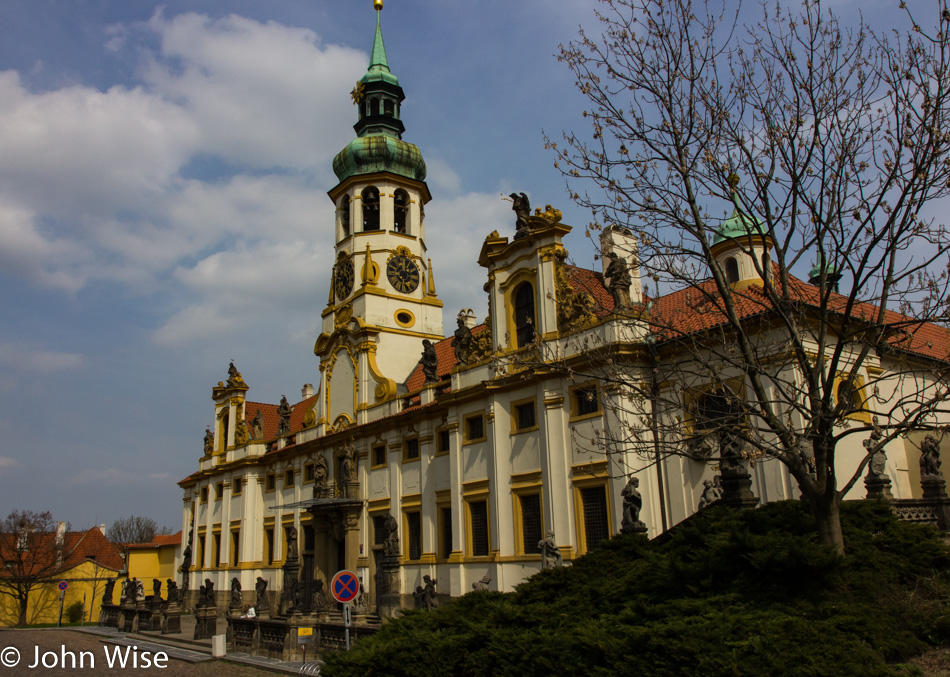
The Loreta Shrine is being marked here as a place we must return to. Truth is, we need to dedicate at least three full days here in Prague, anything less and we’ll feel cheated.
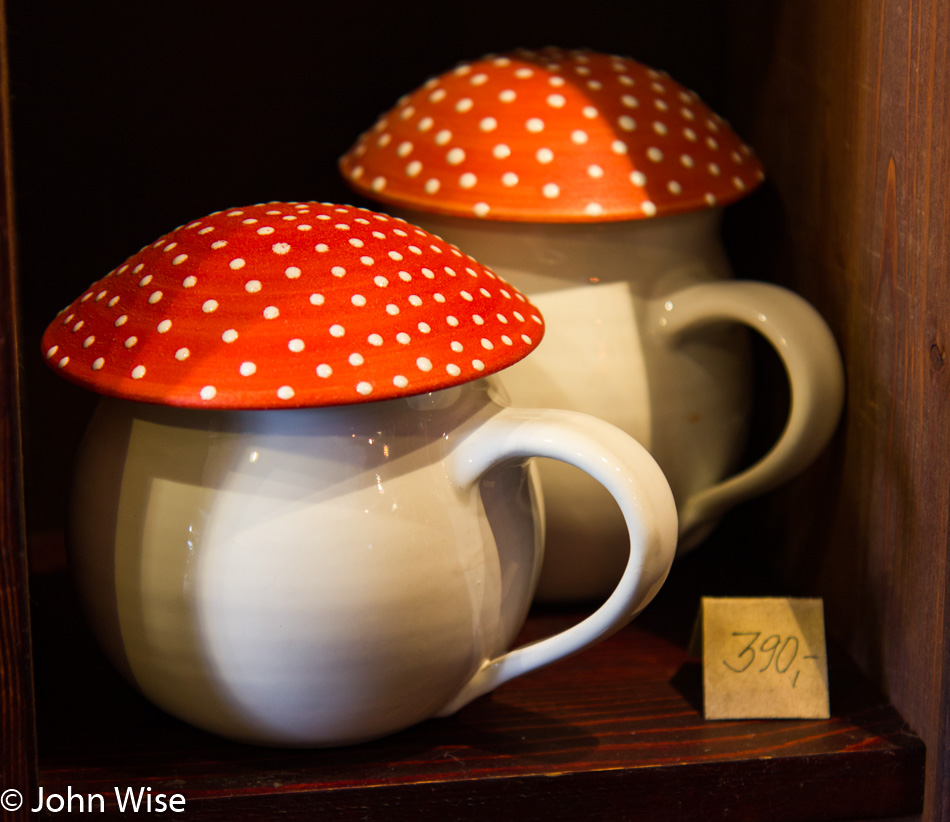
Before taking it from the shelf of the small shop we bought it at, here’s the tea cup Caroline knew she had to have as our reminder to return to this great city.
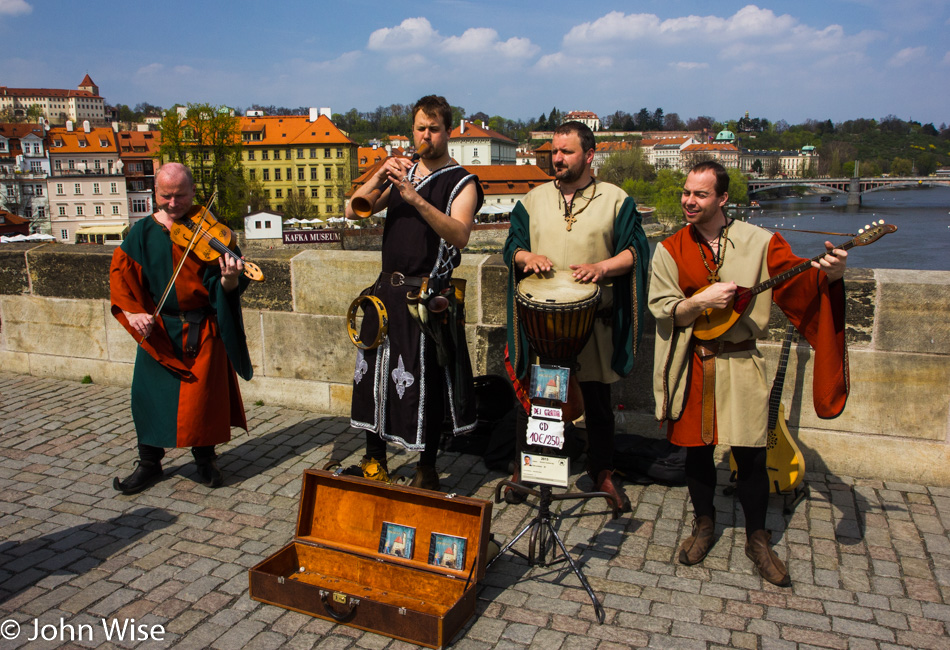
The group is called Dei Gratia, and now I wish we’d have thrown them the 10 Euros for the CD.
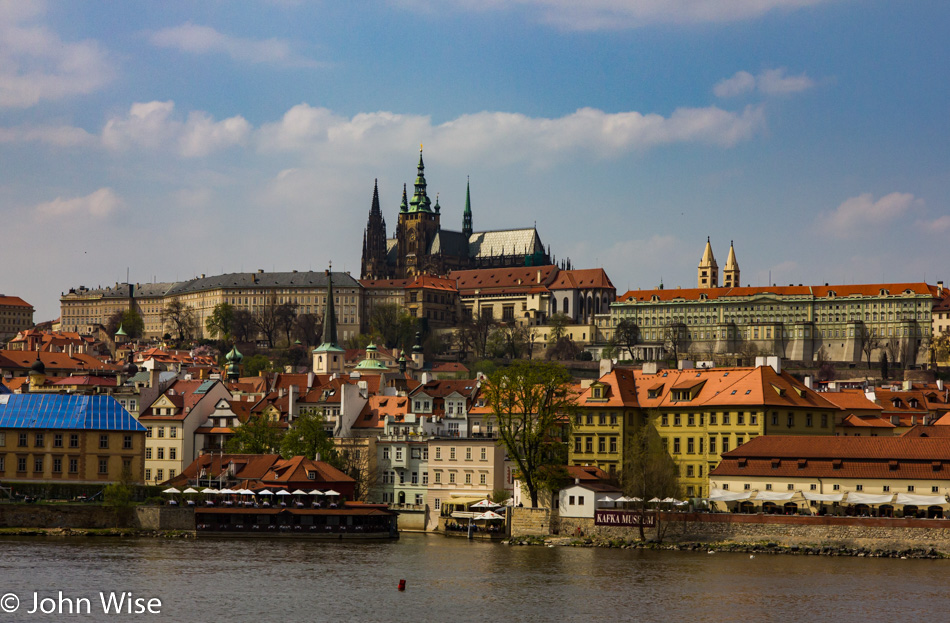
Prague Castle and St. Vitus Cathedral as seen from the Charles Bridge over the Vltava River. We are on our way out.
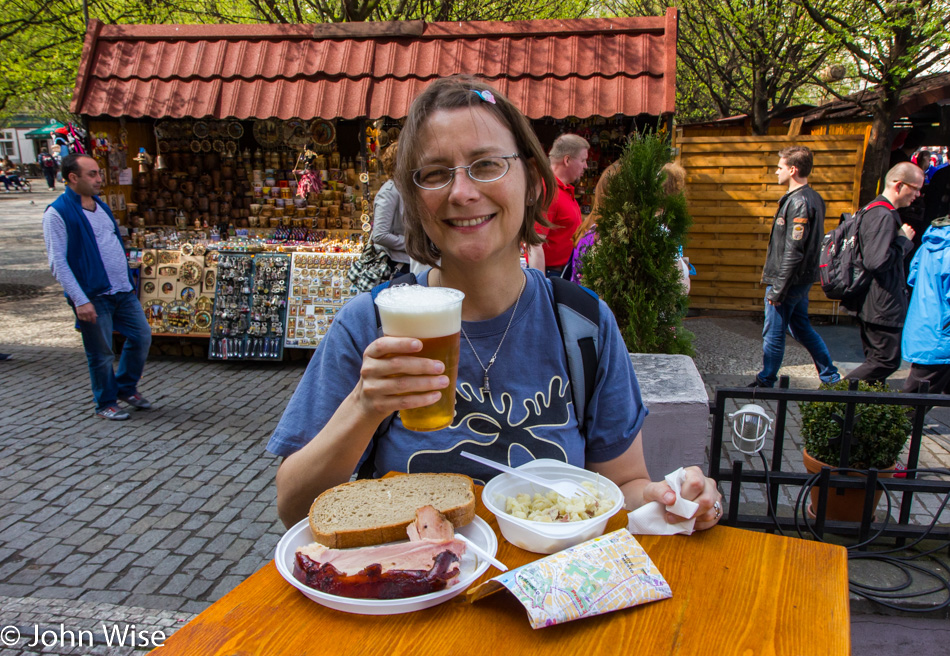
But first, some food and beer.
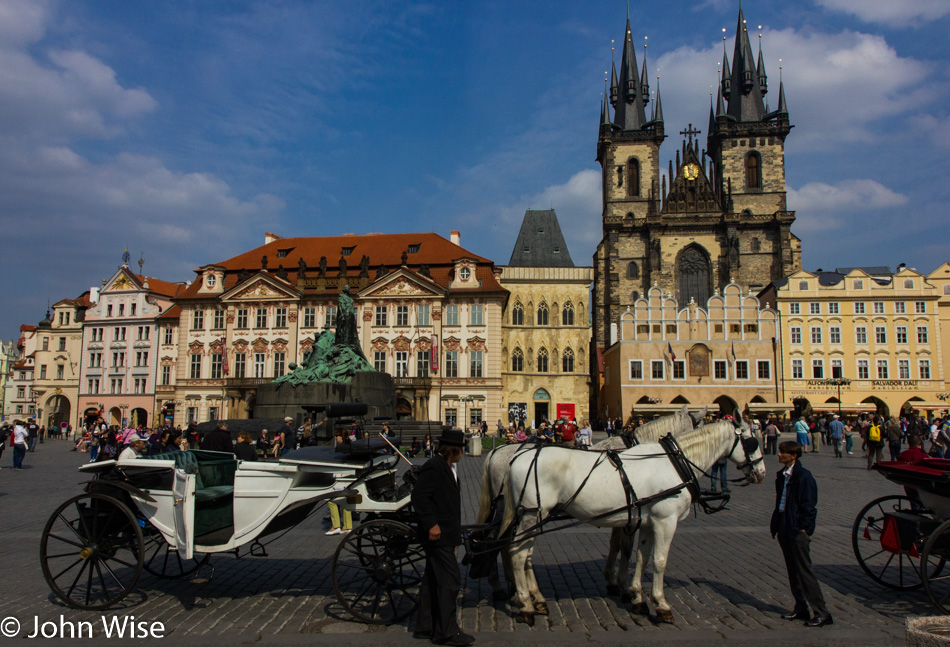
The guys brought up the car while Caroline finished her beer. Good day for a drive. I think you’d agree.
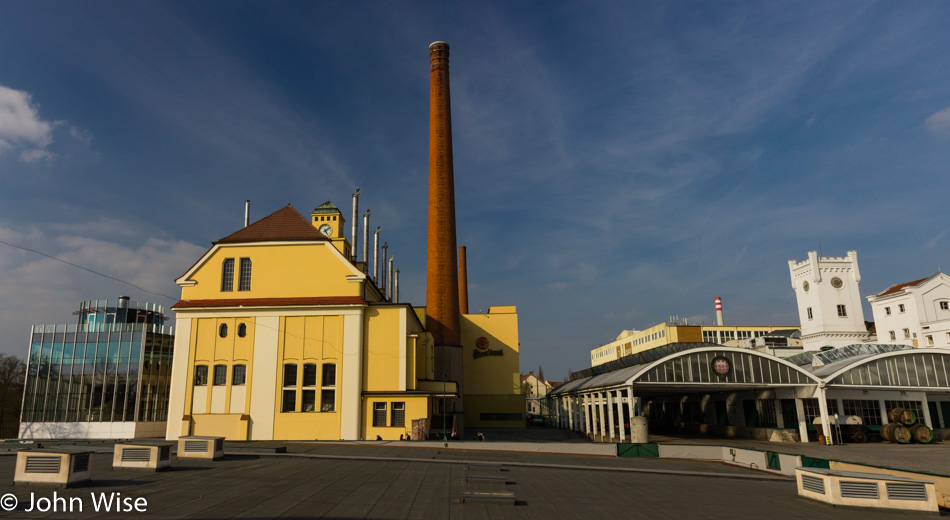
So, getting out of Prague when you don’t read the language, there’s nothing that looks slightly familiar and the signage is poor is a challenge. You just point the car west and try to maintain that general direction, figuring sooner or later you’ll find the main artery – we did. We had left Prague behind us and were well on our way to the German border when had one last stop. Neither of us saw this coming and were in a bit of disbelief when we saw it. The Pilsner Urquell Brewery in the town of Pilsen. Caroline tells me that she knew it all along and that it was obvious that “Pilsner” had to come from someplace by that name. I’d like to mock her and say, “Sure, but I don’t know of anyplace called Budweiser!” but I do know that the original called Budvar is from Budějovice here in the Czech Republic, so I can’t play that. Wow, we’re at the place that invented Pilsner.
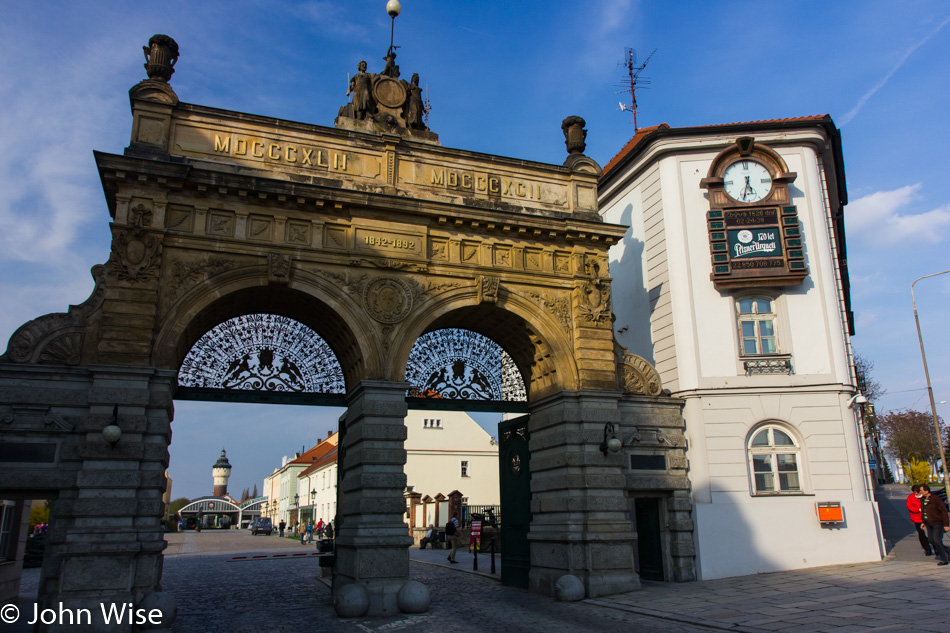
I wonder if we can get a beer here at 5:30 p.m. on a Tuesday? Sure enough, Caroline can anyway, you might remember that I don’t drink. In their drinking hall, a small Oom-pah-pah band was playing, which only added to the atmosphere. This was our introduction to the Czech Republic. The remaining few hours of the day were spent driving over to Rothenburg ob der Tauber, which we’ll visit tomorrow before heading back to Frankfurt.
